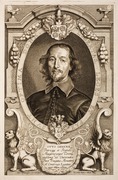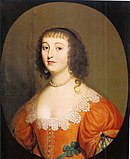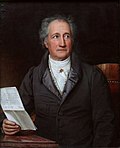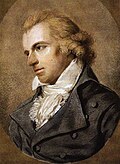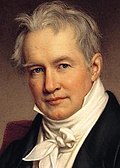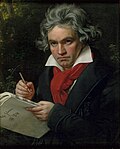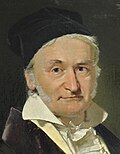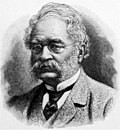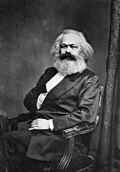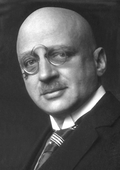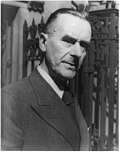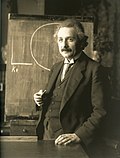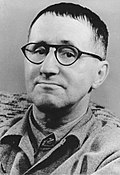History of Germany
This articlemay betoo longto read and navigate comfortably.When this tag was added, itsreadable prose sizewas 26,000 words.(May 2023) |
This articlecontains too many pictures for its overall length. |
| History ofGermany |
|---|
 |
The concept ofGermanyas a distinct region inCentral Europecan be traced toJulius Caesar,who referred to the unconquered area east of theRhineasGermania,thus distinguishing it fromGaul.The victory of theGermanic tribesin theBattle of the Teutoburg Forest(AD9) prevented annexation by theRoman Empire,although theRoman provincesofGermania SuperiorandGermania Inferiorwere established along theRhine.Following theFall of the Western Roman Empire,theFranksconquered the otherWestGermanic tribes.When theFrankish Empirewas divided amongCharles the Great's heirs in 843, the eastern part becameEast Francia.In 962,Otto Ibecame the firstHoly Roman Emperorof theHoly Roman Empire,the medieval German state.
During theHigh Middle Ages,theHanseatic League,dominated by German port cities, established itself along theBalticandNorth Seas.The growth of a crusading element within GermanChristendomled to theState of the Teutonic Orderalong the Baltic coast in what would later becomePrussia.In theInvestiture Controversy,the German Emperors resisted Catholic Church authority. In theLate Middle Ages,the regional dukes, princes, and bishops gained power at the expense of the emperors.Martin Lutherled theProtestant Reformationwithin the Catholic Church after 1517, as the northern and eastern states became Protestant, while most of the southern and western states remained Catholic. TheThirty Years' War,a civil war from 1618 to 1648 brought tremendous destruction to the Holy Roman Empire. The estates of the empire attained great autonomy in thePeace of Westphalia,the most important beingAustria,Prussia,BavariaandSaxony.With theNapoleonic Wars,feudalism fell away and the Holy Roman Empire was dissolved in 1806.Napoleonestablished theConfederation of the Rhineas a German puppet state, but after the French defeat, theGerman Confederationwas established under Austrian presidency. TheGerman revolutions of 1848–1849failed but theIndustrial Revolutionmodernized the German economy, leading to rapid urban growth and the emergence of thesocialist movement.Prussia, with its capitalBerlin,grew in power. German universities became world-class centers for science and humanities, while music and art flourished. Theunification of Germanywas achieved under the leadership of the ChancellorOtto von Bismarckwith the formation of theGerman Empirein 1871. The newReichstag,an elected parliament, had only a limited role in the imperial government. Germany joined the other powers incolonial expansion in Africa and the Pacific.
By 1900, Germany was the dominant power on the European continent and its rapidly expanding industry had surpassedBritain's while provoking it ina naval arms race.Germany led theCentral PowersinWorld War I,but was defeated, partly occupied, forced to paywar reparations,and stripped of its colonies and significant territory along its borders. TheGerman Revolution of 1918–1919ended the German Empire with the abdication ofWilhelm IIin 1918 and established theWeimar Republic,an ultimately unstable parliamentary democracy. In January 1933,Adolf Hitler,leader of theNazi Party,used the economic hardships of theGreat Depressionalong with popular resentment over the terms imposed on Germany at the end of World War I to establish atotalitarianregime. ThisNazi Germanymade racism, especiallyantisemitism,a central tenet of its policies, and became increasingly aggressive with its territorial demands, threatening war if they were not met. Germany quickly remilitarized, annexed its German-speaking neighbors andinvaded Poland,triggeringWorld War II.During the war, the Nazis established a systematicgenocideprogram known asthe Holocaustwhich killed 17 million people, including 6 million Jews (representing 2/3rds of the European Jewish population). By 1944, the German Army was pushed back on all fronts until finally collapsing in May 1945. Underoccupation by the Allies,denazificationefforts took place, large populations under former German-occupied territories were displaced, German territories were split up by the victorious powers and in the east annexed by Poland and the Soviet Union. Germany spent the entirety of theCold Warera divided into theNATO-alignedWest GermanyandWarsaw Pact-alignedEast Germany.Germans also fled from Communist areas into West Germany, which experienced rapideconomic expansion,and became the dominant economy in Western Europe.
In 1989, theBerlin Wallwasopened,theEastern Bloccollapsed, andEast and West Germany were reunitedin 1990. TheFranco-German friendshipbecame the basis for the political integration of Western Europe in theEuropean Union.In 1998–1999, Germany was one of the founding countries of theeurozone.Germany remains one of the economic powerhouses of Europe, contributing about 1/4 of the eurozone's annualgross domestic product.In the early 2010s, Germany played a critical role in trying to resolve the escalating euro crisis, especially concerning Greece and otherSouthern Europeannations. In 2015, Germany faced theEuropean migrant crisisas the main receiver of asylum seekers fromSyriaand other troubled regions. Germany opposedRussia's 2022 invasion of Ukraineand decided to strengthenits armed forces.
Prehistory
[edit]Paleolithic and Neolithic ages
[edit]Pre-human apes such asDanuvius guggenmosi,who were present in Germany over 11 million years ago, are theorized to be among the earliest apes to walk on two legs prior to other species and genera such asAustralopithecus.[1]The discovery of theHomo heidelbergensismandible in 1907 affirms archaic human presence in Germany by at least 600,000 years ago,[2]so stone tools were dated as far back as 1.33 million years ago.[3]The oldest complete set of hunting weapons ever found anywhere in the world was excavated from a coal mine inSchöningen,Lower Saxony.Between 1994 and 1998,eight 380,000-year-old wooden javelinsbetween 1.82 and 2.25 m (5.97 and 7.38 ft) in length were eventually unearthed.[4][5] One of the oldest buildings in the world and one of the oldest pieces of art was found inBilzingsleben.[6]
In 1856, the fossilized bones of an extinct human species were salvaged from a limestone grotto in theNeandervalley nearDüsseldorf,North Rhine-Westphalia.The archaic nature of the fossils, now known to be around 40,000 years old, was recognized and the characteristics published in the first-everpaleoanthropologicspecies descriptionin 1858 byHermann Schaaffhausen.[7]The species was namedHomo neanderthalensis,Neanderthalman in 1864.
The oldest traces ofhomo sapiensin Germany were found in the caveIlsenhöhleinRanis,where up to 47,500-year-old remains were discovered, among the oldest in Europe.[8]The remains ofPaleolithicearly modern humanoccupation uncovered and documented in several caves in theSwabian Jurainclude various mammoth ivory sculptures that rank among the oldest uncontested works of art and several flutes, made of bird bone and mammoth ivory that are confirmed to be the oldest musical instruments ever found. The 41,000-year-oldLöwenmensch figurinerepresents the oldest uncontested figurative work of art and the 40,000-year-oldVenus of Hohle Felshas been asserted as the oldest uncontested object of human figurative art ever discovered.[9][10][11][12]These artefacts are attributed to theAurignacianculture.
Between 12,900 and 11,700 years ago, north-central Germany was part of theAhrensburg culture(named forAhrensburg).

The first groups of early farmers different from the indigenous hunter-gatherers to migrate into Europe came from a population in westernAnatoliaat the beginning of theNeolithicperiod between 10,000 and 8,000 years ago.[13]
Central Germany was one of the primary areas of theLinear Pottery culture(c. 5500 BC– c. 4500 BC), which was partially contemporary with theErtebølle culture(c. 5300 BC– c. 3950 BC) of Denmark and northern Germany. The construction of the Central EuropeanNeolithic circular enclosuresfalls in this time period with the best known and oldest being theGoseck circle,constructedc. 4900 BC.Afterwards, Germany was part of theRössen culture,Michelsberg cultureandFunnelbeaker culture(c. 4600 BC– c. 2800 BC). The oldest traces for the use of wheel and wagon ever found are located at a northern German Funnelbeaker culture site and date to around 3400 BC.[14]
Bronze Age
[edit]The settlers of theCorded Ware culture(c. 2900 BC– c. 2350 BC), that had spread all over the fertile plains of Central Europe during the Late Neolithic were ofIndo-Europeanancestry. The Indo-Europeans had, via mass-migration, arrived into the heartland of Europe around 4,500 years ago.[16]
By the lateBronze Age,theUrnfield culture(c. 1300 BC– c. 750 BC) had replaced theBell Beaker,UneticeandTumulus culturesin central Europe,[17]whilst theNordic Bronze Agehad developed in Scandinavia and northern Germany. The name comes from the custom ofcrematingthe dead and placing their ashes inurns,which were then buried in fields. The first usage of the name occurred in publications over grave sites in southern Germany in the late 19th century.[18][19]Over much of Europe, the Urnfield culture followed theTumulus cultureand was succeeded by theHallstatt culture.[20]TheItalic peoples,including theLatins,from which theRomansemerged, come from the Urnfield culture of central Europe.[21][22][23]
Iron Age
[edit]TheHallstatt culture,which had developed from the Urnfield culture, was the predominant Western and Central European culture from the 12th to 8th centuries BC and during the earlyIron Age(8th to 6th centuries BC). It was followed by theLa Tène culture(5th to 1st centuries BC).
The people who had adopted these cultural characteristics in central and southern Germany are regarded asCelts.How and if the Celts are related to the Urnfield culture remains disputed. However, Celtic cultural centres developed in central Europe during the late Bronze Age (c. 1200 BCuntil 700 BC). Some, like theHeuneburg,the oldest city north of the Alps,[24]grew to become important cultural centres of the Iron Age in Central Europe, that maintained trade routes to theMediterranean.In the 5th century BC the Greek historianHerodotusmentioned a Celtic city at the Danube –Pyrene,that historians attribute to the Heuneburg. Beginning around 700 BC (or later),Germanic peoples(Germanic tribes) fromsouthern Scandinavia and northern Germanyexpanded south and gradually replaced the Celtic peoples in Central Europe.[25][26][27][28][29][30]
Early history: Germanic tribes, Roman conquests, and the Migration Period
[edit]Early migrations, the Suebi and the Roman Republic
[edit]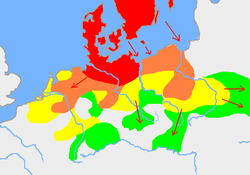
Theethnogenesisof theGermanic tribesremains debated. However, for authorAveril Cameron"it is obvious that a steady process" occurred during theNordic Bronze Age,or at the latest during thePre-Roman Iron Age[33](Jastorf culture). From their homes in southern Scandinavia and northern Germany the tribes began expanding south, east and west during the 1st century BC,[34]and came into contact with theCeltictribes ofGaul,as well as withIranic,[35]Baltic,[36]andSlaviccultures inCentral/Eastern Europe.[37]
Factual and detailed knowledge about the early history of the Germanic tribes is rare. Researchers have to be content with the recordings of the tribes' affairs with theRomans,linguistic conclusions, archaeological discoveries and the rather new yet auspicious results ofarchaeogeneticstudy.[38]In the mid-1st century BC,Republican RomanstatesmanJulius Caesarerected thefirst known bridges across the Rhineduring hiscampaign in Gauland led a military contingent across and into the territories of the local Germanic tribes. After several days and having made no contact with Germanic troops (who had retreated inland) Caesar returned to the west of the river.[39]By 60 BC, theSuebitribe under chieftainAriovistus,had conquered lands of the GallicAeduitribe to the west of the Rhine. Consequent plans to populate the region with Germanic settlers from the east were vehemently opposed by Caesar, who had already launched hisambitious campaignto subjugate all Gaul. Julius Caesar defeated the Suebi forces in 58 BC in theBattle of Vosgesand forced Ariovistus to retreat across the Rhine.[40][41]
Roman settlement of the Rhine
[edit]
Augustus,firstRoman emperor,considered conquest beyond theRhineand theDanubenot only regular foreign policy but also necessary to counter Germanic incursions into a still rebellious Gaul. Forts and commercial centers were established along the rivers. Some tribes, such as theUbiiconsequently allied with Rome and readily adopted advanced Roman culture. During the 1st century CE Roman legions conducted extended campaigns intoGermania magna,the area north of the Upper Danube and east of the Rhine, attempting to subdue the various tribes. Roman ideas of administration, the imposition of taxes and a legal framework were frustrated by the total absence of an infrastructure.Germanicus'scampaigns,for example, were almost exclusively characterized by frequent massacres of villagers and indiscriminate pillaging. The tribes, however maintained their elusive identities. A coalition of tribes under theCheruscichieftainArminius,who was familiar with Roman tactical doctrines, defeated a large Roman force in theBattle of the Teutoburg Forest.Consequently, Rome resolved to permanently establish the Rhine/Danube border and refrain from further territorial advance into Germania.[42][43]By AD 100 the frontier along the Rhine and the Danube and theLimes Germanicuswas firmly established. Several Germanic tribes lived under Roman rule south and west of the border, as described inTacitus'sGermania.Austria formed the regular provinces ofNoricumandRaetia.[44][45][46]The provincesGermania Inferior(with the capital situated atColonia Claudia Ara Agrippinensium,modernCologne) andGermania Superior(with its capital atMogontiacum,modernMainz), were formally established in 85 AD, after long campaigns as lasting military control was confined to the lands surrounding the rivers.[47]Christianity was introducedto Roman controlled western Germania before the Middle Ages, with Christian religious structures such as theAula PalatinaofTrierbuilt during the reign ofConstantine I(r. 306–337).[48]
Migration Period and decline of the Western Roman Empire
[edit]Rome'sThird Century Crisiscoincided with the emergence of a number of large West Germanic tribes: theAlamanni,Franks,Bavarii,Chatti,Saxons,Frisii,Sicambri,andThuringii.By the 3rd century the Germanic speaking peoples began to migrate beyond thelimesand the Danube frontier.[49]Several large tribes – theVisigoths,Ostrogoths,Vandals,Burgundians,Lombards,SaxonsandFranks– migrated and played their part in thedecline of the Roman Empireand the transformation of the oldWestern Roman Empire.[50]By the end of the 4th century theHunsinvaded eastern and central Europe, establishing theHunnic Empire.The event triggered theMigration Period.[51]Hunnic hegemony over a vast territory in central and eastern Europe lasted until the death ofAttila's sonDengizichin 469.[52]Another pivotal moment in the Migration Period was theCrossing of the Rhinein December of 406 by a large group of tribes includingVandals,AlansandSuebiwho settled permanently within the crumbling Western Roman Empire.[53]
Stem duchies and marches
[edit]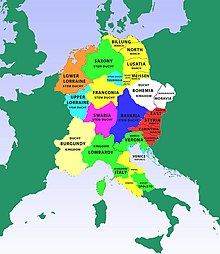
Stem duchies(‹See Tfd›German:Stammesherzogtümer) in Germany refer to the traditional territory of the various Germanic tribes. The concept of such duchies survived especially in the areas which by the 9th century would constituteEast Francia,[54]which included theDuchy of Bavaria,theDuchy of Swabia,theDuchy of Saxony,theDuchy of Franconiaand theDuchy of Thuringia,[55]unlike further west theCounty of BurgundyorLorraineinMiddle Francia.[56] [57]
TheSalian emperors(reigned 1027–1125) retained the stem duchies as the major divisions of Germany, but they became increasingly obsolete during the early high-medieval period under theHohenstaufen,andFrederick Barbarossafinally abolished them in 1180 in favour of more numerous territorial duchies.
Successive kings of Germany founded a series of border counties ormarchesin the east and the north. These includedLusatia,theNorth March(which would becomeBrandenburgand the heart of the futurePrussia), and theBillung March.In the south, the marches includedCarniola,Styria,and theMarch of Austriathat would becomeAustria.
Middle Ages
[edit]Frankish Empire
[edit]The Western Roman Empire fell in 476 with thedeposition of Romulus Augustusby the GermanicfoederatileaderOdoacer,who became the firstKing of Italy.[58]Afterwards, the Franks, like other post-Roman Western Europeans, emerged as a tribal confederacy in the Middle Rhine-Weser region, among the territory soon to be calledAustrasia(the "eastern land" ), the northeastern portion of the future Kingdom of theMerovingianFranks.As a whole, Austrasia comprised parts of present-dayFrance,Germany,Belgium,Luxembourgand theNetherlands.Unlike theAlamannito their south inSwabia,they absorbed large swaths of former Roman territory as they spread west intoGaul,beginning in 250.Clovis Iof theMerovingian dynastyconquered northern Gaul in 486 and in theBattle of Tolbiacin 496 theAlemannitribe inSwabia,which eventually became theDuchy of Swabia.
By 500, Clovis had united all the Frankish tribes, ruled all of Gaul[59]and was proclaimedKing of the Franksbetween 509 and 511.[60]Clovis, unlike most Germanic rulers of the time, was baptized directly intoRoman Catholicisminstead ofArianism.His successors would cooperate closely withpapalmissionaries, among themSaint Boniface.After the death of Clovis in 511, his four sons partitioned his kingdom includingAustrasia.Authority over Austrasia passed back and forth from autonomy to royal subjugation, as successiveMerovingiankings alternately united and subdivided the Frankish lands.[61]
During the 5th and 6th centuries the Merovingian kings conquered theThuringii(531 to 532), theKingdom of the Burgundiansand the principality of Metz and defeated the Danes, the Saxons and the Visigoths.[62]KingChlothar I(558 to 561) ruled the greater part of what is now Germany and undertook military expeditions intoSaxony,while the South-east of what is modern Germany remained under the influence of theOstrogoths.Saxons controlled the area from the northern sea board to theHarz Mountainsand theEichsfeldin the south.[63]

Blue = realm ofPepin the Shortin 758;
Orange = expansion underCharlemagneuntil 814;
Yellow =Marchesand dependencies;
Red =Papal States.
The Merovingians placed the various regions of their Frankish Empire under the control of semi-autonomous dukes – either Franks or local rulers,[64]and followedimperial Romanstrategic traditions of social and political integration of the newly conquered territories.[65][66]While allowed to preserve their own legal systems,[67]the conquered Germanic tribes were pressured to abandon theArianChristian faith.[68]
In 718Charles Martelwaged war against the Saxons in support of theNeustrians.In 743 his sonCarlomanin his role asMayor of the Palacerenewed the war against the Saxons, who had allied with and aided the dukeOdilo of Bavaria.[69]The Catholic Franks, who by 750 controlled avast territoryin Gaul, north-western Germany, Swabia,Burgundyand westernSwitzerland,that included thealpinepasses allied with the Curia inRomeagainst theLombards,who posed a permanent threat to the Holy See.[59]Pressed byLiutprand, King of the Lombards,a Papal envoy for help had already been sent to the de facto rulerCharles Martelafter his victory in 732 over the forces of the Umayyad Caliphate at theBattle of Tours,however a lasting and mutually beneficial alliance would only materialize after Charles' death under his successor Duke of the Franks, Pepin the Short.[70]
In 751Pippin III,Mayor of the Palaceunder the Merovingian king, himself assumed the title of king and was anointed by the Church.Pope Stephen IIbestowed him the hereditary title ofPatricius Romanorumas protector of Rome and St. Peter[71]in response to theDonation of Pepin,that guaranteed the sovereignty of thePapal States.Charles the Great(who ruled the Franks from 774 to 814) launched a decades-long military campaign against the Franks' heathen rivals, theSaxonsand theAvars.The campaigns and insurrections of theSaxon Warslasted from 772 to 804. The Franks eventually overwhelmed the Saxons and Avars, forcibly converted the people toChristianity,and annexed their lands to theCarolingian Empire.
Foundation of the Holy Roman Empire
[edit]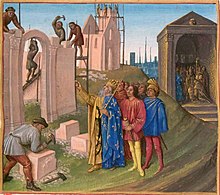
After the death of Frankish kingPepin the Shortin 768, his oldest son "Charlemagne"(" Charles the Great ") consolidated his power over and expanded theKingdom.Charlemagne ended 200 years of Royal Lombard rule with theSiege of Pavia,and in 774 he installed himself asKing of the Lombards.Loyal Frankish nobles replaced the old Lombard aristocracy following a rebellion in 776.[72]The next 30 years of his reign were spent ruthlessly strengthening his power in Francia and on the conquest of the Slavs andPannonian Avarsin the east and alltribes,such as theSaxonsand theBavarians.[73][74]OnChristmas Day,800 AD, Charlemagne was crownedImperator Romanorum(Emperor of the Romans) in Rome byPope Leo III.[74]
Fighting among Charlemagne's three grandsons over the continuation of the custom ofpartible inheritanceor the introduction ofprimogeniturecaused the Carolingian empire to be partitioned into three parts by theTreaty of Verdunof 843.[75]Louis the Germanreceived the Eastern portion of the kingdom,East Francia,all lands east of the Rhine river and to the north of Italy. This encompassed the territories of the Germanstem duchies– Franks, Saxons,Swabians,and Bavarians – that were united in a federation under the first non-Frankish kingHenry the Fowler,who ruled from 919 to 936.[76]The royal court permanently moved in between a series of strongholds, calledKaiserpfalzen,that developed into economic and cultural centers.Aachen Palaceplayed a central role, as the localPalatine Chapelserved as the official site for all royal coronation ceremonies during the entire Medieval period until 1531.[74][77]
-
The division of theCarolingian Empireby theTreaty of Verdunin 843
-
Territorial evolution of theHoly Roman Empirefrom 962 to 1806
-
TheHoly Roman Empireat its greatest territorial extent underHohenstaufenemperorFrederick II,13th century
-
TheHoly Roman Empirearound the year 1700
Otto the Great
[edit]
In 936,Otto Iwas crowned German king atAachen,in 961King of ItalyinPaviaand crowned emperor byPope John XIIinRomein 962. The tradition of the German King as protector of the Kingdom of Italy and the Latin Church resulted in the termHoly Roman Empirein the 12th century. The name, that was to identify with Germany continued to be used officially, with the extension added:Nationis Germanicæ (of the German nation)after the last imperial coronation in Rome in 1452 until its dissolution in 1806.[76]Otto strengthened the royal authority by re-asserting the oldCarolingianrights over ecclesiastical appointments.[78]Otto wrested from the nobles the powers of appointment of the bishops and abbots, who controlled large land holdings. Additionally, Otto revived the old Carolingian program of appointing missionaries in the border lands. Otto continued to supportcelibacyfor the higher clergy, so ecclesiastical appointments never became hereditary. By granting lands to the abbots and bishops he appointed, Otto actually turned these bishops into "princes of the Empire" (Reichsfürsten).[79]In this way, Otto was able to establish a national church. Outside threats to the kingdom were contained with the decisive defeat of the HungarianMagyarsat theBattle of Lechfeldin 955. TheSlavsbetween theElbeand theOderrivers were also subjugated. Otto marched on Rome and droveJohn XIIfrom the papal throne and for years controlled the election of the pope, setting a firm precedent for imperial control of the papacy for years to come.[80][81]
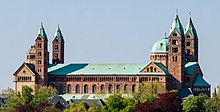

During the reign of Conrad II's son,Henry III(1039 to 1056), the empire supported theCluniac reformsof the Church, thePeace of God,prohibition ofsimony(the purchase of clerical offices), and requiredcelibacyof priests. Imperial authority over the Pope reached its peak. However, Rome reacted with the creation of theCollege of CardinalsandPope Gregory VII'sseries of clerical reforms.Pope Gregory insisted in hisDictatus Papaeon absolute papal authority over appointments to ecclesiastical offices. The subsequent conflict in which emperorHenry IVwas compelled to submit to the Pope atCanossain 1077, after having been excommunicated came to be known as theInvestiture Controversy.In 1122, a temporary reconciliation was reached betweenHenry Vand the Pope with theConcordat of Worms.With the conclusion of the dispute the Roman church and the papacy regained supreme control over all religious affairs.[83][84]Consequently, the imperial Ottonian church system (Reichskirche) declined. It also ended the royal/imperial tradition of appointing selected powerful clerical leaders to counter the Imperial secular princes.[85]
Between 1095 and 1291 the various campaigns of thecrusadesto the Holy Land took place. Knightly religious orders were established, including theKnights Templar,the Knights of St John (Knights Hospitaller), and theTeutonic Order.[86][87]
The termsacrum imperium(Holy Empire) was first used officially byFriedrich Iin 1157,[88]but the wordsSacrum Romanum Imperium,Holy Roman Empire, were only combined in July 1180 and would never consistently appear on official documents from 1254 onwards.[89]
Hanseatic League
[edit]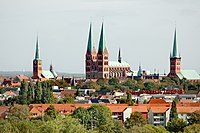
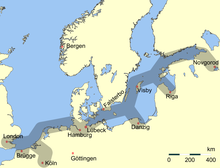
TheHanseatic Leaguewas a commercial and defensive alliance of the merchantguildsof towns and cities in northern and central Europe that dominated marine trade in theBaltic Sea,theNorth Seaand along the connected navigable rivers during the Late Middle Ages ( 12th to 15th centuries ). Each of the affiliated cities retained the legal system of its sovereign and, with the exception of theFree imperial cities,had only a limited degree of political autonomy.[90]Beginning with an agreement of the cities ofLübeckandHamburg,guilds cooperated in order to strengthen and combine their economic assets, like securing trading routes and tax privileges, to control prices and better protect and market their local commodities. Important centers of commerce within the empire, such asCologneon theRhineriver andBremenon theNorth Seajoined the union, which resulted in greater diplomatic esteem.[91]Recognized by the various regional princes for the great economic potential, favorable charters for, often exclusive, commercial operations were granted.[92]During its zenith the alliance maintained trading posts andkontorsin virtually all cities betweenLondonandEdinburghin the west toNovgorodin the east andBergenin Norway. By the late 14th century the powerful league enforced its interests with military means, if necessary. This culminated ina warwith the sovereign Kingdom of Denmark from 1361 to 1370. Principal city of the Hanseatic League remained Lübeck, where in 1356 the first general diet was held and its official structure was announced. The league declined after 1450 due to a number of factors, such as the15th-century crisis,the territorial lords' shifting policies towards greater commercial control, thesilver crisisand marginalization in the wider Eurasian trade network, among others.[93][94]
Eastward expansion
[edit]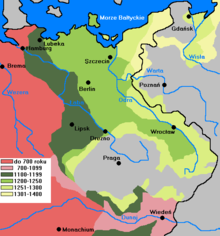

TheOstsiedlung(lit. Eastern settlement) is the term for a process of largely uncoordinated immigration and chartering of settlement structures by ethnic Germans into territories, already inhabited bySlavsandBaltseast of theSaaleandElberivers, such as modern Poland andSilesiaand to the south intoBohemia,modern Hungary and Romania during theHigh Middle Agesfrom the 11th to the 14th century.[95][96]The primary purpose of the early imperial military campaigns into the lands to the east during the 10th and 11th century, was to punish and subjugate the localheathentribes. Conquered territories were mostly lost after the troops had retreated, but eventually were incorporated into the empire asmarches,fortified borderlands with garrisoned troops in strongholds and castles, who were to ensure military control and enforce the exaction of tributes. Contemporary sources do not support the idea of policies or plans for the organized settlement of civilians.[97]
Emperor Lothair IIre-established feudal sovereignty over Poland, Denmark and Bohemia from 1135 and appointedmargravesto turn the borderlands into hereditaryfiefsand install a civilian administration. There is no discernible chronology of the immigration process as it took place in many individual efforts and stages, often even encouraged by the Slavic regional lords. However, the new communities were subjected to German law and customs. Total numbers of settlers were generally rather low and, depending on who held a numerical majority, populations usually assimilated into each other. In many regions only enclaves would persist, likeHermannstadt,founded by theTransylvanian Saxonsin the medieval Hungarian Kingdom (today in Romania) who were called on byGeza IIto repopulate the area as part of theOstsiedlung,having arrived there and founding the city in 1147 [Saxons called these parts of Transylvania "Altland" to distinguish them from later immigrant Saxon settlements established in about 1220 by the Teutonic Order].[98][99]
In 1230, the Catholicmonasticorder of theTeutonic Knightslaunched thePrussian Crusade.The campaign, that was supported by the forces of Polish dukeKonrad I of Masovia,initially intended to Christianize the BalticOld Prussians,succeeded primarily in the conquest of large territories. The order, emboldened byimperial approval,quickly resolved to establish an independentstate,without the consent of duke Konrad. Recognizing only papal authority and based on a solid economy, the order steadily expanded the Teutonic state during the following 150 years, engaging in several land disputes with its neighbors. Permanent conflicts with theKingdom of Poland,theGrand Duchy of Lithuania,and theNovgorod Republic,eventually led tomilitary defeatand containment by the mid-15th century. The lastGrand MasterAlbert of Brandenburgconverted toLutheranismin 1525 and turned the remaining lands of the order into the secularDuchy of Prussia.[100][101]
Church and state
[edit]

left to right:Archbishop of Cologne,Archbishop of Mainz,Archbishop of Trier,Count Palatine,Duke of Saxony,Margrave of BrandenburgandKing of Bohemia(Codex Balduini Trevirorum,c. 1340)
Henry V,great-grandson of Conrad II, who had overthrown his fatherHenry IVbecameHoly Roman Emperorin 1111. Hoping to gain greater control over the church inside the Empire, Henry V appointedAdalbert of Saarbrückenas the powerfularchbishop of Mainzin the same year. Adalbert began to assert the powers of the Church against secular authorities, that is, the Emperor. This precipitated the "Crisis of 1111" as yet another chapter of the long-termInvestiture Controversy.[102]In 1137, the prince-electors turned back to theHohenstaufenfamily for a candidate,Conrad III.Conrad tried to divest his rivalHenry the Proudof his two duchies—BavariaandSaxony—that led to war in southern Germany as the empire was divided into two powerful factions. The faction of theWelfsorGuelphs(in Italian) supported theHouse of Welfof Henry the Proud, which was the ruling dynasty in the Duchy of Bavaria. The rival faction of theWaiblingsorGhibellines(in Italian) pledged allegiance to theSwabianHouse of Hohenstaufen. During this early period, the Welfs generally maintained ecclesiastical independence under the papacy andpolitical particularism(the focus on ducal interests against the central imperial authority). The Waiblings, on the other hand, championed strict control of the church and a strong central imperial government.[103]
During the reign of theHohenstaufenemperorFrederick I(Barbarossa), an accommodation was reached in 1156 between the two factions. The Duchy of Bavaria was returned to Henry the Proud's sonHenry the Lion,duke ofSaxony,who represented theGuelphparty. However, theMargraviate of Austriawas separated from Bavaria and turned into the independentDuchy of Austriaby virtue of thePrivilegium Minusin 1156.[104]
Having become wealthy through trade, the confident cities of Northern Italy, supported by the Pope, increasingly opposed Barbarossa's claim of feudal rule(Honor Imperii)over Italy. The cities united in theLombard Leagueand finally defeated Barbarossa in theBattle of Legnanoin 1176. The following year a reconciliation was reached between the emperor andPope Alexander IIIin theTreaty of Venice.[105]The 1183Peace of Constanceeventually settled that the Italian cities remained loyal to the empire but were granted local jurisdiction and fullregal rightsin their territories.[106]
In 1180, Henry the Lion was outlawed, Saxony was divided, and Bavaria was given toOtto of Wittelsbach,who founded theWittelsbach dynasty,which was to rule Bavaria until 1918.
From 1184 to 1186, the empire underFrederick I Barbarossareached its cultural peak with theDiet of Pentecostheld atMainzand the marriage of his sonHenryin Milan to theNormanprincessConstance of Sicily.[107]The power of the feudal lords was undermined by the appointment ofministerials(unfree servants of the Emperor) as officials. Chivalry and the court life flowered, as expressed in the scholastic philosophy ofAlbertus Magnusand the literature ofWolfram von Eschenbach.[108]
Between 1212 and 1250,Frederick IIestablished a modern, professionally administered state from his base inSicily.He resumed the conquest of Italy, leading to further conflict with thePapacy.In the Empire, extensive sovereign powers were granted to ecclesiastical and secular princes, leading to the rise of independent territorial states. The struggle with the Pope sapped the Empire's strength, as Frederick II was excommunicated three times. After his death, the Hohenstaufen dynasty fell, followed by aninterregnumduring which there was no Emperor (1250–1273). This interregnum came to an end with the election of a small Swabian count, Rudolf of Habsburg, as emperor.[109][110]
The failure of negotiations between EmperorLouis IVand the papacy led to the 1338Declaration at Rhenseby six princes of theImperial Estateto the effect that election by all or the majority of the electors automatically conferred the royal title and rule over the empire, without papal confirmation. As result, the monarch was no longer subject to papal approbation and became increasingly dependent on the favour of the electors. Between 1346 and 1378Emperor Charles IVofLuxembourg,king of Bohemia, sought to restore imperial authority. The 1356 decree of theGolden Bullstipulated that all future emperors were to be chosen by a college of onlyseven– four secular and three clerical – electors. The secular electors were the King of Bohemia, theCount Palatineof the Rhine, the Duke ofSaxony,and the Margrave ofBrandenburg,the clerical electors were the Archbishops ofMainz,Trier,andCologne.[111]
Between 1347 and 1351 Germany and almost the entire European continent were consumed by the most severe outbreak of theBlack Deathpandemic.Estimated to have caused the abrupt death of 30 to 60% of Europe's population, it led to widespread social and economic disruption and deep religious disaffection and fanaticism. Minority groups, and Jews in particular were blamed, singled out andattacked.As a consequence, many Jews fled and resettled in Eastern Europe.[112][113]
Towns and cities
[edit]Total population estimates of the German territories range around 5 to 6 million by the end of Henry III's reign in 1056 and about 7 to 8 million after Friedrich Barbarossa's rule in 1190.[114][115]The vast majority were farmers, typically in a state ofserfdomunder feudal lords and monasteries.[103]Towns gradually emerged and in the 12th century many new cities were founded along the trading routes and near imperial strongholds and castles. The towns were subjected to themunicipal legal system.Cities such asCologne,that had acquired the status ofImperial Free Cities,were no longer answerable to the local landlords or bishops, but immediate subjects of the Emperor and enjoyed greater commercial and legal liberties.[116]The towns were ruled by a council of the – usuallymercantile– elite, thepatricians.Craftsmenformedguilds,governed by strict rules, which sought to obtain control of the towns; a few were open to women. Society had diversified, but was divided into sharply demarcated classes of theclergy,physicians,merchants,various guilds of artisans, unskilled day labourers andpeasants.Full citizenship was not available topaupers.Political tensions arose from issues of taxation, public spending, regulation of business, and market supervision, as well as the limits of corporate autonomy.[117]
Cologne'scentral location on theRhineriver placed it at the intersection of the major trade routes between east and west and was the basis of Cologne's growth.[118]The economic structures of medieval and early modern Cologne were characterized by the city's status as a major harbor and transport hub upon the Rhine. It was the seat of an archbishop, under whose patronage the vastCologne Cathedralwas built since 1240. The cathedral houses sacred Christian relics and it has since become a well knownpilgrimage destination.By 1288 the city had secured its independence from the archbishop (who relocated to Bonn), and was ruled by itsburghers.[119]
Learning and culture
[edit]BenedictineabbessHildegard von Bingenwrote several influential theological, botanical, and medicinal texts, as well as letters, liturgical songs, poems, and arguably the oldest survivingmorality play,Ordo Virtutum,while supervising brilliant miniatureIlluminations.About 100 years later,Walther von der Vogelweidebecame the most celebrated of theMinnesänger,who wereMiddle High Germanlyric poets.
Around 1439,Johannes GutenbergofMainz,usedmovable typeprinting and issued theGutenberg Bible.He was the global inventor of theprinting press,thereby starting thePrinting Revolution.Cheap printed books and pamphlets played central roles for the spread of theReformationand theScientific Revolution.
Around the transition from the 15th to the 16th century,Albrecht DürerfromNurembergestablished his reputation across Europe aspainter,printmaker,mathematician,engraver,andtheoristwhen he was still in his twenties and secured his reputation as one of the most important figures of theNorthern Renaissance.
-
Hildegard von Bingen,Benedictine abbess, philosopher, author, artist and visionary naturalist
-
Albertus Magnus,bishop, philosopher, theologian,Doctor of the Church
-
Hans Memling's religious works often incorporateddonor portraitsof the clergymen, aristocrats, andburghers(bankers, merchants, and politicians) who were his patrons[120]
-
Albrecht Dürer,one of the most influential artists of theNorthern Renaissance
-
Tilman Riemenschneider,most accomplished sculptor, woodcarver and master in stone from the lateGothicto theRenaissance
-
Matthias Grünewaldwas aGerman Renaissancepainter of religious works who ignored Renaissanceclassicismto continue the style of late medieval Central European art into the 16th century.
-
Adam Riesis known as the "father of modern calculating" because of his decisive contribution to the recognition thatRoman numeralsare unpractical and to their replacement by the considerably more practicalArabic numerals.[121]
-
Georgius Agricolawas the first to drop the Arabic definite articleal-,exclusively writingchymiaandchymistadescribingchemistry.[122][123]He is generally referred to as the father ofmineralogyand the founder ofgeologyas a scientific discipline.[124][123]
-
Hans Holbein the Youngeris considered one of the greatest portraitists of the 16th century.[125]
Early modern Germany
[edit]- SeeList of states in the Holy Roman Empirefor subdivisions and the political structure
Social changes
[edit]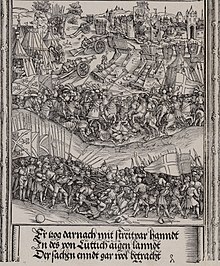
The early-modern European society gradually developed after the disasters of the 14th century as religious obedience and political loyalties declined in the wake of theGreat Plague,theschismof the Church and prolonged dynastic wars. The rise of thecitiesand the emergence of the newburgherclass eroded the societal, legal and economic order of feudalism.[127]
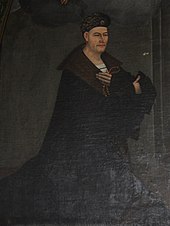
The commercial enterprises of the mercantile elites in the quickly developing cities in South Germany (such asAugsburgandNuremberg), with the most prominent families being theGossembrots,Fuggers(the wealthiest family in Europe during the fifteenth and sixteenth centuries[130]),Welsers,Hochstetters,Imholts, generated unprecedented financial means. As financiers to both the leading ecclesiastical and secular rulers, these families fundamentally influenced the political affairs in the empire during the fifteenth and sixteenth century.[131][132][133][134]The increasingly money based economy also provoked social discontent among knights and peasants and predatory "robber knights" became common.[135]
From 1438 theHabsburgdynasty, who had acquired control in the south-eastern empire over the Duchy of Austria,BohemiaandHungaryafter the death of KingLouis IIin 1526, managed to permanently occupy the position of the Holy Roman Emperor until 1806 (with the exception of the years between 1742 and 1745).
Some Europe-wide revolutions were born in the Empire: the combination of thefirst modern postal systemestablished byMaximilian(with the management under theTaxis family) with the printing system invented by Gutenberg produced a communication revolution[136][137][138]– the Empire's decentralized nature made censorship difficult and this combined with the new communication system to facilitate free expression, thus elevating cultural life. The system also helped the authorities to disseminate orders and policies, boosted the Empire's coherence in general, and helped reformers like Luther to broadcast their views and communicate with each other effectively, thus contributing to the religious Reformation.[139][140][141]
Maximilian'smilitary reforms,especially his development of theLandsknechte,caused a military revolution that broke the back of the knight class[142][143]and spread all over Europe shortly after his death.[144][145]
Imperial reform
[edit]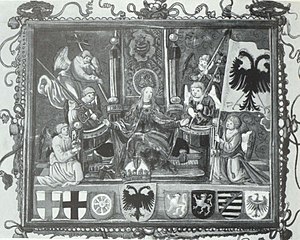
During his reign from 1493 to 1519,Maximilian I,in a combined effort with the Estates (who sometimes acted as opponents and sometimes as cooperators to him), his officials and his humanists,reformedthe empire. A dual system of Supreme Courts (theReichskammergerichtand theReichshofrat) was established (with theReichshofratplaying a more efficient role during the Early Modern period),[150]together with the formalized Reception of Roman Law;[151][152][153][154]theImperial Diet(Reichstag) became the all-important political forum and the supreme legal and constitutional institution, which would act as a guarantee for the preservation of the Empire in the long run;[155][156]a Permanent Land Piece (Ewiger Landfriede) was declared in 1495 with regional leagues and unions providing the supporting structure, together with the creation of theReichskreise(Imperial Circles,which would serve the purpose of organize imperial armies, collect taxes and enforce orders of the imperial institutions);[157][158][159]the Imperial and Court Chanceries were combined to become the decisive government institution;[160][161]theLandsknechtethat Maximilian created became a form of imperial army;[162]a national political culture began to emerge;[163][164]and the German language began to attain an unified form.[165][166]The political structure remained incomplete and piecemeal though, mainly due to the failure of the Common Penny (an imperial tax) that the Estates resisted.[150][a]Through many compromises between emperor and estates though, a flexible, future-oriented problem-solving mechanism for the Empire was formed, together with a monarchy through which the emperor shared power with the Estates.[168][b]Whether the Reform also equated to a (successful or unsuccessful) nation building process remains a debate.[170]
The additionNationis Germanicæ(of German Nation) to the emperor's title appeared first in the 15th century: in a 1486 law decreed by Frederick III and in 1512 in reference to the Imperial Diet in Cologne by Maximilian I. In 1525, the Heilbronn reform plan – the most advanced document of theGerman Peasants' War(Deutscher Bauernkrieg) – referred to theReichasvon Teutscher Nation(of German nation). During the fifteen century, the term "German nation" had witness a rise in use due to the growth of a "community of interests". The Estates also increasingly distinguished between their German Reich and the wider, "universal" Reich.[171]
Protestant Reformation
[edit]
In order to manage their ever growing expenses, theRenaissance Popesof the 15th and early 16th century promoted the excessive sale ofindulgencesand offices and titles of the Roman Curia.
In 1517, the monkMartin Lutherpublished a pamphlet with95 Thesesthat he posted in the town square ofWittenbergand handed copies of to feudal lords. Whether he nailed them to a church door at Wittenberg remains unclear. The list detailed 95 assertions, he argued, represented corrupt practice of the Christian faith and misconduct within the Catholic Church. Although perhaps not Luther's chief concern, he received popular support for his condemnation of the sale ofindulgencesand clerical offices, the pope's and higher clergy's abuse of power and his doubts of the very idea of the institution of the Church and the papacy.[172]
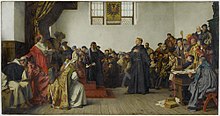
TheProtestant Reformationwas the first successful challenge to the Catholic Church and began in 1521 as Luther was outlawed at theDiet of Wormsafter his refusal to repent. The ideas of the reformation spread rapidly, as the new technology of the modern printing press ensured cheap mass copies and distribution of the theses and helped by theEmperor Charles V's wars with France and theTurks.[172]Hiding in theWartburg Castle,Luther translated the Bible into German, thereby greatly contributing to the establishment of the modern German language. This is highlighted by the fact that Luther spoke only a local dialect of minor importance during that time. After the publication of his Bible, his dialect suppressed others and constitutes to a great extent what is now modern German. With theprotestationof the Lutheran princes at theImperial DietofSpeyerin 1529 and the acceptance and adoption of the LutheranAugsburg Confessionby the Lutheran princes beginning in 1530, the separate Lutheran church was established.[173]
TheGerman Peasants' War,which began in the southwest inAlsaceandSwabiaand spread further east intoFranconia,Thuringiaand Austria, was a series of economic and religious revolts of the rural lower classes, encouraged by the rhetoric of various radical religious reformers and Anabaptists against the ruling feudal lords. Although occasionally assisted by war-experienced noblemen likeGötz von BerlichingenandFlorian Geyer(in Franconia) and the theologianThomas Müntzer(in Thuringia), the peasant forces lacked military structure, skill, logistics and equipment and as many as 100,000 insurgents were eventually defeated and massacred by the territorial princes.[174]
The CatholicCounter-Reformation,initiated in 1545 at theCouncil of Trentwas spearheaded by the scholarly religiousJesuit order,that was founded just five years prior by several clerics aroundIgnatius of Loyola.Its intent was to challenge and contain the Protestant Reformation via apologetic and polemical writings and decrees, ecclesiastical reconfiguration, wars and imperial political maneuverings. In 1547, emperor Charles V defeated theSchmalkaldic League,a military alliance of Protestant rulers.[175]The 1555Peace of Augsburgdecreed the recognition of the Lutheran Faith and religious division of the empire. It also stipulated the ruler's right to determine the official confession in his principality (Cuius regio, eius religio). The Counter-Reformation eventually failed to reintegrate the central and northern German Lutheran states. In 1608/1609 theProtestant Unionand theCatholic Leaguewere formed.
Thirty Years' War, 1618–1648
[edit]
The 1618 to 1648Thirty Years' War,that took place almost exclusively in the Holy Roman Empire has its origins, which remain widely debated, in the unsolved and recurring conflicts of the Catholic and Protestant factions. The Catholic emperorFerdinand IIattempted to achieve the religious and political unity of the empire, while the opposing Protestant Union forces were determined to defend their religious rights. The religious motive served as the universal justification for the various territorial and foreign princes, who over the course of several stages joined either of the two warring parties in order to gain land and power.[176][177]
The conflict was sparked by therevolt of the Protestant nobility of Bohemiaagainst emperorMatthias' succession policies. After imperial triumph at theBattle of White Mountainand a short-lived peace, the war grew to become a political European conflict by the intervention ofKing Christian IV of Denmarkfrom 1625 to 1630,Gustavus Adolphus of Swedenfrom 1630 to 1648 and France underCardinal Richelieufrom 1635 to 1648. The conflict increasingly evolved into a struggle between the French House of Bourbon and the House of Habsburg for predominance in Europe, for which the central German territories of the empire served as the battleground.[178]
The war ranks among the most catastrophic in history as three decades of constant warfare and destruction had left the land devastated. Marauding armies incessantly pillaged the countryside, seized and levied heavy taxes on cities and indiscriminately plundered the food stocks of the peasantry. There were also the countless bands of murderous outlaws, sick, homeless, disrupted people and invalid soldiery. Overall social and economic disruption caused a dramatic decline in population as a result of pandemic murder and random rape and killings, endemic infectious diseases, crop failures, famine, declining birth rates, wanton burglary, witch-hunts and the emigration of terrified people. Estimates vary between a 38% drop from 16 million people in 1618 to 10 million by 1650 and a mere 20% drop from 20 million to 16 million. TheAltmarkandWürttembergregions were especially hard hit, where it took generations to fully recover.[176][179]
The war was the last major religious struggle in mainland Europe and ended in 1648 with thePeace of Westphalia.It resulted in increased autonomy for the constituent states of the Holy Roman Empire, limiting the power of the emperor. Most ofAlsacewas ceded to France,Western PomeraniaandBremen-Verdenwere given to Sweden as Imperial fiefs, and the Netherlands officially left the Empire.[180]
Culture and literacy
[edit]
The population of Germany reached about twenty million people by the mid-16th century, the great majority of whom were peasant farmers.[182]
TheProtestant Reformationwas a triumph forliteracyand the newprinting press.[183][c][185][186]Luther's translation of the Bible into High German(theNew Testamentwas published in 1522; theOld Testamentwas published in parts and completed in 1534) was a decisive impulse for the increase of literacy inearly modern Germany,[181]and stimulated printing and distribution of religious books and pamphlets. From 1517 onward religious pamphlets flooded Germany and much of Europe. The Reformation instigated a media revolution as by 1530 over 10,000 individual works are published with a total of ten million copies. Luther strengthened his attacks on Rome by depicting a "good" against "bad" church. It soon became clear that print could be used for propaganda in the Reformation for particular agendas. Reform writers used pre-Reformation styles, clichés, and stereotypes and changed items as needed for their own purposes.[187]Especially effective were Luther'sSmall Catechism,for use of parents teaching their children, andLarger Catechism,for pastors.[188]Using the German vernacular they expressed the Apostles' Creed in simpler, more personal, Trinitarian language. Illustrations in the newly translated Bible and in many tracts popularized Luther's ideas.Lucas Cranach the Elder,the painter patronized by the electors of Wittenberg, was a close friend of Luther, and illustrated Luther's theology for a popular audience. He dramatized Luther's views on the relationship between the Old and New Testaments, while remaining mindful of Luther's careful distinctions about proper and improper uses of visual imagery.[189]
Luther's translation of the Bible into High Germanwas also decisive for theGerman languageand its evolution fromEarly New High Germanto Modern Standard German.[181]The publication of Luther's Bible was a decisive moment in the spread of literacy inearly modern Germany,[181]and promoted the development of non-local forms of language and exposed all speakers to forms of German from outside their own area.[190]
Science
[edit]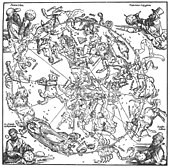
Notable late fifteenth to early eighteenth-centurypolymathsinclude:Johannes Trithemius,one of the founder of modern cryptography, founder ofsteganography,as well asbibliographyand literary studies as branches of knowledge;[191][192][193]Conrad Celtes,the first and foremost German cartographic writer and "the greatest lyric genius and certainly the greatest organizer and popularizer of German Humanism";[194][195][196][197]Athanasius Kircher,described by Fletcher as "a founder figure of various disciplines—of geology (certainly vulcanology), musicology (as a surveyor of musical forms), museum curatorship, Coptology, to name a few—and might be claimed today as the first theorist of gravity and a long-term originator of the moving pictures (with his magic lantern shows). Through his many enthusiasms, moreover, he was the conduit of others' pursuits in the rapidly widening horizon of knowledge that marks the later Renaissance.";[198]andGottfried Wilhelm Leibniz,one of the greatest, if not the greatest "Universal genius", of all times.[199][200]
Cartography developed strongly, with the center being Nuremberg, at the beginning of the sixteenth century.Martin WaldseemüllerandMatthias Ringmann'sUniversalis Cosmographiaand the 1513 edition ofGeographymarked the climax of a cartography revolution.[201][202]The emperor himself dabbled in cartography.[203]
In 1515,Johannes Stabius(court astronomer under Maximilian I),Albrecht Dürerand the astronomerKonrad Heinfogelproduced the first planispheres of both southern and northerns hemispheres, also the first printed celestial maps. These maps prompted the revival of interest in the field of uranometry throughout Europe.[204][205][206][207]
AstronomerJohannes KeplerfromWeil der Stadtwas one of the pioneering minds of empirical and rational research. Through rigorous application of the principles of theScientific methodhe construed hislaws of planetary motion.His ideas influenced contemporary Italian scientistGalileo Galileiand provided fundamental mechanical principles forIsaac Newton's theory ofuniversal gravitation.[208]
-
Johannes Kepler,one of the founders and fathers of modernastronomy,thescientific method,naturalandmodern science[209][210][211]
-
Otto von Guericke,scientist, inventor and politician, famous for demonstrating the power of atmospheric pressure with theMagdeburg hemispheres
-
Elisabeth of the Palatinate,philosopher, critic ofRené Descartes' dualistic metaphysics
-
Hans Jakob Christoffel von Grimmelshausen,author of the novelSimplicius Simplicissimus
-
Athanasius Kircher,polymath
-
Gottfried Wilhelm Leibniz,philosopher and mathematician
-
Ehrenfried Walther von Tschirnhaus,mathematician, physicist, physician, philosopher, co-inventor of European porcelain
Colonies
[edit]German Colonies in the Americas existed because theFree Imperial CitiesofAugsburgandNuremberggot colonial rights in theProvince of Venezuelaor North of South America in return for debts owed by theHoly Roman EmpireCharles V,who was also King of Spain. In 1528, Charles V issued a charter by which theWelser familypossessed the rights to explore, rule and colonize the area, also with the motivation of searching for the legendary golden city ofEl Dorado.Their principal colony wasKlein-Venedig.A never realized colonial project wasHanauish-Indiesintended byFriedrich Casimir, Count of Hanau-Lichtenbergas a fief of theDutch West India Company.The project failed due to a lack of funds and the outbreak of theFranco-Dutch Warin 1672.
1648–1815
[edit]Rise of Prussia
[edit]
Frederick William,ruler ofBrandenburg-Prussiasince 1640 and later called the GreatElector,acquiredEast Pomeraniavia thePeace of Westphaliain 1648. He reorganized his loose and scattered territories and managed to throw off the vassalage of Prussia under the Kingdom of Poland during theSecond Northern War.[212]In order to address the demographic problem of Prussia's largely rural population of about three million, he attracted the immigration and settlement of FrenchHuguenotsin urban areas. Many became craftsmen and entrepreneurs.[213]King Frederick William I,known as theSoldier King,who reigned from 1713 to 1740, established the structures for the highly centralized Prussian state and raised a professional army, that was to play a central role.[214]He also successfully operated a command economy that some historians consider mercantilist.[215][216]
The total population of Germany (in its1914 territorial extent) grew from 16 million in 1700 to 17 million in 1750 and reached 24 million in 1800. The 18th-century economy noticeably profited from widespread practical application of the Scientific method as greater yields and a more reliable agricultural production and the introduction of hygienic standards positively affected the birth rate – death rate balance.[217]
Wars
[edit]
Louis XIV of Francewaged a series of successful wars in order to extend the French territory. He occupiedLorraine(1670) and annexed the remainder of Alsace (1678–1681) that included the free imperial city ofStraßburg.At the start of theNine Years' War,he also invaded theElectorate of the Palatinate(1688–1697).[218]Louis established a number ofcourtswhose sole function was to reinterpret historic decrees and treaties, theTreaties of Nijmegen(1678) and thePeace of Westphalia(1648) in particular in favor of his policies of conquest. He considered the conclusions of these courts, theChambres de réunionas sufficient justification for his boundless annexations. Louis' forces operated inside the Holy Roman Empire largely unopposed, because all available imperial contingents fought in Austria in theGreat Turkish War.TheGrand Allianceof 1689 took up arms against France and countered any further military advances of Louis. The conflict ended in 1697 as both parties agreed to peace talks after either side had realized, that a total victory was financially unattainable. TheTreaty of Ryswickprovided for the return of the Lorraine and Luxembourg to the empire and the abandoning of French claims to the Palatinate.[219]
After the last-minuterelief of Viennafrom a siege and the imminent seizure by aTurkish forcein 1683, the combined troops of theHoly League,that had been founded the following year, embarked on the military containment of theOttoman Empireand reconqueredHungaryin 1687.[220]ThePapal States,the Holy Roman Empire, thePolish–Lithuanian Commonwealth,theRepublic of Veniceand since 1686Russiahad joined the league under the leadership ofPope Innocent XI.Prince Eugene of Savoy,who served under emperor Leopold I, took supreme command in 1697 and decisively defeated the Ottomans in a series of spectacular battles and manoeuvres. The 1699Treaty of Karlowitzmarked the end of the Great Turkish War and Prince Eugene continued his service for theHabsburg monarchyas president of theWar Council.He effectively ended Turkish rule over most of the territorial states in theBalkansduring theAustro-Turkish War of 1716–1718.TheTreaty of Passarowitzleft Austria to freely establish royal domains in Serbia and the Banat and maintain hegemony inSoutheast Europe,on which the futureAustrian Empirewas based.[221][222]
Enlightened absolutism
[edit]
Frederick II "the Great"is best known for his military genius and unique utilisation of the highly organized army to make Prussia one of the great powers in Europe as well asescaping from almost certain national disasterat the last minute. He was also an artist, author and philosopher, who conceived and promoted the concept ofenlightened absolutism.[223][224]
Austrian empressMaria Theresasucceeded in bringing about a favorable conclusion for her inthe 1740 to 1748 warfor recognition of her succession to the throne. However,Silesiawas permanently lost to Prussia as a consequence of theSilesian Warsand theSeven Years' War.The 1763Treaty of Hubertusburgruled that Austria and Saxony had to relinquish all claims to Silesia. Prussia, that had nearly doubled its territory was eventually recognized as a great European power with the consequence that the politics of the following century were fundamentally influenced byGerman dualism,the rivalry of Austria and Prussia for supremacy in Central Europe.[225]
The concept of enlightened absolutism, although rejected by the nobility and citizenry, was advocated inPrussiaandAustriaand implemented since 1763. Prussian kingFrederick IIdefended the idea in an essay and argued that thebenevolent monarchsimply is thefirst servant of the state,who effects his absolute political power for the benefit of the population as a whole. A number of legal reforms (e.g. the abolition of torture and the emancipation of the rural population and the Jews), the reorganization of thePrussian Academy of Sciences,the introduction of compulsory education for boys and girls and promotion of religious tolerance, among others, caused rapid social and economic development.[226]
During 1772 to 1795 Prussia instigated thepartitions of Polandby occupying the western territories of the formerPolish–Lithuanian Commonwealth.Austria andRussiaresolved to acquire the remaining lands with the effect that Poland ceased to exist as a sovereign state until 1918.[227]
Smaller states
[edit]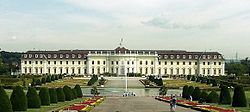
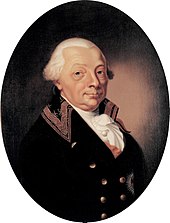
The smaller German states were overshadowed by Prussia and Austria.Bavariahad arural economy.Saxonywas in economically good shape, although numerous wars had taken their toll. During the time when Prussia rose rapidly within Germany, Saxony was distracted by foreign affairs. The House of Wettin concentrated on acquiring and then holding on to the Polish throne which was ultimately unsuccessful.[228][clarification needed]
Many of the smaller states of Germany were run by bishops, who in reality were from powerful noble families and showed scant interest in religion. While none of the later ecclesial rulers reached the outstanding reputation of Mainz'Johann Philipp von Schönbornor Münster'sChristoph Bernhard von Galen,some of them promotedEnlightenmentlike the benevolent and progressiveFranz Ludwig von ErthalinWürzburgandBamberg.[229]
InHesse-Kassel,the LandgraveFrederick II,ruled from 1760 to 1785 as an enlightened despot, and raised money by renting soldiers (called "Hessians") toGreat Britainto help fight theAmerican Revolutionary War.He combined Enlightenment ideas with Christian values,cameralistplans for central control of the economy, and a militaristic approach toward diplomacy.[230]
Hanoverdid not have to support a lavish court—its rulers were also kings of England and resided in London.George III,elector (ruler) from 1760 to 1820, never once visited Hanover. The local nobility who ran the country opened theUniversity of Göttingenin 1737; it soon became a world-class intellectual center.Badensported perhaps the best government of the smaller states.Karl Friedrichruled for 73 years and was an enthusiast for the Enlightenment; he abolished serfdom in 1783.[231]
The smaller states failed to form coalitions with each other, and were eventually overwhelmed by Prussia who swallowed up many of them between 1807 and 1871.[232]
Social changes
[edit]Prussiaunderwent majorsocial changebetween the mid-17th and mid-18th centuries as thenobilitydeclined as the traditionalaristocracystruggled to compete with the risingmerchant class,[233]which developed into a newBourgeoisiemiddle class,[234][235][236]while theemancipation of the serfsgranted the ruralpeasantryland purchasing rights and freedom of movement,[237]and a series ofagrarian reformsin northwestern Germany abolishedfeudal obligationsand divided up feudal land, giving rise to wealthier peasants and paved the way for a more efficientrural economy.[238]
Enlightenment
[edit]
During the mid-18th century, the recognition and application of Enlightenment cultural, intellectual and spiritual ideals and standards, led to a flourishing of art, music, philosophy, science and literature. The philosopherChristian Wolffwas a pioneering author in a vast number of fields of Enlightenment rationality, and established German as the prevailing language of philosophical reasoning, scholarly instruction and research.[239]
In 1685, MargraveFrederick Williamof Prussia issued theEdict of Potsdamwithin a week after French kingLouis XIV'sEdict of Fontainebleau,that decreed the abolishment of the 1598concessionto free religious practice forProtestants.Frederick William offered hisco-religionists, who are oppressed and assailed for the sake of the Holy Gospel and its pure doctrine...a secure and free refuge in all Our Lands.[240]Around 20,000 Huguenot refugees arrived in an immediate wave and settled in the cities, 40% in Berlin, the ducal residence alone. The French Lyceum in Berlin was established in 1689 and the French language had by the end of the 17th century replaced Latin to be spoken universally in international diplomacy. The nobility and the educated middle-class of Prussia and the various German states increasingly used the French language in public conversation in combination with universal cultivated manners. Like no other German state, Prussia had access to and the skill set for the application of pan-European Enlightenment ideas to develop more rational political and administrative institutions.[241]The princes of Saxony carried out a comprehensive series of fundamental fiscal, administrative, judicial, educational, cultural and general economic reforms. The reforms were aided by the country's strong urban structure and influential commercial groups, who modernized pre-1789 Saxony along the lines of classic Enlightenment principles.[242]
Johann Gottfried von Herderbroke new ground in philosophy and poetry, as a leader of theSturm und Drangmovement of proto-Romanticism.Weimar Classicism( "Weimarer Klassik" ) was a cultural and literary movement based in Weimar that sought to establish a new humanism by synthesizing Romantic, classical, and Enlightenment ideas. The movement, from 1772 until 1805, involved Herder as well as polymathJohann Wolfgang von GoetheandFriedrich Schiller,a poet and historian. Herder argued that every folk had its own particular identity, which was expressed in its language and culture. This legitimized the promotion of German language and culture and helped shape the development of German nationalism. Schiller's plays expressed the restless spirit of his generation, depicting the hero's struggle against social pressures and the force of destiny.[243]
German music, sponsored by the upper classes, came of age under composersJohann Sebastian Bach,Joseph Haydn,andWolfgang Amadeus Mozart.[244]
KönigsbergphilosopherImmanuel Kanttried to reconcile rationalism and religious belief, individual freedom, and political authority. Kant's work contained basic tensions that would continue to shape German thought – and indeed all of European philosophy – well into the 20th century.[245][246]The ideas of the Enlightenment and their implementation received general approval and recognition as principal cause for widespread cultural progress.[247]
French Revolution, 1789–1815
[edit]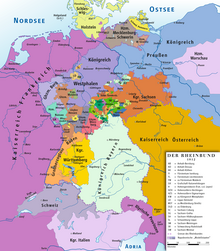
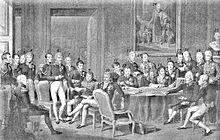
German reaction to theFrench Revolutionwas mixed at first. German intellectuals celebrated the outbreak, hoping to see the triumph of Reason and The Enlightenment. The royal courts in Vienna and Berlin denounced the overthrow of the king and the threatened spread of notions of liberty, equality, and fraternity. By 1793, theexecution of the French kingand the onset ofthe Terrordisillusioned the Bildungsbürgertum (educated middle classes). Reformers said the solution was to have faith in the ability of Germans to reform their laws and institutions in peaceful fashion.[248]
Europe was racked by two decades of war revolving around France's efforts to spread its revolutionary ideals, and the opposition of reactionary royalty. War broke out in 1792 as Austria and Prussia invaded France, but were defeated at theBattle of Valmy(1792). The German lands saw armies marching back and forth, bringing devastation (albeit on a far lower scale than theThirty Years' War,almost two centuries before), but also bringing new ideas of liberty and civil rights for the people. Prussia and Austria ended their failed wars with France but (with Russia) partitioned Poland among themselves in 1793 and 1795.
French consulate suzerainty
[edit]Francetook control of theRhineland,imposed French-style reforms, abolished feudalism, established constitutions, promoted freedom of religion, emancipated Jews, opened the bureaucracy to ordinary citizens of talent, and forced the nobility to share power with the rising middle class. Napoleon created theKingdom of Westphaliaas a model state.[249]These reforms proved largely permanent and modernized the western parts of Germany. When the French tried to impose the French language, German opposition grew in intensity. ASecond Coalitionof Britain, Russia, and Austria then attacked France but failed. Napoleon established direct or indirect control over most of western Europe, including the German states apart from Prussia and Austria. The old Holy Roman Empire was little more than a farce; Napoleon simply abolished it in 1806 while forming new countries under his control. In Germany Napoleon set up the "Confederation of the Rhine",comprising most of the German states except Prussia and Austria.[250]
Imperial French suzerainty
[edit]UnderFrederick William II's weak rule (1786–1797) Prussia had undergone a serious economic, political and military decline. His successor kingFrederick William IIItried to remain neutral during theWar of the Third CoalitionandFrench emperorNapoleon's dissolution of theHoly Roman Empireand reorganisation of the German principalities. Induced by the queen and a pro-war party Frederick William joined theFourth Coalitionin October 1806. Napoleon easily defeated the Prussian army at theBattle of Jenaand occupied Berlin. Prussia lost its recently acquired territories in western Germany, its army was reduced to 42,000 men, no trade with Britain was allowed and Berlin had to pay Paris high reparations and fund the French army of occupation.Saxonychanged sides to support Napoleon and joined theConfederation of the Rhine.RulerFrederick Augustus Iwas rewarded with the title of king and given a part of Poland taken from Prussia, which became known as theDuchy of Warsaw.[251]
AfterNapoleon's military fiasco in Russia in 1812,Prussia allied with Russia in theSixth Coalition.A series of battles followed and Austria joined the alliance. Napoleon was decisively defeated in theBattle of Leipzigin late 1813. The German states of the Confederation of the Rhine defected to the Coalition against Napoleon, who rejected any peace terms. Coalition forces invaded France in early 1814,Paris felland in April Napoleon surrendered. Prussia as one of the winners at theCongress of Vienna,gained extensive territory.[217]
1815–1871
[edit]Overview
[edit]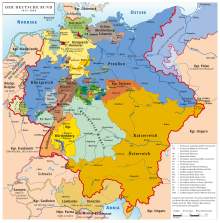

In 1815, continental Europe was in a state of overall turbulence and exhaustion, as a consequence of theFrench RevolutionaryandNapoleonic Wars.The liberal spirit of theEnlightenmentand Revolutionary era diverged towardRomanticism.[252]The victorious members of the Coalition had negotiated a new peaceful balance of powers in Vienna and agreed to maintain a stable German heartland that keeps French imperialism at bay. However, the idea of reforming the defunctHoly Roman Empirewas discarded. Napoleon'sreorganization of the German stateswas continued and the remaining princes were allowed to keep their titles. In 1813, in return for guarantees from the Allies that the sovereignty and integrity of the Southern German states (Baden,Württemberg,andBavaria) would be preserved, they broke with France.[253]
German Confederation
[edit]During the 1815Congress of Viennathe 39 former states of theConfederation of the Rhinejoined theGerman Confederation,a loose agreement for mutual defense. Attempts of economic integration and customs coordination were frustrated by repressive anti-national policies. Great Britain approved of the union, convinced that a stable, peaceful entity in central Europe could discourage aggressive moves by France or Russia. Most historians, however, concluded, that the Confederation was weak and ineffective and an obstacle to German nationalism. The union was undermined by the creation of theZollvereinin 1834, the1848 revolutions,the rivalry between Prussia and Austria and was finally dissolved in the wake of theAustro-Prussian Warof 1866,[254]to be replaced by theNorth German Confederationduring the same year.[254]
Society and economy
[edit]Increasingly after 1815, a centralized Prussian government based in Berlin took over the powers of the nobles, which in terms of control over the peasantry had been almost absolute. To help the nobility avoid indebtedness, Berlin set up a credit institution to provide capital loans in 1809, and extended the loan network to peasants in 1849. When the German Empire was established in 1871, the Junker nobility controlled the army and the navy, the bureaucracy, and the royal court; they generally set governmental policies.[255]
Population
[edit]
Between 1815 and 1865 the population of the German Confederation (excluding Austria) grew around 60% from 21 million to 34 million.[256]Simultaneously theDemographic Transitiontook place as the high birth rates and high death rates of the pre-industrial country shifted to low birth and death rates of the fast-growing industrialized urban economic and agricultural system. Increased agricultural productivity secured a steady food supply, as famines and epidemics declined. This allowed people to marry earlier, and have more children. The high birthrate was offset by a very high rate of infant mortality and after 1840, large-scale emigration to theUnited States.Emigration totaled at 480,000 in the 1840s, 1,200,000 in the 1850s, and at 780,000 in the 1860s. The upper and middle classes first practiced birth control, soon to be universally adopted.[257]
Industrialization
[edit]

In 1800, Germany's social structure was poorly suited to entrepreneurship or economic development. Domination by France during the French Revolution (1790s to 1815), however, produced important institutional reforms, that included the abolition of feudal restrictions on the sale of large landed estates, the reduction of the power of the guilds in the cities, and the introduction of a new, more efficient commercial law. The idea, that these reforms were beneficial for Industrialization has been contested.[258]
In the early 19th century the Industrial Revolution was in full swing in Britain, France, and Belgium. The various small federal states in Germany developed only slowly and independently as competition was strong. Early investments for the railway network during the 1830s came almost exclusively from private hands. Without a central regulatory agency the construction projects were quickly realized. Actual industrialization only took off after 1850 in the wake of the railroad construction.[259]The textile industry grew rapidly, profiting from the elimination of tariff barriers by the Zollverein.[260][261]During the second half of the 19th century the German industry grew exponentially and by 1900, Germany was an industrial world leader along with Britain and the United States.[262]</ref>
Urbanization
[edit]In 1800, the population was predominantly rural, as only 10% lived in communities of 5,000 or more people, and only 2% lived in cities of more than 100,000 people. After 1815, the urban population grew rapidly, due to the influx of young people from the rural areas. Berlin grew from 172,000 in 1800, to 826,000 inhabitants in 1870, Hamburg from 130,000 to 290,000, Munich from 40,000 to 269,000 and Dresden from 60,000 to 177,000.[263]
Railways
[edit]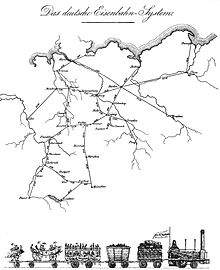
The takeoff stage of economic development came with the railroad revolution in the 1840s, which opened up new markets for local products, created a pool of middle managers, increased the demand for engineers, architects and skilled machinists and stimulated investments in coal and iron. Political disunity of three dozen states and a pervasive conservatism made it difficult to build railways in the 1830s. However, by the 1840s, trunk lines did link the major cities; each German state was responsible for the lines within its own borders. EconomistFriedrich Listsummed up the advantages to be derived from the development of the railway system in 1841:
- 1. As a means of national defence, it facilitates the concentration, distribution and direction of the army.
- 2. It is a means to the improvement of the culture of the nation. It brings talent, knowledge and skill of every kind readily to market.
- 3. It secures the community against dearth and famine, and against excessive fluctuation in the prices of the necessaries of life.
- 4. It promotes the spirit of the nation, as it has a tendency to destroy the Philistine spirit arising from isolation and provincial prejudice and vanity. It binds nations by ligaments, and promotes an interchange of food and of commodities, thus making it feel to be a unit. The iron rails become a nerve system, which, on the one hand, strengthens public opinion, and, on the other hand, strengthens the power of the state for police and governmental purposes.[264]
Lacking a technological base at first, engineering and hardware was imported from Britain. In many cities, the new railway shops were the centres of technological awareness and training, so that by 1850, Germany was self-sufficient in meeting the demands of railroad construction, and the railways were a major impetus for the growth of the new steel industry. Observers found that even as late as 1890, their engineering was inferior to Britain. However, German unification in 1870 stimulated consolidation, nationalisation into state-owned companies, and further rapid growth. Unlike the situation in France, the goal was the support of industrialisation. Eventually numerous lines criss-crossed the Ruhr area and other industrial centers and provided good connections to the major ports of Hamburg and Bremen. By 1880, 9,400 locomotives pulled 43,000 passengers and 30,000 tons of freight a day.[259]
Newspapers and magazines
[edit]While there existed no national newspaper the many states issued a great variety of printed media, although they rarely exceeded regional significance. In a typical town existed one or two outlets, urban centers, such as Berlin and Leipzig had dozens. The audience was limited to a few per cent of male adults, chiefly from the aristocratic and upper middle class. Liberal publishers outnumbered conservative ones by a wide margin. Foreign governments bribed editors to guarantee a favorable image.[265]Censorship was strict, and the imperial government issued the political news that was supposed to be published. After 1871, strict press laws were enforced by Bismarck to contain the Socialists and hostile editors. Editors focused on political commentary, culture, the arts, high culture and the popular serialized novels. Magazines were politically more influential and attracted intellectual authors.[266]
Science and culture during the 18th and 19th century
[edit]19th-century artists and intellectuals were greatly inspired by the ideas of the French Revolution and the great poets and writersJohann Wolfgang von Goethe,Gotthold Ephraim LessingandFriedrich Schiller.TheSturm und Drangromanticmovement was embraced and emotion was given free expression in reaction to the perceived rationalism of theEnlightenment.Philosophical principles and methods were revolutionized byImmanuel Kant's paradigm shift.Ludwig van Beethovenwas the most influential composer of the period fromclassicaltoRomantic music.His use of tonal architecture in such a way as to allow significant expansion of musical forms and structures was immediately recognized as bringing a new dimension to music. His later piano music and string quartets, especially, showed the way to a completely unexplored musical universe, and influencedFranz SchubertandRobert Schumann.In opera, a new Romantic atmosphere combining supernatural terror and melodramatic plot in a folkloric context was first successfully achieved byCarl Maria von Weberand perfected byRichard Wagnerin hisRing Cycle.TheBrothers Grimmcollected folk stories into the popularGrimm's Fairy Talesand are ranked among the founding fathers ofGerman studies,who initiated the work on theDeutsches Wörterbuch( "The German Dictionary" ), the most comprehensive work on the German language.[267]
University professors developed international reputations, especially in the humanities led by history and philology, which brought a new historical perspective to the study of political history, theology, philosophy, language, and literature. WithGeorg Wilhelm Friedrich Hegel,Friedrich Wilhelm Joseph Schelling,Arthur Schopenhauer,Friedrich Nietzsche,Max Weber,Karl MarxandFriedrich Engelsin philosophy,Friedrich Schleiermacherin theology andLeopold von Rankein history became famous. TheUniversity of Berlin,founded in 1810, became the world's leading university. Von Ranke, for example, professionalized history and set the world standard for historiography. By the 1830s mathematics, physics, chemistry, and biology had emerged with world class science, led byAlexander von Humboldtin natural science andCarl Friedrich Gaussin mathematics. Young intellectuals often turned to politics, but their support for the failed revolution of 1848 forced many into exile.[217]
Religion
[edit]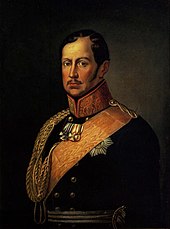
Two main developments reshaped religion in Germany. Across the land, there was a movement to unite the larger Lutheran and the smaller Reformed Protestant churches. The churches themselves brought this about in Baden, Nassau, and Bavaria. However, in Prussia KingFrederick William IIIwas determined to handle unification entirely on his own terms, without consultation. His goal was to unify the Protestant churches, and to impose a single standardized liturgy, organization and even architecture. The long-term goal was to have fully centralized royal control of all the Protestant churches. In a series of proclamations over several decades theChurch of the Prussian Unionwas formed, bringing together the more numerous Lutherans, and the less numerous Reformed Protestants. The government of Prussia now had full control over church affairs, with the king himself recognized as the leading bishop. Opposition to unification came from the "Old Lutherans" in Silesia who clung tightly to the theological and liturgical forms they had followed since the days of Luther. The government attempted to crack down on them, so they went underground. Tens of thousands migrated,to South Australia,and especially to the United States, where they formed theMissouri Synod,which is still in operation as a conservative denomination. Finally in 1845 a new kingFrederick William IVoffered a general amnesty and allowed the Old Lutherans to form a separate church association with only nominal government control.[268][269][270]
From the religious point of view of the typical Catholic or Protestant, major changes were underway in terms of a much more personalized religiosity that focused on the individual more than the church or the ceremony. The rationalism of the late 19th century faded away, and there was a new emphasis on the psychology and feeling of the individual, especially in terms of contemplating sinfulness, redemption, and the mysteries and the revelations of Christianity.Pietistic revivalswere common among Protestants. Among, Catholics there was a sharp increase in popular pilgrimages. In 1844 alone, half a million pilgrims made a pilgrimage to the city of Trier in the Rhineland to view theSeamless robe of Jesus,said to be the robe that Jesus wore on the way to his crucifixion. Catholic bishops in Germany had historically been largely independent of Rome, but now the Vatican exerted increasing control, a new "ultramontanism"of Catholics highly loyal to Rome.[271]A sharp controversy broke out in 1837–1838 in the largely Catholic Rhineland over the religious education of children of mixed marriages, where the mother was Catholic and the father Protestant. The government passed laws to require that these children always be raised as Protestants, contrary to Napoleonic law that had previously prevailed and allowed the parents to make the decision. It put the Catholic Archbishop under house arrest. In 1840, the new King Frederick William IV sought reconciliation and ended the controversy by agreeing to most of the Catholic demands. However Catholic memories remained deep and led to a sense that Catholics always needed to stick together in the face of an untrustworthy government.[272]
Politics of restoration and revolution
[edit]After Napoleon
[edit]

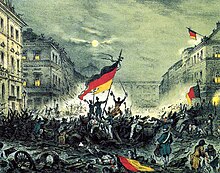

After the fall of Napoleon, Europe's statesmen convened in Vienna in 1815 for the reorganisation of European affairs, under the leadership of theAustrian Prince Metternich.The political principles agreed upon at thisCongress of Viennaincluded the restoration, legitimacy and solidarity of rulers for the repression of revolutionary and nationalist ideas.
TheGerman Confederation(‹See Tfd›German:Deutscher Bund) was founded, a loose union of 39 states (35 ruling princes and 4 free cities) under Austrian leadership, with a Federal Diet (‹See Tfd›German:Bundestag) meeting inFrankfurt am Main.It was a loose coalition that failed to satisfy most nationalists. The member states largely went their own way, and Austria had its own interests.
In 1819, a student radical assassinated the reactionary playwrightAugust von Kotzebue,who had scoffed at liberal student organisations. In one of the few major actions of the German Confederation, Prince Metternich called a conference that issued the repressiveCarlsbad Decrees,designed to suppress liberal agitation against the conservative governments of the German states.[273]The Decrees terminated the fast-fading nationalist fraternities (‹See Tfd›German:Burschenschaften), removed liberal university professors, and expanded the censorship of the press. The decrees began the "persecution of the demagogues", which was directed against individuals who were accused of spreading revolutionary and nationalist ideas. Among the persecuted were the poetErnst Moritz Arndt,the publisher Johann Joseph Görres and the "Father of Gymnastics" Ludwig Jahn.[274]
In 1834, theZollvereinwas established, a customs union between Prussia and most other German states, but excluding Austria. As industrialisation developed, the need for a unified German state with a uniform currency, legal system, and government became more and more obvious.
1848
[edit]Growing discontent with the political and social order imposed by the Congress of Vienna led to the outbreak, in 1848, of theMarch Revolutionin the German states. In May the German National Assembly (theFrankfurt Parliament) met in Frankfurt to draw up a national German constitution.
But the 1848 revolution turned out to be unsuccessful:King Frederick William IV of Prussiarefused the imperial crown, the Frankfurt parliament was dissolved, the ruling princes repressed the risings by military force, and the German Confederation was re-established by 1850. Many leaders went into exile, including a number who went to the United States and became a political force there.[275]
1850s
[edit]The 1850s were a period of extreme political reaction. Dissent was vigorously suppressed, and many Germans emigrated to America following the collapse of the 1848 uprisings. Frederick William IV became extremely depressed and melancholic during this period, and was surrounded by men who advocatedclericalismandabsolute divine monarchy.The Prussian people once again lost interest in politics. Prussia not only expanded its territory but began to industrialize rapidly, while maintaining a strong agricultural base.
Bismarck takes charge (1862–1866)
[edit]In 1857, the Prussian kingFrederick William IVsuffered a stroke and his brotherWilliamserved as regent until 1861 when he became King William I. Although conservative, William was very pragmatic. His most significant accomplishment was the naming ofOtto von Bismarckas Prussian minister president in 1862. The cooperation of Bismarck, Defense MinisterAlbrecht von Roon,and Field MarshalHelmut von Moltkeset the stage for the military victories over Denmark, Austria, and France, that led to the unification of Germany.[276][277]
In 1863–1864, disputes between Prussia and Denmark overSchleswigescalated, which was not part of the German Confederation, and which Danish nationalists wanted to incorporate into the Danish kingdom. The conflict led to theSecond War of Schleswigin 1864. Prussia, joined by Austria, easily defeated Denmark and occupiedJutland.The Danes were forced to cede both the Duchy of Schleswig and theDuchy of Holsteinto Austria and Prussia. The subsequent management of the two duchies led to tensions between Austria and Prussia. Austria wanted the duchies to become an independent entity within the German Confederation, while Prussia intended to annex them. The disagreement served as a pretext for theSeven Weeks Warbetween Austria and Prussia, that broke out in June 1866. In July, the two armies clashed at Sadowa-Königgrätz (Bohemia) in anenormous battleinvolving half a million men. Prussian superior logistics and the modern breech-loadingneedle gunssuperiority over the slowmuzzle-loading riflesof the Austrians, proved to be elementary for Prussia's victory. The battle had also decided thestruggle for hegemonyin Germany and Bismarck was deliberately lenient with defeated Austria, that was to play only a subordinate role in future German affairs.[278][279]
North German Confederation, 1866–1871
[edit]After theSeven Weeks War,the German Confederation was dissolved and theNorth German Federation(GermanNorddeutscher Bund) was established under the leadership of Prussia. Austria was excluded and its immense influence over Germany finally came to an end. The North German Federation was a transitional organisation that existed from 1867 to 1871, between the dissolution of the German Confederation and the founding of the German Empire.[280]
German Empire, 1871–1918
[edit]Overview
[edit]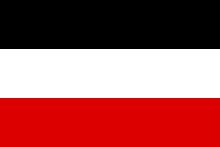

ChancellorOtto von Bismarckdetermined the political course of the German Empire until 1890. He fostered alliances in Europe to contain France on the one hand and aspired to consolidate Germany's influence in Europe on the other. His principal domestic policies focused on the suppression of socialism and the reduction of the strong influence of the Roman Catholic Church on its adherents. He issued a series of anti-socialist laws in accord with a set of social laws, that included universal health care, pension plans and other social security programs. HisKulturkampfpolicies were vehemently resisted by Catholics, who organized political opposition in the Center Party (Zentrum). German industrial and economic power had grown to match Britain by 1900.
In 1888, the young and ambitious KaiserWilhelm IIbecame emperor. He rejected advice from experienced politicians and ordered Bismarck's resignation in 1890. He opposed Bismarck's careful and delicate foreign policy and was determined to pursue colonialist policies, as Britain and France had been doing for centuries. The Kaiser promoted the active colonization of Africa and Asia for the lands that were not already colonies of other European powers. The Kaiser took a mostly unilateral approach in Europe only allied with the Austro-Hungarian Empire, and embarked on a dangerous naval arms race with Britain. His aggressive and erroneous policies greatly contributed to the situation in which the assassination of the Austrian-Hungarian crown prince would spark offWorld War I.
Bismarck era
[edit]Bismarck was the dominant personality not just in Germany but in all of Europe and indeed the entire diplomatic world 1870–1890. Historians continue to debate his goals.Lothar GallandErnst Engelbergconsider Bismarck was a future-oriented modernizer. In sharp contrast,Jonathan Steinbergdecided he was basically a traditional Prussian whose highest priorities were to reinforce the monarchy, the Army, and the social and economic dominance of his own Junker class, thereby being responsible for a tragic history after his removal in 1890.[281]
The new empire
[edit]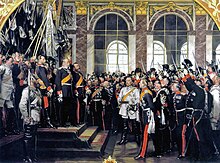
In 1868, the Spanish queenIsabella IIwas deposed in theGlorious Revolution,leaving the country's throne vacant. When Prussia suggested the Hohenzollern candidate,Prince Leopoldas successor, France vehemently objected. The matter evolved into adiplomatic scandaland in July 1870, France resolved to end it in afull-scale war.The conflict was quickly decided as Prussia, joined by forces of a pan-German alliance never gave up the tactical initiative. A series of victories in north-eastern France followed and another French army group was simultaneously encircled at Metz. A few weeks later, the French army contingent under EmperorNapoleon III's personal command was finally forced to capitulate in thefortress of Sedan.[282][283]Napoleon was taken prisoner and aprovisional governmenthastily proclaimed in Paris. The new government resolved to fight on and tried to reorganize the remaining armies while the Germans settled down to besiege Paris. The starving city surrendered in January 1871 and Jules Favre signed the surrender at Versailles. France was forced to pay indemnities of 5 billion francs and cedeAlsace-Lorraineto Germany. This conclusion left the French national psyche deeply humiliated and further aggravated theFrench–German enmity.
During theSiege of Paris,the German princes assembled in theHall of Mirrorsof thePalace of Versailleson 18 January 1871 and announced the establishment of theGerman Empireand proclaimed the Prussian KingWilhelm IasGerman Emperor.The actunified all ethnic German stateswith the exception of Austria in theLittle German solutionof a federal economic, political and administrative unit. Bismarck, was appointed to serve as Chancellor.
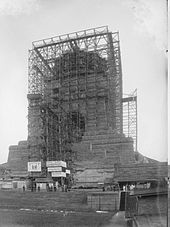
A federal empire
[edit]
The new empire was afederalunion of 25 states that varied considerably in size, demography, constitution, economy, culture, religion and socio-political development. However, even Prussia itself, which accounted for two-thirds of the territory as well as of the population, had emerged from the empire's periphery as a newcomer. It also faced colossal cultural and economic internal divisions. The Prussian provinces of Westphalia and the Rhineland for example had been under French controlduring the previous decades.The local people, who had benefited from the liberal, civil reforms, that were derived from the ideas of the French Revolution, had only little in common with predominantly rural communities in authoritarian and disjointedJunkerestates ofPommerania.[284] The inhabitants of the smaller territorial lands, especially in central and southern Germany greatly rejected the Prussianized concept of the nation and preferred to associate such terms with their individual home state. The Hanseatic port cities of Hamburg, Bremen and Lübeck ranked among the most ferocious opponents of theso-called contract with Prussia.As advocates of free trade, they objected to Prussian ideas of economic integration and refused to sign the renewedZollverein(Custom Union) treaties until 1888.[285]TheHanseaticmerchants' overseas economic success corresponded with their globalist mindset. The citizen of Hamburg, whom Bismark characterized asextremely irritatingand the German ambassador in London asthe worst Germans we have,were particularly appalled by Prussian militarism and its unopposed growing influence.[286][unreliable source?]
The Prusso-German authorities were aware of necessary integration concepts as the results and the 52%voter turnoutof thefirst imperial electionshad clearly demonstrated. Historians increasingly argue, that the nation-state wasforged through empire.[287]National identity was expressed in bombastic imperialstone iconographyand was to be achieved as an imperial people, withan emperor as head of state and it was to develop imperial ambitions– domestic, European and global.[288][287]
Bismarck's domestic policies as Chancellor of Germany were based on his effort to universally adopt the idea of the Protestant Prussian state and achieve the clear separation of church and state in all imperial principalities. In theKulturkampf(lit.: culture struggle) from 1871 to 1878, he tried to minimize the influence of the Roman Catholic Church and its political arm, theCatholic Centre Party,via secularization of all education and introduction of civil marriage, but without success. The Kulturkampf antagonised many Protestants as well as Catholics and was eventually abandoned. The millions of non-German imperial subjects, like the Polish, Danish and French minorities, were left with no choice but to endure discrimination or accept[289][290]the policies ofGermanisation.
A three-class system: Aristocracy, middle class, and working class
[edit]The new Empire provided attractive top level career opportunities for the national nobility in the various branches of the consular and civil services and the army. As a consequence the aristocratic near total control of the civil sector guaranteed a dominant voice in the decision making in the universities and the churches. The 1914 German diplomatic corps consisted of 8 princes, 29 counts, 20 barons, 54 representants of the lower nobility and a mere 11 commoners. These commoners were indiscriminately recruited from elite industrialist and banking families. The consular corps employed numerous commoners, that however, occupied positions of little to no executive power.[291]The Prussian tradition to reserve the highest military ranks for young aristocrats was adopted and the newconstitutionput all military affairs under the direct control of the Emperor and beyond control of the Reichstag.[292]With its large corps of reserve officers across Germany, the military strengthened its role as"The estate which upheld the nation",and historianHans-Ulrich Wehleradded:"it became an almost separate, self-perpetuating caste".[293]
Power increasingly was centralized among the 7000 aristocrats, who resided in the national capital ofBerlin and neighboring Potsdam.Berlin's rapidly increasing rich middle-class copied the aristocracy and tried to marry into it. A peerage could permanently boost a rich industrial family into the upper reaches of the establishment.[294]However, the process tended to work in the other direction as the nobility became industrialists. For example, 221 of the 243 mines in Silesia were owned by nobles or by the King of Prussia himself.[295]
Themiddle classin the cities grew exponentially, although it never acquired the powerful parliamentary representation and legislative rights as in France, Britain or the United States. TheAssociation of German Women's Organizationsor BDF was established in 1894 to encompass the proliferating women's organizations that had emerged since the 1860s. From the beginning the BDF was abourgeoisorganization, its members working toward equality with men in such areas as education, financial opportunities, and political life. Working-class women were not welcome and were organized by the Socialists.[296]
The rise of the Socialist Workers' Party (later known as theSocial Democratic Party of Germany,SPD), aimed to peacefully establish a socialist order through the transformation of the existing political and social conditions. From 1878, Bismarck tried to oppose the growing social democratic movement byoutlawing the party's organisation,its assemblies and most of its newspapers. Nonetheless, the Social Democrats grew stronger and Bismarck initiated hissocial welfare programin 1883 in order to appease the working class.[297]
Bismarck built on a tradition of welfare programs in Prussia and Saxony that began as early as the 1840s. In the 1880s he introduced old age pensions, accident insurance, medical care, and unemployment insurance that formed the basis of the modernEuropean welfare state.His paternalistic programs won the support of German industry because its goals were to win the support of the working classes for the Empire and reduce the outflow of immigrants to America, where wages were higher but welfare did not exist.[298][299]Bismarck further won the support of both industry and skilled workers by his high tariff policies, which protected profits and wages from American competition, although they alienated the liberal intellectuals who wanted free trade.[300][301]
Kulturkampf
[edit]
Bismarck would not tolerate any power outside Germany—as in Rome—having a say in domestic affairs. He launched theKulturkampf( "culture war" ) against the power of the pope and the Catholic Church in 1873, but only in the state of Prussia. This gained strong support from German liberals, who saw the Catholic Church as the bastion of reaction and their greatest enemy. The Catholic element, in turn, saw in theNational-Liberalsthe worst enemy and formed theCenter Party.[302]
Catholics, although nearly a third of the national population, were seldom allowed to hold major positions in the Imperial government, or the Prussian government. After 1871, there was a systematic purge of the remaining Catholics; in the powerful interior ministry, which handled all police affairs, the only Catholic was a messenger boy. Jews were likewise heavily discriminated against.[303][304]
Most of the Kulturkampf was fought out in Prussia, but Imperial Germany passed thePulpit Lawwhich made it a crime for any cleric to discuss public issues in a way that displeased the government. Nearly all Catholic bishops, clergy, and laymen rejected the legality of the new laws and defiantly faced the increasingly heavy penalties and imprisonments imposed by Bismarck's government. Historian Anthony Steinhoff reports the casualty totals:
As of 1878, only three of eight Prussian dioceses still had bishops, some 1,125 of 4,600 parishes were vacant, and nearly 1,800 priests ended up in jail or in exile... Finally, between 1872 and 1878, numerous Catholic newspapers were confiscated, Catholic associations and assemblies were dissolved, and Catholic civil servants were dismissed merely on the pretence of having Ultramontane sympathies.[305]
Bismarck underestimated the resolve of the Catholic Church and did not foresee the extremes that this struggle would attain.[306][307]The Catholic Church denounced the harsh new laws as anti-Catholic and mustered the support of its rank and file voters across Germany. In the following elections, the Center Party won a quarter of the seats in the Imperial Diet.[308]The conflict ended after 1879 because Pope Pius IX died in 1878 and Bismarck broke with the Liberals to put his main emphasis on tariffs, foreign policy, andattacking socialists.Bismarck negotiated with the conciliatory new popeLeo XIII.[309]Peace was restored, the bishops returned and the jailed clerics were released. Laws were toned down or taken back, but the laws concerning education, civil registry of marriages and religious disaffiliation remained in place. The Center Party gained strength and became an ally of Bismarck, especially when he attacked socialism.[310]
Historians have cited the campaign against the Catholic church, as well as a similar campaign against theSocial Democratic Party,as leaving a lasting influence on the German consciousness, whereby national unity can be encouraged by excluding or persecuting a minority. This strategy, later referred to as "negative integration", set a tone of either being loyal to the government or an enemy of the state, which directly influenced German nationalist sentiment and the later Nazi movement.[311]
Foreign policies and relations
[edit]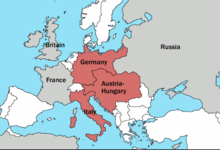
Chancellor Bismarck's imperial foreign policy basically aimed at security and the prevention of a Franco-Russian alliance, in order to avoid a likelyTwo-front war.TheLeague of Three Emperorswas signed in 1873 by Russia, Austria, and Germany. It stated thatrepublicanismandsocialismwere common enemies and that the three powers would discuss any matters concerning foreign policy. Bismarck needed good relations with Russia in order to keep France isolated. Russia fought a victoriouswar against the Ottoman Empirefrom 1877 to 1878 and attempted toestablishthePrincipality of Bulgaria,that was strongly opposed by France and Britain in particular, as they were long concerned with the preservation of theOttoman Empireand Russian containment at theBosphorus Straitand the Black Sea. Germany hosted theCongress of Berlinin 1878, where a more moderate peace settlement was agreed upon.
In 1879, Germany formed theDual Alliancewith Austria-Hungary, an agreement of mutual military assistance in the case of an attack from Russia, which was not satisfied with the agreement of the Congress of Berlin. The establishment of the Dual Alliance led Russia to take a more conciliatory stance and in 1887, the so-calledReinsurance Treatywas signed between Germany and Russia. In it, the two powers agreed on mutual military support in the case that France attacked Germany or an Austrian attack on Russia. Russia turned its attention eastward to Asia and remained largely inactive in European politics for the next 25 years. In 1882, Italy, seeking supporters for its interests inNorth Africaagainst France's colonial policy, joined the Dual Alliance, which became theTriple Alliance.In return for German and Austrian support, Italy committed itself to assisting Germany in the case of a French attack.[312]
Bismarck had always argued that the acquisition of overseas colonies was impractical and the burden of administration and maintenance would outweigh the benefits. Eventually, Bismarck gave way, and a number of colonies were established in Africa (Togo,theCameroons,German South-West Africa,andGerman East Africa) and inOceania(German New Guinea,theBismarck Archipelago,and theMarshall Islands). Consequently, Bismarck initiated theBerlin Conferenceof 1885, a formal meeting of the European colonial powers, who sought to "established international guidelines for the acquisition of African territory" (seeColonisation of Africa). Its outcome, theGeneral Act of the Berlin Conference,can be seen as the formalisation of the "Scramble for Africa" and "New Imperialism".[313]
Wilhelminian Era (1888–1918)
[edit]Wilhelm II
[edit]
Emperor William I died in 1888. His sonFrederick III,open for a more liberal political course, reigned only for ninety-nine days, as he was stricken with throat cancer and died three months after his coronation. His sonWilhelm IIfollowed him on the throne at the age of 29. Wilhelm rejected the liberal ideas of his parents and embarked on a conservative autocratic rule. He early on decided to replace the political elite and in March 1890 he forced chancellor Bismarck into retirement.[314]Following his principle of "Personal Regiment", Wilhelm was determined to exercise maximum influence on all government affairs.[315][316][317]
Alliances and diplomacy
[edit]The youngKaiser Wilhelmset out to apply his imperialist ideas ofWeltpolitik(German:[ˈvɛltpoliˌtiːk],"world politics" ), as he envisaged a gratuitously aggressive political course to increase the empire's influence in and control over the world. After the removal of Bismarck, foreign policies were tackled with by the Kaiser and the Federal Foreign Office underFriedrich von Holstein.Wilhelm's increasingly erratic and reckless conduct was unmistakably related to character deficits and the lack of diplomatic skills.[318][319]The foreign office's rather sketchy assessment of the current situation and its recommendations for the empire's most suitable course of action were:
First a long-term coalition between France and Russia had to fall apart, secondly, Russia and Britain would never get together, and finally, Britain would eventually seek an alliance with Germany.
Subsequently, Wilhelm refused to renew theReinsurance Treatywith Russia. Russia promptly formed a closer relationship with France in theDual Alliance of 1894,as both countries were concerned about the novel disagreeability of Germany. Furthermore, Anglo–German relations provided, from a British point of view, no basis for any consensus as the Kaiser refused to divert from his, although somewhat peculiarly desperate and anachronistic, aggressive imperial engagement and thenaval arms racein particular. Holstein's analysis proved to be mistaken on every point and Wilhelm failed too, as he did not adopt a nuanced political dialogue. Germany was left gradually isolated and dependent on theTriple Alliance,with Austria-Hungary and Italy. This agreement was hampered by differences between Austria and Italy and in 1915 Italy left the alliance.[250]
In 1897, AdmiralAlfred von Tirpitz,state secretary of theGerman Imperial Naval Officedevised his initially rather practical, yet nonethelessambitious planto build a sizeable naval force. Although basically posing only an indirect threat as aFleet in being,Tirpitz theorized, that its mere existence would force Great Britain, dependent on unrestricted movement on the seas, to agree to diplomatic compromises.[320]Tirpitz started the program of warship construction in 1898 and enjoyed the full support of Kaiser Wilhelm. Wilhelm entertained less rational ideas on the fleet, that circled around his romantic childhood dream to have a "fleet of [his] own some day" and his obsessive adherence to direct his policies along the line ofAlfred Thayer Mahan's workThe Influence of Sea Power upon History.[321]In exchange for the eastern African island ofZanzibar,Germany had bargained the island ofHeligolandin theGerman Bightwith Britain in 1890, and converted the island into a naval base and installed immense coastal defense batteries. Britain considered the imperial German endeavours to be a dangerous infringement on the century-old delicate balance of global affairs and trade on the seas under British control. The British, however, resolved to keep up thenaval arms raceand introduced the highly advanced newDreadnoughtbattleship concept in 1907. Germany quickly adopted the concept and by 1910 the arms race again escalated.[322][323]
In theFirst Moroccan Crisisof 1905, Germany nearly clashed with Britain and France when the latter attempted to establish a protectorate over Morocco. Kaiser Wilhelm II was upset at having not been informed about French intentions, and declared their support for Moroccan independence. William II made a highly provocative speech regarding this. The following year, a conference was held in which all of the European powers except Austria-Hungary (by now little more than a German satellite) sided with France. A compromise was brokered by the United States where the French relinquished some, but not all, control over Morocco.[324]
TheSecond Moroccan Crisisof 1911 saw another dispute over Morocco erupt when France tried to suppress a revolt there. Germany, still smarting from the previous quarrel, agreed to a settlement whereby the French ceded some territory in central Africa in exchange for Germany's renouncing any right to intervene in Moroccan affairs. This confirmed French control over Morocco, which became a full protectorate of that country in 1912.[325]
Economy
[edit]
By 1890, the economy continued to industrialize and grow on an even higher rate than during the previous two decades and increased dramatically in the years leading up to World War I. Growth rates for the individual branches and sectors often varied considerably, and periodical figures provided by theKaiserliches Statistisches Amt( "Imperial Statistical Bureau) are often disputed or just assessments. Classification and naming of internationally traded commodities and exported goods was still in progress and the structure of production and export had changed during four decades. Published documents provide numbers such as: The proportion of goods manufactured by the modern industry was approximately 25% in 1900, while the proportion of consumer related products in manufactured exports stood at 40%.[326]Reasonably exact are the figures for the entire industrial production between 1870 and 1914, which increased about 500%.[327]
Historian J. A. Perkins argued that more important than Bismarck's new tariff on imported grain was the introduction of the sugar beet as a main crop. Farmers quickly abandoned traditional, inefficient practices in favor of modern methods, including the use of artificial fertilizers and mechanical tools. Intensive methodical farming of sugar and other root crops made Germany the most efficient agricultural producer in Europe by 1914. Even so, farms were usually small in size and women did much of the field work. An unintended consequence was the increased dependence on migratory, especially foreign, labor.[328][329]

The basics of the modern chemical research laboratory layout and the introduction of essential equipment and instruments such asBunsen burners,thePetri dish,theErlenmeyer flask,task-oriented working principles and team research originated in 19th-century Germany and France. The organisation of knowledge acquisition was further refined by laboratory integration in research institutes of the universities and the industries. Germany acquired the leading role in the world'schemical industryby the late 19th century through strictly organized methodology. In 1913, the German chemical industry produced almost 90 per cent of the global supply ofdyestuffsand sold about 80 per cent of its production abroad.[330][331]
Germany became Europe's leading steel-producing nation in the 1890s, thanks in large part to the protection from American and British competition afforded by tariffs and cartels.[332]The leading firm was "Friedrich Krupp AG Hoesch-Krupp", run by theKrupp family.[333]The merger of several major firms into theVereinigte Stahlwerke(United Steel Works) in 1926 was modeled on theU.S. Steelcorporation in the United States. The new company emphasized rationalization of management structures and modernization of the technology; it employed a multi-divisional structure and used return on investment as its measure of success. By 1913, American and German exports dominated the world steel market, as Britain slipped to third place.[334]
In machinery, iron and steel, and other industries, German firms avoided cut-throat competition and instead relied on trade associations. Germany was a world leader because of its prevailing "corporatist mentality", its strong bureaucratic tradition, and the encouragement of the government. These associations regulate competition and allowed small firms to function in the shadow of much larger companies.[335]
Colonies
[edit]
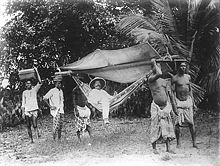
By the 1890s, German colonial expansion in Asia and the Pacific (Kiauchauin China, theMarianas,theCaroline Islands,Samoa) led to frictions with Britain, Russia, Japan and the United States.[336]The construction of theBaghdad Railway,financed by German banks, was designed to eventually connect Germany with the Turkish Empire and thePersian Gulf,but it also collided with British and Russian geopolitical interests.[337]
The largest colonial enterprises were in Africa.[338]The harsh treatment of theNamaandHereroin what is nowNamibiain Africa in 1906–1907 led to charges of genocide against the Germans. Historians are examining the links and precedents between theHerero and Namaqua Genocideand theHolocaustof the 1940s.[339][340][341]
Other claimed territories of the German Colonial Empire are:Bear Island(occupied in 1899),[342]Togo-Hinterlands,[343]German Somali Coast,[344]Katanga Territories,Pondoland(failed attempt byEmil Nagel),[345]Nyassaland (Mozambique), Southwestern Madagascar,[346]Santa Lucia Bay (South Africa) (failed attempt in 1884),[347]and the Farasan Islands.[348]
World War I
[edit]
Causes
[edit]Ethnic demands for nation states upset the balance between the empires that dominated Europe,leading to World War I,which started in August 1914. Germany stood behind its ally Austria in a confrontation with Serbia, but Serbia was under the protection of Russia, which was allied to France. Germany was the leader of the Central Powers, which included Austria-Hungary, the Ottoman Empire, and later Bulgaria; arrayed against them were the Allies, consisting chiefly of Russia, France, Britain, and in 1915 Italy.
In explaining why neutral Britain went to war with Germany, author Paul M. Kennedy recognized it was critical for war that Germany become economically more powerful than Britain, but he downplays the disputes over economic trade imperialism, the Baghdad Railway, confrontations in Central and Eastern Europe, high-charged political rhetoric and domestic pressure-groups. Germany's reliance time and again on sheer power, while Britain increasingly appealed to moral sensibilities, played a role, especially in seeing the invasion of Belgium as a necessary military tactic or a profound moral crime. The German invasion of Belgium was not important because the British decision had already been made and the British were more concerned with the fate of France. Kennedy argues that by far the main reason was London's fear that a repeat of 1870 – when Prussia and the German states smashed France – would mean that Germany, with a powerful army and navy, would control the English Channel and northwest France. British policy makers insisted that would be a catastrophe for British security.[349]
Western Front
[edit]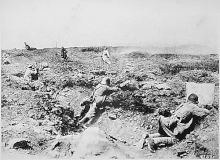
In the west, Germany sought a quick victory by encircling Paris using theSchlieffen Plan.But it failed due to Belgian resistance, Berlin's diversion of troops, and very stiff French resistance on theMarne,north of Paris. TheWestern Frontbecame an extremely bloody battleground oftrench warfare.The stalemate lasted from 1914 until early 1918, with ferocious battles that moved forces a few hundred yards at best along a line that stretched from theNorth Seato the Swiss border. The British imposed a tight naval blockade in the North Sea which lasted until 1919, sharply reducing Germany's overseas access to raw materials and foodstuffs. Food scarcity became a serious problem by 1917.[350]The United States joined with the Allies in April 1917. The entry of the United States into the war – following Germany's declaration of unrestricted submarine warfare – marked a decisive turning-point against Germany.[351]
Total casualties on the Western Front were 3,528,610 killed and 7,745,920 wounded.[352]
Eastern Front
[edit]More wide open was the fighting on theEastern Front.In the east, there were decisive victories against the Russian army, the trapping and defeat of large parts of the Russian contingent at theBattle of Tannenberg,followed by huge Austrian and German successes. The breakdown of Russian forces – exacerbated by internal turmoil caused by the 1917Russian Revolution– led to theTreaty of Brest-Litovskthe Bolsheviks were forced to sign on 3 March 1918 as Russia withdrew from the war. It gave Germany control of Eastern Europe. Spencer Tucker says, "The German General Staff had formulated extraordinarily harsh terms that shocked even the German negotiator."[353]When Germany later complained that theTreaty of Versaillesof 1919 was too harsh on them, the Allies responded that it was more benign than Brest-Litovsk.[354]
1918
[edit]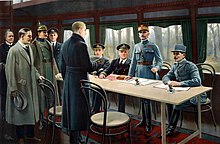
By defeating Russia in 1917, Germany was able to bring hundreds of thousands of combat troops from the east to the Western Front, giving it a numerical advantage over the Allies. By retraining the soldiers in new storm-trooper tactics, the Germans expected to unfreeze the Battlefield and win a decisive victory before the American army arrived in strength.[355]However, the spring offensives all failed, as the Allies fell back and regrouped, and the Germans lacked the reserves necessary to consolidate their gains. In the summer, with the Americans arriving at 10,000 a day, and the German reserves exhausted, it was only a matter of time before multiple Allied offenses destroyed the German army.[356]
Homefront
[edit]Although war was not expected in 1914, Germany rapidly mobilized its civilian economy for the war effort, the economy was handicapped by the British blockade that cut off food supplies.[357]
Steadily conditions deteriorated rapidly on the home front, with severe food shortages reported in all urban areas. Causes involved the transfer of many farmers and food workers into the military, an overburdened railroad system, shortages of coal, and especially the British blockade that cut off imports from abroad. The winter of 1916–1917 was known as the "turnip winter", because that vegetable, usually fed to livestock, was used by people as a substitute for potatoes and meat, which were increasingly scarce. Thousands of soup kitchens were opened to feed the hungry people, who grumbled that the farmers were keeping the food for themselves. Even the army had to cut the rations for soldiers.[358]Morale of both civilians and soldiers continued to sink. According to historianWilliam H. MacNeil:
- By 1917, after three years of war, the various groups and bureaucratic hierarchies which had been operating more or less independently of one another in peacetime (and not infrequently had worked at cross purposes) were subordinated to one (and perhaps the most effective) of their number: the General Staff. Military officers controlled civilian government officials, the staffs of banks, cartels, firms, and factories, engineers and scientists, workingmen, farmers-indeed almost every element in German society; and all efforts were directed in theory and in large degree also in practice to forwarding the war effort.[359]
1918 was the year of the deadly1918 Spanish Flu pandemicwhich struck hard at a population weakened by years of malnutrition.
Revolution 1918
[edit]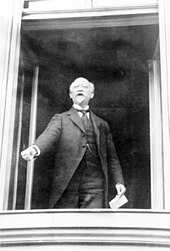
The end of October 1918, inWilhelmshaven,in northern Germany, saw the beginning of theGerman Revolution of 1918–1919.Units of the German Navy refused to set sail for a last, large-scale operation in a war which they saw as good as lost, initiating the uprising. On 3 November, the revolt spread to other cities and states of the country, in many of whichworkers' and soldiers' councilswere established. Meanwhile, Hindenburg and the senior commanders had lost confidence in the Kaiser and his government. The Kaiser and all German ruling princes abdicated. On 9 November 1918, the Social DemocratPhilipp Scheidemannproclaimed a Republic.
On 11 November,the Compiègne armisticewas signed, ending the war. TheTreaty of Versailleswas signed on 28 June 1919. Germany was to cede Alsace-Lorraine to France. Eupen-Malmédy would temporarily be ceded to Belgium, with a plebiscite to be held to allow the people the choice of the territory either remaining with Belgium or being returned to German control. Following a plebiscite, the territory was allotted to Belgium on 20 September 1920. The future ofNorth Schleswigwas to be decided by plebiscite. In theSchleswig Plebiscites,the Danish-speaking population in the north voted for Denmark and the southern, German speaking populace, part voted for Germany. Schleswig was thus partitioned. Holstein remained German without a referendum.Memelwas ceded to the Allied and Associated powers, to decide the future of the area. On 9 January 1923, Lithuanian forces invaded the territory. Following negotiations, on 8 May 1924, the League of Nations ratified the annexation on the grounds that Lithuania accepted theMemel Statute,a power-sharing arrangement to protect non-Lithuanians in the territory and its autonomous status. Until 1929, German-Lithuanian co-operation increased and this power-sharing arrangement worked. Poland was restored and most of the provinces ofPosenandWest Prussia,and some areas ofUpper Silesiawere reincorporated into the reformed country after plebiscites and independence uprisings. All German colonies were to be handed over to League of Nations, who then assigned them asMandatesto Australia, France, Japan, New Zealand, Portugal, and the United Kingdom. The new owners were required to act as disinterested trustee over the region, promoting the welfare of its inhabitants in a variety of ways until they were able to govern themselves. The left and right banks of the Rhine were to be permanently demilitarised. The industrially importantSaarlandwas to be governed by theLeague of Nationsfor 15 years and its coalfields administered by France. At the end of that time a plebiscite was to determine the Saar's future status. To ensure the execution of the treaty's terms, Allied troops would occupy the left (German) bank of the Rhine for a period of 5–15 years. The German army was to be limited to 100,000 officers and men; the general staff was to be dissolved; vast quantities of war material were to be handed over and the manufacture of munitions rigidly curtailed. The navy was to be similarly reduced, and no military aircraft were allowed. Germany was also required to payreparationsfor all civilian damage caused during the war.
Weimar Republic, 1918–1933
[edit]Overview
[edit]
The humiliating peace terms in theTreaty of Versaillesprovoked bitter indignation throughout Germany, and seriously weakened the new democratic regime. In December 1918, theCommunist Party of Germany(KPD) was founded, and in 1919 it tried and failed to overthrow the new republic.Adolf Hitlerin 1919 took control of the newNational Socialist German Workers' Party(NSDAP), which failed in acoup in Munich in 1923.Both parties, as well as parties supporting the republic, built militant auxiliaries that engaged in increasingly violent street battles. Electoral support for both parties increased after 1929 as the Great Depression hit the economy hard, producing many unemployed men who became available for the paramilitary units. The Nazis (NSDAP), with a mostly rural and lower middle class base, came to power by appearing to work within the Weimar constitution[360]and ruled Germany from 1933 to 1945.
The early years
[edit]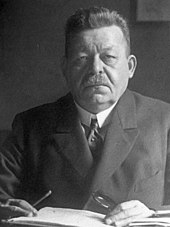
On 11 August 1919, theWeimarconstitution came into effect, withFriedrich Ebertas first President.
On 30 December 1918, theCommunist Party of Germanywas founded by theSpartacus League,who had split from the Social Democratic Party during the war. It was headed byRosa LuxemburgandKarl Liebknecht,and rejected the parliamentary system. In 1920, about 300,000 members from theIndependent Social Democratic Party of Germanyjoined the party, transforming it into a mass organization. The Communist Party had a following of about 10% of the electorate.[361]
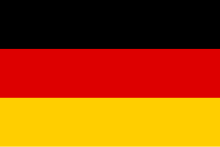
In the first months of 1920, theReichswehrwas to be reduced to 100,000 men, in accordance with the Treaty of Versailles. This included the dissolution of manyFreikorps– units made up of volunteers. In an attempt at a coup d'état in March 1920, theKapp Putsch,extreme right-wing politician Wolfgang Kapp let Freikorps soldiers march on Berlin and proclaimed himself Chancellor of the Reich. After four days the coup d'état collapsed, due to popular opposition and lack of support by the civil servants and the officers. Other cities were shaken by strikes and rebellions, which were bloodily suppressed.
Germany was the first state to establish diplomatic relations with the newSoviet Union.Under theTreaty of Rapallo,Germany accorded the Soviet Unionde jurerecognition, and the two signatories mutually cancelled all pre-war debts and renounced war claims. For the next twenty years Russia and Germany would work together helping to re-establish a military build up in Germany, and assist Russia in creating an industrial power under the weight of centralised planning of Lenin's communism.

When Germany defaulted on its reparation payments, French and Belgian troops occupied the heavily industrialised Ruhr district (January 1923). The German government encouraged the population of the Ruhr to engage inpassive resistance:shops would not sell goods to the foreign soldiers, coal-miners would not dig for the foreign troops, trams in which members of the occupation army had taken a seat would be left abandoned in the middle of the street. The passive resistance proved effective, insofar as the occupation became a loss-making deal for the French government. But the Ruhr fight also helped fuelhyperinflation,[362]and many who lost all their fortune would become bitter enemies of the Weimar Republic and voters of the anti-democratic right. See1920s German inflation.
In September 1923, the deteriorating economic conditions led ChancellorGustav Stresemannto call an end to the passive resistance in the Ruhr. In November, his government introduced a new currency, theRentenmark(later:Reichsmark), together with other measures to stop the hyperinflation. In the following six years the economic situation improved. In 1928, Germany's industrial production even regained the pre-war levels of 1913.
The national elections of 1924 led to a swing to the right. Field MarshalPaul von HindenburgwaselectedPresident in 1925.
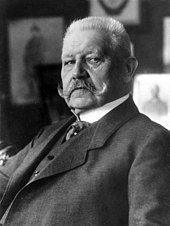
In October 1925, theTreaty of Locarnowas signed by Germany, France, Belgium, Britain and Italy; it recognised Germany's borders with France and Belgium. Moreover, Britain, Italy and Belgium undertook to assist France in the case that German troops marched into the demilitarised Rheinland. Locarno paved the way for Germany's admission to theLeague of Nationsin 1926.
Reparations
[edit]The actual amount of reparations that Germany was obliged to pay out was not the 132 billion marks decided in the London Schedule of 1921 but rather the 50 billion marks stipulated in the A and B Bonds. Historian Sally Marks says the "C bonds" were entirely chimerical—a device to fool the public into thinking Germany would pay much more. The actual total payout from 1920 to 1931 (when payments were suspended indefinitely) was 20 billionGerman gold marks,worth about US$5 billion or £1 billionstg.12.5 billion was cash that came mostly from loans from New York bankers. The rest was goods like coal and chemicals, or from assets like railway equipment. The reparations bill was fixed in 1921 on the basis of a German capacity to pay, not on the basis of Allied claims. The highly publicized rhetoric of 1919 about paying for all the damages and all the veterans' benefits was irrelevant for the total, but it did determine how the recipients spent their share. Germany owed reparations chiefly to France, Britain, Italy and Belgium; the US received $100 million.[363]
Economic collapse and political problems, 1929–1933
[edit]TheWall Street Crash of 1929marked the beginning of the worldwideGreat Depression,which hit Germany as hard as any nation. In July 1931, theDanat-Bank– one of the biggest German banks – failed. In early 1932, the number of unemployed had soared to more than 6,000,000.
On top of the collapsing economy came a political crisis: theproportional representationthat the political system operated on meant that for every 60,000 votes a party received, it earned a seat in theReichstag.This resulted in a disparate and myriad collection of minor parties that struggled to cooperate.[364]The political parties represented in theReichstagwere unable to build a governing majority in the face of escalating extremism from both the far right (the Nazis, NSDAP) and the far left (Communist Party of Germany).[365]In March 1930, President Hindenburg appointedHeinrich BrüningChancellor. To push through a package of austerity measures against a majority of Social Democrats, Communists and the NSDAP (Nazis), Brüning and Hindenburg made use of emergency decrees provided for inarticle 48of Weimar's constitution. They also used the power to prematurely dissolve Parliament. In March and April 1932, Hindenburg was re-elected in theGerman presidential election of 1932.[366]
The Nazi Party was the largest party in the national elections of 1932. On 31 July 1932 it received 37.3% of the votes, and in the election on 6 November 1932 it received less, but still the largest share, 33.1%, making it the biggest party in theReichstag.The Communist KPD came third, with 15%.[367]Together, the anti-democratic parties of the far right were now able to hold a considerable share of seats in Parliament, but they were at sword's point with the political left, fighting it out in the streets. The Nazis were particularly successful among Protestants, among unemployed young voters, among the lower middle class in the cities and among the rural population. It was weakest in Catholic areas and in large cities. On 30 January 1933, pressured by former ChancellorFranz von Papenand other conservatives, President Hindenburg appointed Hitler as Chancellor.[368]
Science and culture in 19th and 20th century
[edit]The Weimar years saw a flowering ofGerman scienceand high culture, before the Nazi regime resulted in a decline in the scientific and cultural life in Germany and forced many renowned scientists and writers to flee. German recipients dominated theNobel prizes in science.[369]Germany dominated the world of physics before 1933, led byHermann von Helmholtz,Wilhelm Conrad Röntgen,Albert Einstein,Otto Hahn,Max PlanckandWerner Heisenberg.Chemistry likewise was dominated by German professors and researchers at the great chemical companies such asBASFandBayerand persons likeJustus von Liebig,Fritz HaberandEmil Fischer.Theoretical mathematiciansGeorg Cantorin the 19th century andDavid Hilbertin the 20th century.Karl Benz,the inventor of the automobile, andRudolf Dieselwere pivotal figures of engineering, andWernher von Braun,rocket engineer.Ferdinand Cohn,Robert KochandRudolph Virchowwere three key figures in microbiology.
Among the most important German writers wereThomas Mann,Hermann HesseandBertolt Brecht.The reactionary historianOswald SpenglerwroteThe Decline of the West(1918–1923) on the inevitable decay of Western Civilization, and influenced intellectuals in Germany such asMartin Heidegger,Max Scheler,and theFrankfurt School,as well as intellectuals around the world.[370]
After 1933, Nazi proponents of "Aryan physics",led by the Nobel Prize-winnersJohannes StarkandPhilipp Lenard,attacked Einstein's theory of relativity as a degenerate example of Jewish materialism in the realm of science. Many scientists and humanists emigrated; Einstein moved permanently to the U.S. but some of the others returned after 1945.[371][372]
Nazi Germany, 1933–1945
[edit]
The Nazi regime suppressed labor unions and strikes, leading to prosperity which gave theNazi Partypopularity, with only minor, isolated and subsequently unsuccessful cases ofresistance among the German populationover their rule. TheGestapo(secret police) destroyed the political opposition and persecuted the Jews, trying to force them into exile. The Party took control of the courts, local government, and all civic organizations except the Christian churches. All expressions of public opinion were controlled the propaganda ministry, which used film, mass rallies, and Hitler's hypnotic speaking. The Nazi state idolized Hitler as its Führer (leader), putting all powers in his hands.Nazi propagandacentered on Hitler and created the "Hitler Myth" —that Hitler was all-wise and that any mistakes or failures by others would be corrected when brought to his attention.[373]In fact Hitler had a narrow range of interests and decision making was diffused among overlapping, feuding power centers; on some issues he was passive, simply assenting to pressures from whoever had his ear. All top officials reported to Hitler and followed his basic policies, but they had considerable autonomy on a daily basis.[374]
Establishment of the Nazi regime
[edit]
To secure aReichstagmajority for his party, Hitler called for new elections. After the 27 February 1933Reichstag fire,Hitler swiftly blamed an alleged Communist uprising, and convinced President Hindenburg to approve theReichstag Fire Decree,rescinding civil liberties. Four thousandcommunistswere arrested[375]and Communist agitation was banned. Communists and Socialists were brought into hastily preparedNazi concentration camps,where they were at the mercy of theGestapo,the newly established secret police force. CommunistReichstagdeputies were taken into "protective custody".
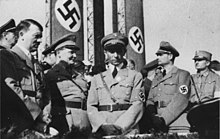
Despite the terror and unprecedented propaganda, the last free General Elections of 5 March 1933, while resulting in 43.9% failed to give the Nazis their desired majority. Together with theGerman National People's Party(DNVP), however, he was able to form a slim majority government. On 23 March 1933, theEnabling Actmarked the beginning of Nazi Germany,[376]allowing Hitler and his cabinet to enact laws on their own without the President or the Reichstag.[377]The Enabling Act formed the basis for the dictatorship and the dissolution of theLänder.Trade unions and all political parties other than the Nazi Party were suppressed. A centralised totalitarian state was established, no longer based on the liberalWeimarconstitution. Germany withdrew from theLeague of Nationsshortly thereafter. The coalition parliament was rigged by defining the absence of arrested and murdered deputies as voluntary and therefore cause for their exclusion as wilful absentees. The Centre Party was voluntarily dissolved in aquid pro quowith thePopeunder theanti-communistPope Pius XIfor theReichskonkordat;and by these manoeuvres Hitler achieved movement of these Catholic voters into the Nazi Party, and a long-awaited international diplomatic acceptance of his regime. The Nazis gained a larger share of their vote in Protestant areas than in Catholic areas.[378]The Communist Party was proscribed in April 1933.
Hitler used theSSand Gestapo to purge the entire SA leadership—along with a number of Hitler's political adversaries in theNight of the Long Knivesfrom 30 June to 2 July 1934.[379]As a reward, the SS became an independent organisation under the command of theReichsführer-SSHeinrich Himmler.Upon Hindenburg's death on 2 August 1934, Hitler's cabinet passed a law proclaiming the presidency to be vacant and transferred the role and powers of the head of state to Hitler.
Antisemitism and the Holocaust
[edit]
The Nazi regime was particularly hostile towards Jews, who became the target of unendingantisemiticpropaganda attacks. The Nazis attempted to convince the German people to view and treat Jews as "subhumans"[380]and immediately after the1933 federal electionsthe Nazis imposed a nationwideboycott of Jewish businesses.In March 1933 the firstNazi concentration campwas established atDachau[381]and from 1933 to 1935 the Nazi regime consolidated their power. TheLaw for the Restoration of the Professional Civil Serviceforced all Jewish civil servants to retire from the legal profession and the civil service.[382]TheNuremberg Lawsbanned sexual relations between Jews and Germans and only those of German or related blood were eligible to be considered citizens; the remainder were classed as state subjects, without citizenship rights.[383]This stripped Jews,Romaniand others of their legal rights.[384]Jews continued to suffer persecution under the Nazi regime, exemplified by theKristallnacht pogromof 1938, and about half of Germany's 500,000 Jews fled the country before 1939, after which escape became almost impossible.[385]
In 1941, the Nazi leadership decided to implement a plan that they called the "Final Solution"which came to be known as theHolocaust.Under the plan, Jews and other "lesser races" along with political opponents from Germany as well asoccupied countrieswere systematically murdered at murder sites, and starting in 1942, atextermination camps.[386]Between 1941 and 1945 Jews, Gypsies, Slavs, communists, homosexuals, the mentally and physically disabled and members of other groups were targeted and methodically murdered – the origin of the word "genocide".In total approximately 11 million people were killed during the Holocaust.[387]
Military
[edit]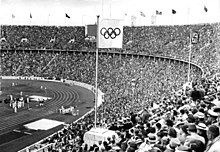
In 1935, Hitler officially re-established theLuftwaffe(air force) and reintroduced universal military service, in breach of theTreaty of Versailles;Britain, France and Italy formally protested. Hitler had the officers swear their personal allegiance to him.[388]In 1936, German troopsmarched into the demilitarised Rhineland.[389]As the territory was part of Germany, the British and French governments did not feel that attempting to enforce the treaty was worth the risk of war.[390]The move strengthened Hitler's standing in Germany. His reputation swelled further with the1936 Summer Olympicsin Berlin, and proved another great propaganda success for the regime as orchestrated by master propagandistJoseph Goebbels.[391]
Foreign policy
[edit]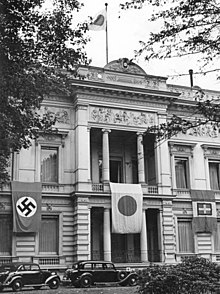
Hitler's diplomatic strategy in the 1930s was to make seemingly reasonable demands, threatening war if they were not met. When opponents tried to appease him, he accepted the gains that were offered, then went to the next target. That aggressive strategy worked as Germany pulled out of theLeague of Nations,rejected theVersailles Treatyand began to re-arm, won back the Saar, remilitarized the Rhineland, formed an alliance with Mussolini's Italy, sent massive military aid to Franco in the Spanish Civil War, annexed Austria, took over Czechoslovakia after the British and Frenchappeasementof the Munich Agreement, formed a peace pact withJoseph Stalin's Soviet Union, and finally invaded Poland. Britain and France declared war on Germany andWorld War IIin Europe began.[392][393]
Having established a "Rome-Berlin axis" withBenito Mussolini,and signing theAnti-Comintern Pactwith Japan – which was joined by Italy a year later in 1937 – Hitler felt able to take the offensive in foreign policy. On 12 March 1938, German troops marched into Austria, where an attempted Nazi coup had been unsuccessful in 1934. When Austrian-born Hitler enteredVienna,he was greeted by loud cheers and Austrians voted in favour of the annexation of their country. After Austria, Hitler turned toCzechoslovakia,where theSudeten Germanminority was demanding equal rights and self-government. At theMunich Conferenceof September 1938, Hitler, Mussolini, British Prime MinisterNeville Chamberlainand French Prime MinisterÉdouard Daladieragreed upon the cession of Sudeten territory to the German Reich byCzechoslovakia.Hitler thereupon declared that all of German Reich's territorial claims had been fulfilled. However, hardly six months after the Munich Agreement Hitler used the smoldering quarrel betweenSlovaksandCzechsas a pretext for taking over the rest of Czechoslovakia. He then secured the return ofMemelfromLithuaniato Germany. Chamberlain was forced to acknowledge that his policy ofappeasementtowards Hitler had failed.
World War II
[edit]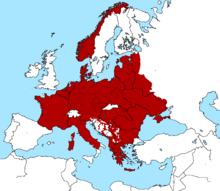
At first Germany was successful in its military operations. In less than three months (April – June 1940), Germany conqueredDenmark,Norway,the Low Countries, andFrance.The unexpectedly swift defeat of France resulted in an upswing in Hitler's popularity and an upsurge in war fever.[394][395]Hitler made peace overtures to the new British leaderWinston Churchillin July 1940, but Churchill remained dogged in his defiance with major help from U.S. PresidentFranklin D. Roosevelt.Hitler's bombing campaign against Britain (September 1940 – May 1941) failed. Some 43,000 British civilians were killed and 139,000 wounded inthe Blitz;much ofLondonwas destroyed. Germany's armed forcesinvaded the Soviet Unionin June 1941 swept forward until they reached the gates of Moscow. TheEinsatzgruppen(Nazi mobiledeath squads) executed all Soviet Jews that it located, while the Germans went to Jewish households and forced the families into concentration camps for labor or to extermination camps for death.
The tide began to turn in December 1941, when the invasion of the Soviet Union hit determined resistance in theBattle of Moscowand Hitler declared war on the United States in the wake of the JapanesePearl Harbor attack.After surrender inNorth Africaand losing theBattle of Stalingradin 1942–1943, the Germans were forced into the defensive. By late 1944, the United States, Canada, France, and Great Britain were closing in on Germany in the West, while the Soviets were victoriouslyadvancing in the East.

In 1944–1945, Soviet forces completely or partially liberatedRomania,Bulgaria,Hungary,Yugoslavia,Poland,Czechoslovakia,Austria,Denmark, andNorway.Nazi Germany collapsed asBerlin was takenby the Soviet Union's Red Army in a fight to the death on the city streets. 2,000,000 Soviet troops took part in the assault, and they faced 750,000 German troops. 78,000–305,000 Soviets were killed, while 325,000 German civilians and soldiers were killed.[396]Hitler committed suicide on 30 April 1945. The finalGerman Instrument of Surrenderwas signed on 8 May 1945, marking the end of Nazi Germany.
By September 1945, Nazi Germany and its Axis partners (mainly Italy and Japan) had all been defeated, chiefly by the forces of the Soviet Union, the United States, and Great Britain. Much of Europe lay in ruins, over 60 million people worldwide had been killed (most of them civilians), including approximately 6 million Jews and 11 million non-Jews in what became known as theHolocaust.World War II destroyed Germany's political and economic infrastructure, caused its partition, considerable loss of territory (especially in the East), and historical legacy of guilt and shame.[397]
Germany during the Cold War, 1945–1990
[edit]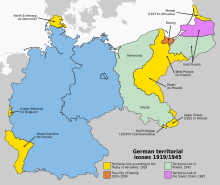
As a consequence of the defeat of Nazi Germany in 1945 and the onset of theCold Warin 1947, the country's territory was shrunk and split between the two global blocs in the East and West, a period known as the division of Germany. Millions of refugees from Central and Eastern Europe moved west, most of them to West Germany. Two countries emerged:West Germanywas a parliamentary democracy, aNATOmember, a founding member of what since became theEuropean Unionas one of the world's largest economies and under allied military control until 1955,[398]whileEast Germanywas a totalitarian Communist dictatorship controlled by the Soviet Union as a satellite of Moscow. With the collapse of Communism in Europe in 1989,reunion followed.
No one doubted Germany's economic and engineering prowess; the question was how long bitter memories of the war would cause Europeans to distrust Germany, and whether Germany could demonstrate it had rejected totalitarianism and militarism and embraced democracy and human rights.[399]
Expulsion
[edit]At thePotsdam Conference,Germany wasdivided into four military occupation zonesby the Allies and did not regain independence until 1949. The provinces east of the Oder and Neisse rivers (theOder-Neisse line) were transferred to Poland and Soviet Russia (Kaliningrad oblast) while Saarland separated from Germany to become a Frenchprotectorateon 17 December 1947 (joined West Germany on 1 January 1957), pending a final peace conference with Germany, which eventually never took place.[400]Most of the remaining German populationwas expelled.Around 6.7 million Germans living in"west-shifted" Poland,mostly within previously German lands, and the 3 million in German-settled regions of Czechoslovakia weredeported west.[401]
Post-war chaos
[edit]
The total ofGerman war deadwas 8% to 10% out of a prewar population of 69,000,000, or between 5.5 million and 7 million people. This included 4.5 million in the military, and between 1 and 2 million civilians. There was chaos as 11 million foreign workers and POWs left, while soldiers returned home and more than 14 million displaced German-speaking refugees from both the eastern provinces and East-Central and Eastern Europe were expelled from their native land and came to the western German lands, often foreign to them.[402]During theCold War,theWest Germangovernment estimated a death toll of 2.2 million civilians due to theflight and expulsion of Germansand throughforced labour in the Soviet Union.[403][404]This figure remained unchallenged until the 1990s, when some historians put the death toll at 500,000–600,000 confirmed deaths.[405]In 2006, the German government reaffirmed its position that 2.0–2.5 million deaths occurred.
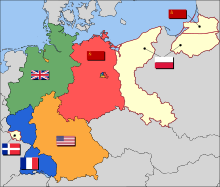
Denazificationremoved, imprisoned, or executed most top officials of the old regime, but most middle and lower ranks of civilian officialdom were not seriously affected. In accordance with the Allied agreement made at theYalta Conference,millions of POWs were used asforced laborby the Soviet Union and other European countries.[406]
In the East, the Soviets crushed dissent and imposed another police state, often employing ex-Nazis in the dreadedStasi.The Soviets extracted about 23% of the East German GNP for reparations, while in the West reparations were a minor factor.[407]
In 1945–1946 housing and food conditions were bad, as the disruption of transport, markets, and finances slowed a return to normal. In the West, bombing had destroyed the fourth of the housing stock,[408]and over 10 million refugees from the east had crowded in, most living in camps.[409]Food production in 1946–1948 was only two-thirds of the prewar level, while grain and meat shipments – which usually supplied 25% of the food – no longer arrived from the East. Furthermore, the end of the war brought the end of large shipments of food seized from occupied nations that had sustained Germany during the war. Coal production was down 60%, which had cascading negative effects on railroads, heavy industry, and heating.[410]Industrial production fell more than half and reached prewar levels only at the end of 1949.[411]
Allied economic policy originally was one ofindustrial disarmamentplus building the agricultural sector. In the western sectors, most of the industrial plants had minimal bomb damage and the Allies dismantled 5% of the industrial plants for reparations.[412]
However, deindustrialization became impractical and the U.S. instead called for a strong industrial base in Germany so it could stimulate European economic recovery.[413]The U.S. shipped food in 1945–1947 and made a $600 million loan in 1947 to rebuild German industry. By May 1946 the removal of machinery had ended, thanks to lobbying by the U.S. Army. The Truman administration finally realised that economic recovery in Europe could not go forward without the reconstruction of the German industrial base on which it had previously been dependent. Washington decided that an "orderly, prosperous Europe requires the economic contributions of a stable and productive Germany".[414][415]
In 1945, the occupying powers took over all newspapers in Germany and purged them of Nazi influence. The American occupation headquarters, the Office of Military Government, United States (OMGUS) began its own newspaper based in Munich,Die Neue Zeitung.It was edited by German and Jewish émigrés who fled to the United States before the war. Its mission was to encourage democracy by exposing Germans to how American culture operated. The paper was filled with details on American sports, politics, business, Hollywood, and fashions, as well as international affairs.[416]
East Germany
[edit]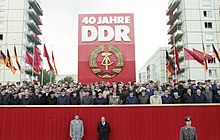
On 7 October 1949, the Soviet zone became the "Deutsche Demokratische Republik" – "DDR" ( "German Democratic Republic" – "GDR", simply often "East Germany" ), under control of the Socialist Unity Party. Neither country had a significant army until the 1950s, but East Germany built theStasiinto a powerful secret police that infiltrated every aspect of its society.[417]
East Germany was anEastern blocstate under political and military control of the Soviet Union through her occupation forces and theWarsaw Treaty.Political power was solely executed by leading members (Politburo) of the communist-controlledSocialist Unity Party(SED). A Soviet-stylecommand economywas set up; later the GDR became the most advancedComeconstate. WhileEast German propagandawas based on the benefits of the GDR's social programs and the alleged constant threat of a West German invasion, many of her citizens looked to the West for political freedoms and economic prosperity.[418]
Walter Ulbrichtwas the party Boss from 1950 to 1971. In 1933, Ulbricht had fled to Moscow, where he served as a Comintern agent loyal to Stalin. As World War II was ending, Stalin assigned him the job of designing the postwar German system that would centralize all power in the Communist Party. Ulbricht became deputy prime minister in 1949 and secretary (chief executive) of the Socialist Unity (Communist) party in 1950.[419]Some 2.6 million people had fled East Germany by 1961 when he built theBerlin Wallto stop them – shooting those who attempted it. What the GDR called the "Anti-Fascist Protective Wall" was a major embarrassment for the program during the Cold War, but it did stabilize East Germany and postpone its collapse.[420][421]Ulbricht lost power in 1971, but was kept on as a nominal head of state. He was replaced because he failed to solve growing national crises, such as the worsening economy in 1969–1970, the fear of another popular uprising as had occurred in 1953, and the disgruntlement between Moscow and Berlin caused by Ulbricht's détente policies toward the West.
The transition toErich Honecker(General Secretaryfrom 1971 to 1989) led to a change in the direction of national policy and efforts by the Politburo to pay closer attention to the grievances of the proletariat.Honecker's plans were not successful, however, with the dissent growing among East Germany's population.
In 1989, the socialist regime collapsed after 40 years, despite its omnipresent secret police, theStasi.The main reasons for its collapse included severe economic problems and growing emigration towards the West.
East Germany's culture was shaped by Communism and particularly Stalinism. It was characterized by East German psychoanalyst Hans-Joachim Maaz in 1990 as having produced a "Congested Feeling" among Germans in the East as a result of Communist policies criminalizing personal expression that deviates from government approved ideals, and through the enforcement of Communist principals by physical force and intellectual repression by government agencies, particularly the Stasi.[422]Critics of the East German state have claimed that the state's commitment to communism was a hollow and cynical tool of a ruling elite. This argument has been challenged by some scholars who claim that the Party was committed to the advance of scientific knowledge, economic development, and social progress. However, the vast majority regarded the state's Communist ideals to be nothing more than a deceptive method for government control.[422]
According to German historianJürgen Kocka(2010):
- Conceptualizing the GDR as a dictatorship has become widely accepted, while the meaning of the concept dictatorship varies. Massive evidence has been collected that proves the repressive, undemocratic, illiberal, nonpluralistic character of the GDR regime and its ruling party.[423]
West Germany (Bonn Republic)
[edit]
On 23 May 1949, thethree western occupation zones(American, British, and French) were combined into the Federal Republic of Germany (FRG, West Germany). The government was formed under ChancellorKonrad Adenauerand his conservative CDU/CSU coalition.[424]The CDU/CSU was in power during most of the period since 1949. The capital wasBonnuntil it was moved to Berlin in 1990. In 1990, FRG absorbedEast Germanyand gained full sovereignty over Berlin. At all points West Germany was much larger and richer than East Germany, which became a dictatorship under the control of the Communist Party and was closely monitored by Moscow. Germany, especially Berlin, was a cockpit of theCold War,with NATO and the Warsaw Pact assembling major military forces in west and east. However, there was never any combat.[425]
Economic miracle
[edit]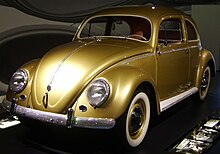
West Germany enjoyed prolonged economic growth beginning in the early 1950s (Wirtschaftswunderor "Economic Miracle" ).[426]Industrial production doubled from 1950 to 1957, and gross national product grew at a rate of 9 or 10% per year, providing the engine for economic growth of all of Western Europe. Labor unions supported the new policies with postponed wage increases, minimized strikes, support for technological modernization, and a policy ofco-determination(Mitbestimmung), which involved a satisfactory grievance resolution system as well as requiring representation of workers on the boards of large corporations.[427]The recovery was accelerated by thecurrency reform of June 1948,U.S. gifts of $1.4 billion as part of theMarshall Plan,the breaking down of old trade barriers and traditional practices, and the opening of the global market.[428]West Germany gained legitimacy and respect, as it shed the horrible reputation Germany had gained under the Nazis.
West Germany played a central role in the creation of European cooperation; it joinedNATOin 1955 and was a founding member of theEuropean Economic Communityin 1958.
1948 currency reform
[edit]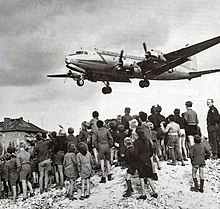
The most dramatic and successful policy event was the currency reform of 1948.[429]Since the 1930s, prices and wages had been controlled, but money had been plentiful. That meant that people had accumulated large paper assets, and that official prices and wages did not reflect reality, as the black market dominated the economy and more than half of all transactions were taking place unofficially. On 21 June 1948, the Western Allies withdrew the old currency and replaced it with the newDeutsche Markat the rate of 1 new per 10 old. This wiped out 90% of government and private debt, as well as private savings. Prices were decontrolled, and labor unions agreed to accept a 15% wage increase, despite the 25% rise in prices. The result was that prices of German export products held steady, while profits and earnings from exports soared and were poured back into the economy. The currency reforms were simultaneous with the $1.4 billion inMarshall Planmoney coming in from the United States, which was used primarily for investment.
In addition, the Marshall Plan forced German companies, as well as those in all of Western Europe, to modernize their business practices and take account of the international market. Marshall Plan funding helped overcome bottlenecks in the surging economy caused by remaining controls (which were removed in 1949), and Marshall Plan business reforms opened up a greatly expanded market for German exports. Overnight, consumer goods appeared in the stores, because they could be sold for realistic prices, emphasizing to Germans that their economy had turned a corner.[409]
The success of the currency reform angered the Soviets, who cut off all road, rail, and canal links between the western zones andWest Berlin.This was theBerlin Blockade,which lasted from 24 June 1948 to 12 May 1949. In response, the U.S. and Britain launched an airlift of food and coal and distributed the new currency in West Berlin as well. The city thereby became economically integrated into West Germany.[430]Until the mid-1960s, it served as "America's Berlin", symbolizing the United States' commitment to defending its freedom, which John F. Kennedy underscored during his visit in June 1963.[431]
Adenauer
[edit]
Konrad Adenauerwas the dominant leader in West Germany.[432]He was the first chancellor (top official) of the FRG and until his death was the founder and leader of the Christian Democratic Union (CDU), a coalition of conservatives,ordoliberals,and adherents of Protestant andCatholic social teachingthat dominated West Germany politics for most of its history. During his chancellorship, the West Germany economy grew quickly, and West Germany established friendly relations with France, participated in the emergingEuropean Union,established the country's armed forces (theBundeswehr), and became a pillar ofNATOas well as firm ally of the United States. Adenauer's government also commenced the long process of reconciliation with the Jews andIsraelafter the Holocaust.[433]
Erhard
[edit]Ludwig Erhardwas in charge of economic policy as economics director for the British and American occupation zones and was Adenauer's long-time economics minister. Erhard's decision to lift many price controls in 1948 (despite opposition from both the social democratic opposition and Allied authorities), plus his advocacy of free markets, helped set the Federal Republic on its strong growth from wartime devastation.[434]Norbert Walter, a former chief economist atDeutsche Bank,argues that "Germany owes its rapid economic advance after World War II to the system of the Social Market Economy, established by Ludwig Erhard."[435][436]Erhard was politically less successful when he served as the CDU Chancellor from 1963 until 1966. Erhard followed the concept of asocial market economy,and was in close touch with professional economists. Erhard viewed the market itself as social and supported only a minimum of welfare legislation. However, Erhard suffered a series of decisive defeats in his effort to create a free, competitive economy in 1957; he had to compromise on such key issues as the anti-cartel legislation. Thereafter, the West German economy evolved into a conventional west European welfare state.[437]
Meanwhile, in adopting theGodesberg Programin 1959, theSocial Democratic Party of Germany(SPD) largely abandoned Marxism ideas and embraced the concept of themarket economyand the welfare state. Instead it now sought to move beyond its old working class base to appeal the full spectrum of potential voters, including the middle class and professionals. Labor unionscooperatedincreasingly with industry, achieving labor representation on corporate boards and increases in wages and benefits.[438]
Grand coalition
[edit]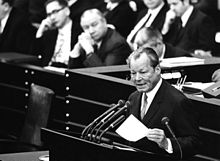
In 1966, Erhard lost support andKurt Kiesingerwas elected as Chancellor by a new CDU/CSU-SPDalliance combining the two largest parties.Social democratic(SPD) leaderWilly Brandtwas Deputy Federal Chancellor and Foreign Minister. The 1966–1969 Grand Coalition reduced tensions with the Soviet bloc nations and establishing diplomatic relations withCzechoslovakia,RomaniaandYugoslavia.
Guest workers
[edit]With a booming economy short of unskilled workers, especially after the Berlin Wall cut off the steady flow of East Germans, the FRG negotiated migration agreements with Italy (1955),Spain(1960), Greece (1960), and Turkey (1961) that brought in hundreds of thousands of temporary guest workers, calledGastarbeiter.In 1968, the FRG signed a guest worker agreement with Yugoslavia that employed additional guest workers.Gastarbeiterwere young men who were paid full-scale wages and benefits, but were expected to return home in a few years.[439]
The agreement with Turkey ended in 1973 but few workers returned because there were few good jobs in Turkey.[440]By 2010 there were about 4 million people of Turkish descent in Germany. The generation born in Germany attended German schools, but had a poor command of either German or Turkish, and had either low-skilled jobs or were unemployed.[441][442]
Brandt and Ostpolitik
[edit]
Willy Brandtwas the leader of theSocial Democratic Partyin 1964–1987 and West German Chancellor in 1969–1974. Under his leadership, the German government sought to reduce tensions with theSoviet Unionand improve relations with theGerman Democratic Republic,a policy known as theOstpolitik.[426]Relations between the two German states had been icy at best, with propaganda barrages in each direction. The heavy outflow of talent from East Germany prompted the building of theBerlin Wallin 1961, which worsenedCold Wartensions and prevented East Germans from travel. Although anxious to relieve serious hardships for divided families and to reduce friction, Brandt'sOstpolitikwas intent on holding to its concept of "two German states in one German nation".
Ostpolitikwas opposed by the conservative elements in Germany, but won Brandt an international reputation and the Nobel Peace Prize in 1971.[443]In September 1973, both West and East Germany were admitted to theUnited Nations.The two countries exchanged permanent representatives in 1974, and, in 1987, East Germany's leaderErich Honeckerpaid anofficial state visitto West Germany.[444]
Economic crisis of 1970s
[edit]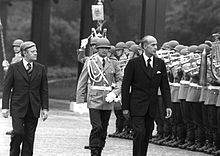
After 1973, Germany was hard hit by a worldwide economic crisis, soaring oil prices, and stubbornly high unemployment, which jumped from 300,000 in 1973 to 1.1 million in 1975. TheRuhrregion was hardest hit, as its easy-to-reach coal mines petered out, and expensive German coal was no longer competitive. Likewise the Ruhr steel industry went into sharp decline, as its prices were undercut by lower-cost suppliers such as Japan. The welfare system provided a safety net for the large number of unemployed workers, and many factories reduced their labor force and began to concentrate on high-profit specialty items. After 1990 the Ruhr moved into service industries and high technology. Cleaning up the heavy air and water pollution became a major industry in its own right. Meanwhile, formerly rural Bavaria became a high-tech center of industry.[412]
A spy scandal forced Brandt to step down as Chancellor while remaining as party leader. He was replaced byHelmut Schmidt(b. 1918), of the SPD, who served as Chancellor in 1974–1982. Schmidt continued theOstpolitikwith less enthusiasm. He had aPhDin economics and was more interested in domestic issues, such as reducinginflation.The debt grew rapidly as he borrowed to cover the cost of the ever more expensive welfare state.[445]After 1979, foreign policy issues grew central as the Cold War turned hot again. The German peace movement mobilized hundreds of thousands of demonstrators to protest against American deployment in Europe of newmedium-range ballistic missiles.Schmidt supported the deployment but was opposed by the left wing of the SPD and by Brandt.
The pro-businessFree Democratic Party (FDP)had been in coalition with the SPD, but now it changed direction.[446]Led by Finance MinisterOtto Graf Lambsdorffthe FDP adopted the market-oriented "Kiel Theses" in 1977; it rejected the Keynesian emphasis on consumer demand, and proposed to reduce social welfare spending, and try to introduce policies to stimulate production and facilitate jobs. Lambsdorff argued that the result would be economic growth, which would itself solve both the social problems and the financial problems. As a consequence, the FDP switched allegiance to the CDU and Schmidt lost his parliamentary majority in 1982. For the only time in West Germany's history, the government fell on avote of no confidence.[409][447]
Kohl
[edit]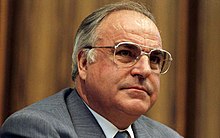
Helmut Kohlbrought the conservatives back to power with aCDU/CSU-FDP coalitionin 1982, and served as Chancellor until 1998.[426]He orchestrated reunification with the approval of all the Four Powers from World War II, who still had a voice in German affairs.[448]He lost inthe left's biggest landslide victory in 1998,and was succeeded by the SPD'sGerhard Schröder.[449]
Reunification
[edit]During the summer of 1989, rapid changes known aspeaceful revolutionorDie Wendetook place in East Germany, which quickly led toGerman reunification.[426]Growing numbers of East Germans emigrated to West Germany, many via Hungary after Hungary's reformist government opened its borders.

The opening of theIron CurtainbetweenAustriaandHungaryat the Pan-European Picnic in August 1989 then triggered a chain reaction, at the end of which there was no longer a GDR and the Eastern Bloc had disintegrated.Otto von Habsburg's idea developed the greatest mass exodus since the construction of the Berlin Wall and it was shown that the USSR and the rulers of the Eastern European satellite states were not ready to keep the Iron Curtain effective. This made their loss of power visible and clear that the GDR no longer received effective support from the other communist Eastern Bloc countries.[450][451][452]Thousands of East Germans then tried to reach the West by staging sit-ins at West German diplomatic facilities in other East European capitals, most notably in Prague. The exodus generated demands within East Germany for political change, andmass demonstrations in several citiescontinued to grow.[453]

Unable to stop the growing civil unrest,Erich Honeckerwas forced to resign in October, and on 9 November, East German authorities unexpectedly allowed East German citizens to enter West Berlin and West Germany. Hundreds of thousands of people took advantage of the opportunity; new crossing pointswere opened in the Berlin Walland along the border with West Germany. This led to the acceleration of the process of reforms in East Germany that ended with the dissolution of East Germany and theGerman reunificationthat came into force on 3 October 1990.[454]
Federal Republic of Germany, 1990–present
[edit]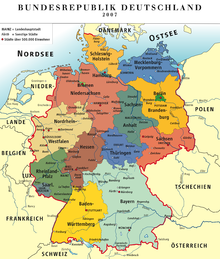

The SPD/Green coalition won the 1998 elections and SPD leaderGerhard Schröderpositioned himself as acentrist"Third Way"candidate in the mold ofU.K. Prime MinisterTony BlairandU.S. PresidentBill Clinton.Schröder proposedAgenda 2010,a significant downsizing of the welfare state with five goals: tax cuts; labor market deregulation, especially rela xing rules protecting workers from dismissal and setting upHartz conceptjob training; modernizing the welfare state by reducing entitlements; decreasing bureaucratic obstacles for small businesses; and providing new low-interest loans to local governments.[455]
On 26 December 2004 duringBo xing Daycelebration, about more than nearly 540 Germans have died and many more thousands of Germans are missing fromIndian Ocean tsunami from Indonesian earthquakewhile vacationing in SouthernThailand.[citation needed]
In 2005, after the SPD lost to theChristian Democratic Union (CDU)inNorth Rhine-Westphalia,Gerhard Schröderannounced he would call federal elections "as soon as possible". Amotion of confidencewas subsequently defeated after Schröder urged members not to vote for his government to trigger new elections. In response, a grouping of left-wing SPD dissidents and the neo-communistParty of Democratic Socialismagreed to run on a joint ticket in the general election, with Schröder's rivalOskar Lafontaineleading the new group.
In the2005 elections,Angela Merkelbecame the first female chancellor. In 2009 the German government approved a €50 billion stimulus plan.[456]Among the major German political projects of the early 21st century are the advancement ofEuropean integration,theenergy transition(Energiewende) for asustainable energysupply, thedebt brakefor balanced budgets, measures to increase thefertility rate(pronatalism), and high-tech strategies for the transition of the German economy, summarised asIndustry 4.0.[457] From2005to2009and2013to2021,Germany was ruled by agrand coalitionled by the CDU'sAngela Merkelas chancellor. From 2009 to 2013, Merkel headed a centre-right government of the CDU/CSU and FDP.[458]

Together with France, Italy, Netherlands, and other EU member nations, Germany has played the leading role in theEuropean Union.Germany (especially under ChancellorHelmut Kohl) was one of the main supporters of admitting many East European countries to the EU. Germany is at the forefront of European states seeking to exploit the momentum of monetary union to advance the creation of a more unified and capable European political, defence and security apparatus. German Chancellor Schröder expressed an interest in a permanent seat for Germany in theUN Security Council,identifying France, Russia, and Japan as countries that explicitly backed Germany's bid. Germany formally adopted the Euro on 1 January 1999 after permanently fi xing the Deutsche Mark rate on 31 December 1998.[459][460]
Since 1990, GermanBundeswehrhas participated in a number of peacekeeping and disaster relief operations abroad. Since 2002, German troops formed part of theInternational Security Assistance Forcein theWar in Afghanistan,resulting in the first Germancasualtiesin combat missions since World War II.
In light of the worldwideGreat Recessionthat began in 2008, Germany did not experience as much economic hardship as other European nations. Germany later sponsored a massive financial rescue in the wake of theEurozone crisiswhich affected the German economy.
Following the2011 earthquake and tsunamiinJapan,which led to theFukushima nuclear disaster,German public opinion turned sharply againstnuclear power in Germany,which at the time produced a fourth of the electricity supply. In response Merkel announced plans to close down the nuclear power plants over the following decade, and a commitment to rely more heavily on wind and other alternative energy sources, in addition to coal and natural gas.[461]
Germany was affected by theEuropean migrant crisisin 2015 as it became the final destination of choice for many asylum seekers fromAfricaand theMiddle Eastentering the EU. The country took in over a million refugees and migrants and developed a quota system which redistributed migrants around its federal states based on their tax income and existing population density.[462]The decision by Merkel to authorize unrestricted entry led to heavy criticism in Germany as well as within Europe.[463][464]This was a major factor in the rise of the far-right partyAlternative for Germanywhich entered the Bundestag in the2017 federal election.[465]
German government response to the COVID-19 pandemic (2020-22)
[edit]In January 2020, Germany has confirmed the first case ofnovel coronavirus,found from Wuhan, China. In March 2020, Germany went to the national lockdowns, which was greatly affected by the pandemic, and greatly impact on German economy, healthcare system, and society, and also commended for being an effective model for instituting methods of curbing infections and deaths, but lost this status by the end of the year due to rising number of cases, hospitalizations, and deaths. In December 2020, COVID-19 vaccines began to be administered in Germany. Unfortunately, from June 2021 to the end of March 2022, Germany has might seeing a new surge of huge COVID-19 infection wave, fueled by the highly transmissibleDeltacronhybrid variant, which is combined of Delta and Omicron mutations. However, Germany has suffered from a recombination event of Deltacron, which was caused of less access to vaccine shortage in the first quarter. As of May 2022, Germany has reported 140,292 COVID-19-related deaths, the fifth highest mortality toll (BehindRussia,theUnited Kingdom,Italy,andFrance), out of 2 million deaths in Europe.[466]
On 8 April 2022 just after the first two years of pandemic, Germany joinedFrance,Italy,Netherlands,Belgium,Luxembourg,Austria,Switzerland,Greece,Turkey,andCypruswere lifted all COVID-19 restrictions, measures, and state of emergencies up in the future.[citation needed]
Post-COVID period (Since 2022)
[edit]On 8 December 2021 just three months after Germany's centre-left Social Democrats (SPD) narrowly won the federalelection,ending 16 years of conservative-led rule under Angela Merkel, Social DemocratOlaf Scholzwas sworn in as Germany's new chancellor. He formed a coalition government with the Green Party and the liberal Free Democrats.[467][468]
In February 2022,Frank-Walter Steinmeierwas elected for a second five-year term as Germany's president. Although largely ceremonial post, he has been seen as a symbol of consensus and continuity.[469]
AfterRussia's Feb. 24 invasion of Ukrainein 2022, Germany's previous foreign policy towards Russia (traditional Ostpolitik) has been severely criticized for having been too credulous and soft.[470]Following concerns from the2022 Russian invasion of Ukraine,Germany announced a major shift in policy, pledging a €100 billion special fund for the Bundeswehr – to remedy years of underinvestment – along with raising the budget to above 2%GDP.[471] As of April 2023, over 1.06 million refugees from Ukraine were recorded in Germany.[472]
As of December 2023, Germany is the fourth largest economy in the world after the United States, China and Japan and the largest economy in Europe. It is the third largest export nation in the world.[473]
See also
[edit]- Historiography of Germany
- Conservatism in Germany
- Economic history of Germany
- History of Berlin
- History of German foreign policy
- History of German journalism
- History of the Jews in Germany
- History of women in Germany
- List of chancellors of Germany
- List of German monarchs
- Military history of Germany
- Names of Germany
- Politics of Germany
- Territorial evolution of Germany
- Timeline of German history
Notes
[edit]- ^"By no means all the Imperial Estates, for example, participated in theReichstag.Not every vassal of the emperor, even in the German lands, participated in the emerging political system from the start. In the period around 1500 what might be described as the political nation was largely confined to the south, to the old Hohenstaufen core territories south of the Main and the Saale, to the areas between Alsace in the west and the Austrian duchies in the east, where the Habsburgs had extended their territories and around them, their clientele. ", pg. 39.[167]
- ^"[...] it is a tribute to his success that what emerged by the end of his reign was not an oligarchy of princes but a strengthened monarchy", pg. 75; "The Reich emerged from the reforms of 1495 and 1500 as a polity in which the emperor and the Estates coexisted, but also competed, in uneasy equilibrium", pg. 95.[169]
- ^In the end, while the Reformation emphasis on Protestants reading the Scriptures was one factor in the development of literacy, the impact of printing itself, the wider availability of printed works at a cheaper price, and the increasing focus on education and learning as key factors in obtaining a lucrative post, were also significant contributory factors.[184]
References
[edit]- ^McRae, Mike (6 November 2019)."We Just Found an 11-Million-Year-Old Ancestor That Hints How Humans Began to Walk".ScienceAlert.
- ^Wagner, Günther A. (2010)."Radiometric dating of the type-site for Homo heidelbergensis at Mauer, Germany".Proceedings of the National Academy of Sciences.107(46): 19726–19730.Bibcode:2010PNAS..10719726W.doi:10.1073/pnas.1012722107.PMC2993404.PMID21041630.
- ^Fiedler, Lutz; Humburg, Christian; Klingelhöfer, Horst; Stoll, Sebastian; Stoll, Manfred (2019)."Several Lower Palaeolithic Sites along the Rhine Rift Valley, Dated from 1.3 to 0.6 Million Years".Humanities.8(3): 129.doi:10.3390/h8030129.
- ^Trnka, Gerhard (2007).Rezension zu: H. Thieme (Hrsg.): Die Schöninger Speere,...es sind acht Speere...(There are eight javelins).H-Soz-Kult.ISBN978-3-8062-2164-0.Retrieved1 March2019.
- ^Kleinhubbert, Guido (20 April 2020)."Vogelkiller aus der Steinzeit".SPIEGEL Akademie.Retrieved23 April2020.
- ^http://stanzon.husemann.net/download.php?id=201533&type=T[bare URL]
- ^Tattersall, Ian;Schwartz, Jeffrey H.(22 June 1999)."Hominids and hybrids: The place of Neanderthals in human evolution".Proceedings of the National Academy of Sciences.96(13). National Academy of Sciences: 7117–7119.Bibcode:1999PNAS...96.7117T.doi:10.1073/pnas.96.13.7117.PMC33580.PMID10377375.
- ^Smith, Geoff M.; Ruebens, Karen; Zavala, Elena Irene; Sinet-Mathiot, Virginie; Fewlass, Helen; Pederzani, Sarah; Jaouen, Klervia; Mylopotamitaki, Dorothea; Britton, Kate; Rougier, Hélène; Stahlschmidt, Mareike; Meyer, Matthias; Meller, Harald; Dietl, Holger; Orschiedt, Jörg; Krause, Johannes; Schüler, Tim; McPherron, Shannon P.; Weiss, Marcel; Hublin, Jean-Jacques; Welker, Frido (31 January 2024)."The ecology, subsistence and diet of ~45,000-year-old Homo sapiens at Ilsenhöhle in Ranis, Germany".Nature Ecology & Evolution.8(3): 564–577.Bibcode:2024NatEE...8..564S.doi:10.1038/s41559-023-02303-6.PMC10927544.PMID38297138.
- ^Conard, Nicholas J. (2009). "A female figurine from the basal Aurignacian of Hohle Fels Cave in southwestern Germany".Nature.459(7244): 248–252.Bibcode:2009Natur.459..248C.doi:10.1038/nature07995.PMID19444215.S2CID205216692.
- ^"Ice Age Lion Man is the world's earliest figurative sculpture – The Art Newspaper".The Art Newspaper.Archived fromthe originalon 10 August 2014.Retrieved24 November2013.[better source needed]
- ^"The Venus of Hohle Fels".donsmaps.
- ^"Earliest music instruments found".BBC News.25 May 2012.
- ^Fernández, Eva (5 June 2014)."Ancient DNA Analysis of 8000 B.C. Near Eastern Farmers Supports an Early Neolithic Pioneer Maritime Colonization of Mainland Europe through Cyprus and the Aegean Islands".PLOS Genetics.10(6): e1004401.doi:10.1371/journal.pgen.1004401.PMC4046922.PMID24901650.
- ^"3400 BC: The oldest evidence for the use of the wheel and wagon originates from Northern Germany".Kiel University.2022.
- ^"Nebra Sky Disc".Halle State Museum of Prehistory.
- ^Haak, Wolfgang; Lazaridis, Iosif; Patterson, Nick; Rohland, Nadin; Mallick, Swapan; Llamas, Bastien; Brandt, Guido; Nordenfelt, Susanne; Harney, Eadaoin; Stewardson, Kristin; Fu, Qiaomei; Mittnik, Alissa; Bánffy, Eszter; Economou, Christos; Francken, Michael; Friederich, Susanne; Pena, Rafael Garrido; Hallgren, Fredrik; Khartanovich, Valery; Khokhlov, Aleksandr; Kunst, Michael; Kuznetsov, Pavel; Meller, Harald; Mochalov, Oleg; Moiseyev, Vayacheslav; Nicklisch, Nicole; Pichler, Sandra L.; Risch, Roberto; Rojo Guerra, Manuel A.; Roth, Christina; Szécsényi-Nagy, Anna; Wahl, Joachim; Meyer, Matthias; Krause, Johannes; Brown, Dorcas; Anthony, David; Cooper, Alan; Alt, Kurt Werner; Reich, David (11 June 2015)."Massive migration from the steppe was a source for Indo-European languages in Europe".Nature.522(7555): 207–211.arXiv:1502.02783.Bibcode:2015Natur.522..207H.doi:10.1038/nature14317.PMC5048219.PMID25731166.
- ^Iñigo Olalde (8 March 2018)."The Beaker Phenomenon and the Genomic Transformation of Northwest Europe".Nature.555(7695). National Center for Biotechnology: 190–196.Bibcode:2018Natur.555..190O.doi:10.1038/nature25738.PMC5973796.PMID29466337.
- ^Louwen, A.J (2021).Breaking and making the ancestors. Piecing together the urnfield mortuary process in the Lower-Rhine-Basin, c. 1300–400 BC(PhD). Leiden University.
- ^Probst, Ernst (1996).Deutschland in der Bronzezeit: Bauern, Bronzegiesser und Burgherren zwischen Nordsee und Alpen.München: C. Bertelsmann. p. 258.ISBN978-3570022375.
- ^Chadwick and Corcoran, Nora and J.X.W.P. (1970).The Celts.Penguin Books. pp. 28–29.
- ^Saupe, Tina; Montinaro, Francesco; Scaggion, Cinzia; Carrara, Nicola; Kivisild, Toomas; D’Atanasio, Eugenia; Hui, Ruoyun; Solnik, Anu; Lebrasseur, Ophélie; Larson, Greger; Alessandri, Luca; Arienzo, Ilenia; De Angelis, Flavio; Rolfo, Mario Federico; Skeates, Robin; Silvestri, Letizia; Beckett, Jessica; Talamo, Sahra; Dolfini, Andrea; Miari, Monica; Metspalu, Mait; Benazzi, Stefano; Capelli, Cristian; Pagani, Luca; Scheib, Christiana L. (June 2021)."Ancient genomes reveal structural shifts after the arrival of Steppe-related ancestry in the Italian Peninsula".Current Biology.31(12): 2576–2591.e12.Bibcode:2021CBio...31E2576S.doi:10.1016/j.cub.2021.04.022.hdl:11585/827581.PMID33974848.S2CID234471370.
- ^Aneli, Serena; Caldon, Matteo; Saupe, Tina; Montinaro, Francesco; Pagani, Luca (October 2021)."Through 40,000 years of human presence in Southern Europe: the Italian case study".Human Genetics.140(10): 1417–1431.doi:10.1007/s00439-021-02328-6.PMC8460580.PMID34410492.
- ^Saupe et al. 2021"The results suggest that the Steppe-related ancestry component could have first arrived through Late N/Bell Beaker groups fromCentral Europe."
- ^ab"Celtic City: Staatliche Schlösser und Gärten Baden-Württemberg".heuneburg-pyrene.de.Retrieved31 July2024.
- ^"Heuneburg (Herbertingen-Hundersingen)".Landeskunde Online.Retrieved17 April2020.
- ^Herodotus (1857).Herodoti Musae.in bibliopolio Hahniano.
- ^Herodotus (1829).Herodoti historiarum libri IX.G. Fr. Meyer. pp. 110–.
- ^Gimbutas, Marija (25 August 2011).Bronze Age cultures in Central and Eastern Europe.Walter de Gruyter. pp. 100–.ISBN978-3-1116-6814-7.
- ^Milisauskas, Sarunas (30 June 2002).European Prehistory: A Survey.Springer Science & Business Media. pp. 363–.ISBN978-0-3064-7257-2.
- ^Rankin, David; H. D. Rankin (1996).Celts and the Classical World.Psychology Press.ISBN978-0-4151-5090-3.
- ^Kinder, Hermann (1988),Penguin Atlas of World History,vol. I, London: Penguin, p. 108,ISBN0-14-051054-0.
- ^"Languages of the World: Germanic languages".The New Encyclopædia Britannica.Chicago, IL, United States: Encyclopædia Britannica, Inc. 1993.ISBN0-85229-571-5.
- ^Liebeschuetz, Wolf (2015). "The Debate about the Ethnogenesis of the Germanic Tribes".East and West in Late Antiquity.pp. 85–100.doi:10.1163/9789004289529_007.ISBN978-90-04-28952-9.
- ^Kristinsson 2010,p. 147: "In the 1st century BC it was the Suebic tribes who were expanding most conspicuously. [...] Originating from central Germania, they moved to the south and southwest. [...] As Rome was conquering the Gauls, Germans were expanding to meet them, and this was the threat from which Caesar claimed to be saving the Gauls. [...] For the next half-century the expansion concentrated on southern Germany and Bohemia, assimilating or driving out the previous Gallic or Celtic inhabitants. The oppida in this area fell and were abandoned one after another as simple, egalitarian Germanic societies replaced the complex, stratified Celtic ones."
- ^Green 2003,p. 29: "Greek may have followed the Persians in devising its terms for their military formations, but the Goths were dependent [...] on Iranians of the Pontic region for terms which followed the Iranian model more closely in using the cognate Gothic term for the second element of its compounds. (Gothic dependence on Iranian may have gone even further, affecting the numeral itself, if we recall that the two Iranian loanwords in Crimean Gothic are words for 'hundred' and 'thousand')."
- ^Fortson 2011,p. 433: "Baltic territory began to shrink shortly before the dawn of the Christian era due to the Gothic migrations into their southwestern territories [...]."
- ^Green 2000,pp. 172–173: "Jordanes [...] mentions the Slavs (Getica119) and associates them more closely than the Balts with the center of Gothic power. [...] This location of the early Slavs partly at least in the region covered by the Cernjahov culture, together with their contacts (warlike or not) with the Goths under Ermanric and almost certainly before, explains their openness to Gothic loanword influence. That this may have begun early, before the expansion of the Slavs from their primeval habitat, is implied by the presence of individual loan-words in a wide range of Slavonic languages. "
- ^Claster 1982,p. 35.
- ^Brown, Robert D. (2013)."Caesar's Description of Bridging the Rhine (Bellum Gallicum 4.16–19): A Literary Analysis".Classical Philology.108:41–53.doi:10.1086/669789.S2CID162278924.
- ^Julius Caesar,Commentarii de Bello Gallico1.31–53
- ^C. Julius Caesar."C. Julius Caesar, Gallic War".Perseus Project.Retrieved20 March2019.
- ^Bordewich 2005.
- ^Ozment 2004,pp. 2–21.
- ^Fichtner 2009,p. xlviii.
- ^"The Journal of the Anthropological Society of Bombay".The Journal of the Anthropological Society of Bombay.10:647. 1917.
- ^Ramirez-Faria 2007,p. 267.
- ^Rüger 2004,pp. 527–528.
- ^"Lecture 23 – Rome of Constantine and a New Rome: Overview".Open Yale Courses.Yale University.Retrieved22 November2021.
- ^Bowman, Garnsey & Cameron 2005,p. 442.
- ^Heather 2010.
- ^Halsall, Guy(20 December 2007).Barbarian Migrations and the Roman West, 376–568.Cambridge University Press. pp.1ff.ISBN978-0-5214-3491-1.
- ^Heather 2006,p. 349: "By 469, just sixteen years after [Attila's] death, the last of the Huns were seeking asylum inside the eastern Roman Empire."
- ^"The Roman Decline".Empires Besieged.Amsterdam: Time-Life Books. 1988. p. 38.ISBN0-7054-0974-0.OL11194180M.
For on the bitterly cold night of December 31, 406, there was apparently no Roman army on guard when a host of Vandal, Alan, Suevi and Burgundian warriors, with their families and possessions, crossed the frozen Rhine and headed southwest through Gaul. This time, Rome's frontiers had been breached by barbarians who meant to stay.
- ^Bradbury 2004,p. 154: "East Francia consisted of four main principalities, the stem duchies – Saxony, Bavaria, Swabia and Franconia."
- ^Rodes 1964,p. 3: "It was plagued by the existence of immensely strong tribal duchies, such as Bavaria, Swabia, Thuringia, and Saxony – often referred to as stem duchies, from the German word Stamm, meaning tribe [...]."
- ^Historicus 1935,p. 50: "Franz von Lothringen muß sein Stammherzogtum an Stanislaus Leszinski, den französischen Kandidaten für Polen, ueberlassen [...]. [Francis of Lorraine had to bequeath his stem-duchy to Stanislaus Leszinski, the French candidate for the Polish crown [...].]"
- ^Compare:
Langer, William Leonard,ed. (1968)."ANCIENT HISTORY".An encyclopedia of world history: ancient, medieval and modern, chronologically arranged(4 ed.). Harrap. p. 174.
These stem duchies were: Franconia [...]; Lorraine (not strictly a stem duchy but with a tradition of unity); Swabia [...].
- ^Clover, Frank M. (1999), "A Game of Bluff: The Fate of Sicily after A.D. 476",Historia: Zeitschrift für Alte Geschichte,48 (1): 235–244, JSTOR 4436542, p. 237.
- ^abWilson 2016,p. 24.
- ^"Gregory of Tours (539–594): The Conversion of Clovis, 42. When they were dead Clovis received all their kingdom and treasures".Sourcebooks.Retrieved2 March2019.
- ^Kibler 1995,p. 1159: "From time to time, Austrasia received a son of the Merovingian king as an autonomous ruler."
- ^Bachrach, Bernard S. (1972).Merovingian Military Organization, 481–751.U of Minnesota Press. pp. 9–.ISBN978-0-8166-5700-1.
- ^Thompson, James Westfall (1928). "Old Saxony".Feudal Germany.University of Chicago Press. pp. 167ff.Retrieved4 March2019.
- ^Van Dam 1995,p. 222: "Surrounding the core of Frankish kingdoms were other regions more or less subservient to the Merovingian kings. In some regions the Merovingians appointed, or perhaps simply acknowledged, various dukes, such as the duke of the Alamans, the duke of the Vascones in the western Pyrenees, and the duke of the Bavarians. [...] Since these dukes, unlike those who served at the court of the Merovingians or administered particular regions in the Merovingian kingdoms, ruled over distinct ethnic groups, they had much local support and tended to act independently of the Merovingians, and even to make war on them occasionally."
- ^Moreland, John; Van de Noort, Robert (1992). "Integration and Social Reproduction in the Carolingian Empire".World Archaeology.23(3): 320–334.doi:10.1080/00438243.1992.9980183.JSTOR124766.
- ^Damminger 2003,p. 74: "The area of Merovingian settlement in southwest Germany was pretty much confined to the so called 'Altsiedelland', those fertile regions which had been under the plough since neolithic times [...]."
- ^Drew 2011,pp. 8–9: "Some of the success of the Merovingian Frankish rulers may be their acceptance of the personality of law policy. Not only did Roman law remain in use among Gallo-Romans and churchmen, Burgundian law among the Burgundians, and Visigothic law among the Visigoths, but the more purely Germanic peoples of the eastern frontier were allowed to retain their own 'national' law."
- ^Hen 1995,p. 17: "Missionaries, mainly from the British Isles, continued to operate in the Merovingian kingdoms throughout the sixth to the eighth centuries. Yet, their efforts were directed at the fringes of the Merovingian territory, that is, at Frisia, north-east Austrasia and Thuringia. These areas were hardly Romanised, if at all, and therefore lacked any social, cultural or physical basis for the expansion of Christianity. These areas stayed pagan long after Merovingian society completed its conversion, and thus attracted the missionaries' attention. [...] Moreover, there is evidence of missionary and evangelising activity from Merovingian Gual, out of places like Metz, Strasbourg or Worms, into the 'pagan regions' [...]."
- ^Frassetto, Michael (2003).Encyclopedia of Barbarian Europe: Society in Transformation.ABC-CLIO. pp. 90–.ISBN978-1-5760-7263-9.
- ^Wilson 2016,p. 25.
- ^Arnason, Johann P.; Kurt A. Raaflaub (23 December 2010).The Roman Empire in Context: Historical and Comparative Perspectives.John Wiley & Sons. pp. 212–.ISBN978-1-4443-9020-9.
- ^Wilson 2016,p. 26.
- ^Wilson 2016,pp. 26–27.
- ^abcNelson, Janet L. (1998),Charlemagne's church at Aachen,vol. 48, History Today, pp. 62–64
- ^Benham, Jenny (2018). "Treaty of Verdun (843)".The Encyclopedia of Diplomacy.pp. 1–5.doi:10.1002/9781118885154.dipl0494.ISBN978-1-118-88791-2.
- ^abSchulman 2002,pp. 325–327.
- ^"Aachen Cathedral".UNESCO World Heritage Centre, Outstanding Universal Value.Retrieved18 March2019.
- ^Barraclough 1984,p. 59.
- ^Reuter, Timothy (25 March 2011). "The" Imperial Church System "of the Ottonian and Salian Rulers: a Reconsideration".The Journal of Ecclesiastical History.33(3). Cambridge Press: 347–374.doi:10.1017/S0022046900026245.S2CID159994750.
- ^Hooper, Nicholas; Bennett, Matthew (26 January 1996).The Cambridge Illustrated Atlas of Warfare: The Middle Ages, 768–1487.Cambridge University Press. pp.30–.ISBN978-0-5214-4049-3.
- ^Ring, Trudy; Watson, Noelle; Schellinger, Paul (28 October 2013).Northern Europe: International Dictionary of Historic Places.Routledge. pp. 124–.ISBN978-1-1366-3944-9.
- ^"Collegiate Church, Castle and Old Town of Quedlinburg".UNESCO World Heritage Centre.United Nations Educational, Scientific, and Cultural Organization.Retrieved25 June2022.
- ^Dirscherl, Simon (23 May 2005)."The clerical reform movement and the investiture controversy".University Passau. Archived fromthe originalon 7 March 2019.Retrieved6 March2019.
- ^Uta-Renate Blumenthal (1988).The Investiture Controversy: Church and Monarchy from the Ninth to the Twelfth Century.University of Pennsylvania Press.ISBN978-0-8122-1386-7.JSTORj.ctt3fht77.
- ^"What is the significance of the" Investiture Controversy? "".E Notes.Retrieved2 March2019.
- ^Baldwin, Marshall W., ed. (1969).A History of the Crusades.Vol. I: The first hundred years. Madison: University of Wisconsin.Retrieved2 March2019.
- ^Crawford, Paul."The Military OrdersL Intrioduction".ORB Encyclopedia. Archived fromthe originalon 6 October 2014.Retrieved2 March2019.
- ^"The Official Name of the Holy Roman Empire".Holy Roman Empire Association.Retrieved2 March2019.
- ^Wilson 2016,p. 19.
- ^Day 1914,p. 252.
- ^Thompson 1931,pp. 146–179.
- ^Translation of the grant of privileges to merchants in 1229:Halsall, Paul."Medieval Sourcebook: Privileges Granted to German Merchants at Novgorod, 1229".Fordham.edu.Retrieved6 March2019.
- ^Istvan Szepesi, "Reflecting the Nation: The Historiography of Hanseatic Institutions".Waterloo Historical Review7 (2015).onlineArchived5 September 2017 at theWayback Machine
- ^Rothbard, Murray N. (23 November 2009)."The Great Depression of the 14th Century".Mises Institute.Retrieved14 March2019.
- ^Murray, Alan V. (15 May 2017).The North-Eastern Frontiers of Medieval Europe: The Expansion of Latin Christendom in the Baltic Lands.Taylor & Francis. pp. 23–.ISBN978-1-3518-8483-9.
- ^Berend, Nora (15 May 2017).The Expansion of Central Europe in the Middle Ages.Taylor & Francis. pp. 194–.ISBN978-1-3518-9008-3.
- ^Ostsiedlung – ein gesamteuropäisches Phänomen.GRIN Verlag. 2002.ISBN978-3-6400-4806-9.Retrieved7 March2019.
- ^A SZÁSZOK BETELEPÜLÉSE ÉS A DÉLI HATÁRVÉDELEM ÁTSZERVEZÉSE[Establishment of Saxons and reorganisation of border defence in Transylvania] In: Erdély története három kötetben[History of Transylvania in three volume]. Editor: Köpeczi, Béla. Budapest, 1986, Akadémiai Kiadó.ISBN9-6305-4203-X http://mek.oszk.hu/02100/02109/html/59.html#67
- ^Bünz, Enno (2008).Ostsiedlung und Landesausbau in Sachsen: die Kührener Urkunde von 1154 und ihr historisches Umfeld.Leipziger Universitätsverlag. pp. 17–.ISBN978-3-8658-3165-1.
- ^Carsten 1958,pp. 52–68.
- ^"Staat des Deutschen Ordens".Ordensstaat de.Retrieved7 March2019.
- ^Blumenthal, Uta-Renate (1991).The Investiture Controversy: Church and Monarchy from the Ninth to the Twelfth Century.pp. 159–173.
- ^abFuhrmann 1986.
- ^Kahn, Robert A. (1974).A History of the Habsburg Empire 1526–1918.p. 5.
- ^"The Peace of Venice; 1177".Yale Law School. Archived fromthe originalon 25 August 2006.Retrieved14 March2019.
- ^Law, John E. (5 December 2016).Communes and Despots in Medieval and Renaissance Italy.Taylor & Francis. pp. 162–.ISBN978-1-3519-5035-0.
- ^Bumke, Joachim (1 January 1991).Courtly Culture: Literature and Society in the High Middle Ages.University of California Press. pp.206–.ISBN978-0-5200-6634-2.
- ^Scaglione, Aldo D. (1 January 1991).Knights at Court: Courtliness, Chivalry & Courtesy from Ottonian Germany to the Italian Renaissance.University of California Press. pp. 17–.ISBN978-0-5200-7270-1.
- ^Kantorowicz, Ernst (1957).Frederick the Second, 1194–1250.
- ^Köhler, Walther (1903)."Emperor Frederick II., The Hohenstaufe".The American Journal of Theology.7(2): 225–248.doi:10.1086/478355.JSTOR3153729.
- ^"The Golden Bull of the Emperor Charles IV 1356 A.D."Lillian Goldman Law Library.Retrieved18 March2019.
- ^Austin Alchon, Suzanne (2003).A pest in the land: new world epidemics in a global perspectiveress.University of New Mexico P. p.21.ISBN978-0-8263-2871-7.OL8167121M.
- ^Haverkamp, Alfred."Jews in the Medieval German Kingdom"(PDF).University of Trier.Retrieved19 March2019.
- ^Fuhrmann 1986,pp.11ff.
- ^Allen, Robert C."Economic structure and agricultural productivity in Europe, 1300-1800, page 9"(PDF).University of British Columbia.Retrieved19 March2019.
- ^Haverkamp, Alfred (1988).Medieval Germany, 1056–1273.Oxford University Press.
- ^Nicholas, David (1997).The Growth of the Medieval City: From Late Antiquity to the Early Fourteenth Century.Longman. pp. 69–72, 133–142, 202–220, 244–245, 300–307.
- ^Strait, Paul (1974).Cologne in the Twelfth Century.Gainesville, University Presses of Florida.ISBN978-0-8130-0448-8.
- ^Huffman, Joseph P. (1998).Family, Commerce, and Religion in London and Cologne.– covers from 1000 to 1300.
- ^Vos, Dirk de (2003). "Memling [Memlinc], Hans".Oxford Art Online.Oxford University Press.doi:10.1093/gao/9781884446054.article.t056734.ISBN978-1-884446-05-4.
- ^extent.https:// scientificlib /en/Mathematics/Biographies/AdamRies.html#:~:text=Adam%20Ries%20is%20generally%20considered%20to%20be%20the,more%20structured%20Arabic%20numerals%20to%20a%20large%20extent.
- ^Marshall, James L.; Marshall, Virginia R. (Autumn 2005)."Rediscovery of the Elements: Agricola"(PDF).The Hexagon.96(3). Alpha Chi Sigma: 59.ISSN0164-6109.OCLC4478114.Archived fromthe original(PDF)on 25 April 2024.Retrieved7 January2024.
- ^abRafferty, John P. (2012).Geological Sciences; Geology: Landforms, Minerals, and Rocks.New York: Britannica Educational Publishing, p. 10.ISBN9781615305445
- ^"Georgius Agricola".University of California - Museum of Paleontology.Retrieved4 April2019.
- ^Zwingenberger, 9.
- ^Silver, Larry."Albrecht Dürer, The Triumphal Arch or Arch of Honor – Smarthistory".smarthistory.org.Retrieved3 March2022.
- ^William Rothstein, Stanley (1995).Class, Culture, and Race in American Schools: A Handbook.Greenwood Publishing Group. pp. 9–.ISBN978-0-3132-9102-9.
- ^Wiesflecker, Hermann (2004).Österreich, Reich und Europa 1502 – 1504(in German). Böhlau. p. 694.ISBN978-3-2057-7305-4.Retrieved18 January2022.
- ^Häberlein, Mark (29 June 2012).The Fuggers of Augsburg: Pursuing Wealth and Honor in Renaissance Germany.University of Virginia Press. p. 59.ISBN978-0-8139-3258-3.Retrieved18 January2022.
- ^Belt, Forest H.; Allen, Larry (1998).The ABC-CLIO World History Companion to Capitalism.ABC-CLIO. p. 134.ISBN978-0-8743-6944-1.Retrieved4 March2022.
- ^Meinrad, Kohler, Alfred; Arnold-Öttl, Herta; Ammann, Gert; Caramelle, Franz; Gürtler, Eleonore; Pizzinini (2016).Tiroler Ausstellungsstrassen: Maximilian I(in German). Museum With No Frontiers, MWNF (Museum Ohne Grenzen). p. 143.ISBN978-3-9029-6603-2.Retrieved18 January2022.
{{cite book}}:CS1 maint: multiple names: authors list (link) - ^Nolan, Cathal J. (2006).The Age of Wars of Religion, 1000-1650: An Encyclopedia of Global Warfare and Civilization.Greenwood Publishing Group. p. 332.ISBN978-0-3133-3733-8.Retrieved3 March2022.
- ^Clough, S. B. (1975).European History in a World Perspective: Early modern times.Heath. p. 479.ISBN978-0-6698-5555-5.Retrieved3 March2022.
- ^Eckert, Daniel (6 June 2016)."So wurde Fugger zum reichsten Menschen der Geschichte".Die Welt.Welt.Retrieved18 March2019.
- ^Schwope, David."The Death of the Knight: Changes in Military Weaponry during the Tudor Period"(PDF).Academic Forum. Archived fromthe original(PDF)on 28 November 2015.Retrieved18 March2019.
- ^Stollberg-Rilinger 2021,pp. 46, 47.
- ^Wilson 2016,p. ii.
- ^Metzig, Gregor (21 November 2016).Kommunikation und Konfrontation: Diplomatie und Gesandtschaftswesen Kaiser Maximilians I. (1486–1519)(in German). Walter de Gruyter GmbH & Co KG. pp. 98, 99.ISBN978-3-1104-5673-8.Retrieved15 February2022.
- ^Monro, Alexander (22 March 2016).The Paper Trail: An Unexpected History of a Revolutionary Invention.Knopf Doubleday Publishing Group. p. 239.ISBN978-0-3079-6230-0.Retrieved2 March2022.
- ^Wilson 2016,pp. ii, 260, 266, 277, 419.
- ^Stollberg-Rilinger 2021,pp. 46–53.
- ^Axelrod, Alan (2013).Mercenaries: A Guide to Private Armies and Private Military Companies.CQ Press. p. 124.ISBN978-1-4833-6467-4.Archivedfrom the original on 26 September 2021.Retrieved20 September2021.
- ^Kersken, Uwe (2014). "Die letzten ihrer Art".Die Welt der Ritter.Zweites Deutsches Fernsehen(zdf).
- ^Kleinschmidt, Harald (2008).Ruling the Waves: Emperor Maximilian I, the Search for Islands and the Transformation of the European World Picture c. 1500.Antiquariaat Forum. p. 162.ISBN978-9-0619-4020-3.Retrieved3 March2022.
- ^Brunner, Jean-Claude (2012). "Historical Introduction".Medieval Warfare.2(3, "The revival of infantry tactics in the Late Middle Ages" ): 6–9.JSTOR48578016.
- ^Wilson 2016,p. 2.
- ^Strieder, Peter (8 May 2017). "Zur Entstehungsgeschichte von Dürers Ehrenpforte für Kaiser Maximilian".Anzeiger des Germanischen Nationalmuseums:128–142 Seiten.doi:10.11588/azgnm.1954.0.38143.
- ^Hirschi, Caspar (8 December 2011).The Origins of Nationalism: An Alternative History from Ancient Rome to Early Modern Germany.Cambridge University Press. p. 45.ISBN978-1-1395-0230-6.Retrieved7 February2022.
- ^Brandt, Bettina (2010).Germania und ihre Söhne: Repräsentationen von Nation, Geschlecht und Politik in der Moderne(in German). Vandenhoeck & Ruprecht. p. 37.ISBN978-3-5253-6710-0.Retrieved8 February2022.
- ^abStollberg-Rilinger 2021,p. 52.
- ^Lee, Daniel (19 February 2016).Popular Sovereignty in Early Modern Constitutional Thought.Oxford University Press. p. 243.ISBN978-0-1910-6244-5.Retrieved20 November2021.
- ^Thornhill, Chris (24 January 2007).German Political Philosophy: The Metaphysics of Law.Routledge. p. 12.ISBN978-1-1343-8280-4.Retrieved20 November2021.
- ^Haivry, Ofir (29 June 2017).John Selden and the Western Political Tradition.Cambridge University Press. p. 118.ISBN978-1-1070-1134-2.Retrieved20 November2021.
- ^Mousourakis, George (2 March 2017).The Historical and Institutional Context of Roman Law.Routledge. p. 435.ISBN978-1-3518-8840-0.Retrieved20 November2021.
- ^Neuhaus, Helmut (1 October 2010).Das Reich in der Frühen Neuzeit(in German). Walter de Gruyter. p. 48.ISBN978-3-4867-0179-1.Retrieved14 February2022.
- ^Brendle, Franz (1998).Dynastie, Reich und Reformation: die württembergischen Herzöge Ulrich und Christoph, die Habsburger und Frankreich(in German). W. Kohlhammer. p. 54.ISBN978-3-1701-5563-3.Retrieved14 February2022.
- ^Treichel, Eckhardt (14 December 2015).Organisation und innere Ausgestaltung des Deutschen Bundes 1815–1819.Walter de Gruyter GmbH & Co KG. p. 1549.ISBN978-3-1104-2400-3.Retrieved14 February2022.
- ^Putten, Jasper Cornelis van (6 November 2017).Networked Nation: Mapping German Cities in Sebastian Münster's "Cosmographia".BRILL. p. 256.ISBN978-9-0043-5396-1.Retrieved14 February2022.
- ^Whaley 2011,pp. 76, 77.
- ^Müller 2003,p. 298.
- ^Brady 2009,p. 111.
- ^Whaley 2011,p. 74.
- ^Whaley 2011,p. 115.
- ^Whaley, Joachim."Whaley on Silver," Marketing Maximilian: the Visual Ideology of a Holy Roman Emperor "H-German H-Net".networks.h-net.org.Retrieved3 March2022.
- ^Tennant, Elaine C.; Johnson, Carroll B. (1985).The Habsburg Chancery Language in Perspective, Volume 114.University of California Press. pp. 1, 3, 9.ISBN978-0-5200-9694-3.Archivedfrom the original on 27 September 2021.Retrieved21 September2021.
- ^Wiesinger, Peter (16 August 2018). "Zwei Varietäten der deutschen Schriftsprache durch Konfessionalisierung im 16. und 17. Jahrhundert".Jahrbuch für Germanistische Sprachgeschichte.9(1): 213–234.doi:10.1515/jbgsg-2018-0014.S2CID186566355.
- ^Whaley 2011,pp. 12, 39, 40, 50, 72, 80.
- ^Stollberg-Rilinger 2021,p. 47.
- ^Whaley 2011,p. 27, 75.
- ^Friedeburg, Robert von (2012).Germany and the Holy Roman Empire.Oxford University Press.ISBN978-0-1987-3101-6.Retrieved26 February2022.
- ^Whaley 2011,p. 17, 73.
- ^abDittmar, Jeremiah; Seabold, Skipper."Media, Markets and Institutional Change: Evidence from the Protestant Reformation"(PDF).CEP.Retrieved19 March2019.
- ^John Lotherington,The German Reformation(2014)
- ^Michael G. Baylor,The German Reformation and the Peasants' War: A Brief History with Documents(2012)
- ^John Lotherington,The Counter-Reformation(2015)
- ^abAdams 1997,pp. 138–191.
- ^Wilson, Peter H. (June 2008). "The Causes of the Thirty Years War 1618–1648".The English Historical Review.CXXIII(502). Oxford University Press: 554–586.doi:10.1093/ehr/cen160.
- ^Wilson, Peter H. (2009).The Thirty Years War: Europe's Tragedy.
- ^Geoffrey Parker,The Thirty Years' War(1997) p. 178 has 15–20% decline; Tryntje Helfferich,The Thirty Years' War: A Documentary History(2009) p. xix, estimates a 25% decline. Wilson (2009) pp. 780–795 reviews the estimates.
- ^Whaley, Joachim (2012).Germany and the Holy Roman Empire: Volume I: Maximilian I to the Peace of Westphalia, 1493–1648.Oxford: Oxford University Press. pp. 623–631.ISBN978-0-1987-3101-6.
- ^abcdeLobenstein-Reichmann, Anja (2017). "Martin Luther, Bible Translation, and the German Language".Oxford Research Encyclopedia of Religion.doi:10.1093/acrefore/9780199340378.013.382.ISBN978-0-19-934037-8.
- ^Holborn 1959,p. 37.
- ^Cameron, Euan (1 March 2012).The European Reformation.Oxford: Oxford University Press.ISBN978-0-1995-4785-2.[page needed]
- ^PettegreeReformation Worldp. 543
- ^Rubin, "Printing and Protestants" Review of Economics and Statistics pp. 270–286
- ^"Media, Markets and Institutional Change: Evidence from the Protestant Reformation"(PDF).Archived(PDF)from the original on 9 October 2022.
- ^Edwards, Mark U. Jr. (1994).Printing, Propaganda, and Martin Luther.
- ^See texts atProject Wittenberg: "Selected Hymns of Martin Luther"
- ^Weimer, Christoph (2004). "Luther and Cranach on Justification in Word and Image".Lutheran Quarterly.18(4): 387–405.
- ^Stolt, Birgit (2014). "Luther's Translation of the Bible".Lutheran Quarterly.28(4): 373–400.
- ^Holden, Joshua (2 October 2018).The Mathematics of Secrets: Cryptography from Caesar Ciphers to Digital Encryption.Princeton University Press.ISBN978-0-6911-8331-2.Retrieved20 February2022.
- ^Rodriquez, Mercedes Garcia-Arenal; Mediano, Fernando Rodríguez (15 April 2013).The Orient in Spain: Converted Muslims, the Forged Lead Books of Granada, and the Rise of Orientalism.BRILL. p. 383.ISBN978-9-0042-5029-1.Retrieved20 February2022.
- ^Zambelli, Paola (2007).White Magic, Black Magic in the European Renaissance.BRILL. p. 251.ISBN978-9-0041-6098-9.Retrieved20 February2022.
- ^Eire, Carlos M. N. (28 June 2016).Reformations: The Early Modern World, 1450–1650.Yale University Press. p. 223.ISBN978-0-3002-2068-1.Retrieved6 January2022.
- ^Kallendorf, Craig W. (15 April 2008).A Companion to the Classical Tradition.John Wiley & Sons. p. 174.ISBN978-1-4051-7202-8.Retrieved6 January2022.
- ^The Germanic Review.Heldref Publications. 1951. p. 148.Retrieved6 January2022.
- ^Piechocki, Katharina N. (13 September 2021).Cartographic Humanism: The Making of Early Modern Europe.University of Chicago Press. p. 26.ISBN978-0-2268-1681-4.Retrieved6 January2022.
- ^Fletcher, John Edward (26 August 2011).A Study of the Life and Works of Athanasius Kircher, 'Germanus Incredibilis': With a Selection of his Unpublished Correspondence and an Annotated Translation of his Autobiography.BRILL. p. 21.ISBN978-9-0042-1632-7.Retrieved4 March2022.
- ^Johnson, Claes (2011).Many Minds Relativity.Claes Johnson. p. 68.Retrieved4 March2022.
- ^Blumenau, Ralph (30 April 2014).Philosophy and Living.Andrews UK Limited. p. 236.ISBN978-1-8454-0649-3.Retrieved4 March2022.
- ^Kleinschmidt, Harald (2000).Understanding the Middle Ages: The Transformation of Ideas and Attitudes in the Medieval World.Boydell & Brewer.ISBN978-0-8511-5770-2.Archivedfrom the original on 29 October 2021.Retrieved29 October2021.
- ^Cortesão, Armando (1969).History of Portuguese Cartography.Junta de Investigações do Ultramar. p. 124.Retrieved13 November2021.
- ^Buisseret, David (22 May 2003).The Mapmakers' Quest: Depicting New Worlds in Renaissance Europe.Oxford: Oxford University Press. p. 54.ISBN978-0-1915-0090-9.Retrieved8 November2021.
- ^Noflatscher 2011,p. 245.
- ^Lachièze-Rey, Marc; Luminet, Jean-Pierre; France, Bibliothèque nationale de (16 July 2001).Celestial Treasury: From the Music of the Spheres to the Conquest of Space.Cambridge University Press. p. 86.ISBN978-0-5218-0040-2.Retrieved7 November2021.
- ^Nothaft, C. Philipp E. (9 February 2018).Scandalous Error: Calendar Reform and Calendrical Astronomy in Medieval Europe.Oxford University Press. p. 278.ISBN978-0-1925-2018-0.Retrieved7 November2021.
- ^Hayton 2015,p. 92.
- ^Stillman Drake, "Copernicanism in Bruno, Kepler, and Galileo."Vistas in Astronomy17 (1975): 177–192onlineArchived15 October 2021 at theWayback Machine.
- ^"DPMA | Johannes Kepler".
- ^"Archived copy".Archived fromthe originalon 24 June 2021.Retrieved1 September2023.
{{cite web}}:CS1 maint: archived copy as title (link) - ^"Molecular Expressions: Science, Optics and You - Timeline - Johannes Kepler".
- ^Philip G. Dwyer, ed.The rise of Prussia: Rethinking Prussian history, 1700–1830pp. 1–26.
- ^Hornung, Erik (2014). "Immigration and the Diffusion of Technology: The Huguenot Diaspora in Prussia".American Economic Review.104(1): 84–122.doi:10.1257/aer.104.1.84.hdl:10419/37227.
- ^Clark 2006,pp. 78–94.
- ^Gawthrop, Richard L. (2 November 2006).Pietism and the Making of Eighteenth-Century Prussia.Cambridge University Press. p. 266.ISBN978-0-5210-3012-0.Retrieved30 August2022.
- ^Kahler, Erich (5 March 2019).Man The Measure: A New Approach To History.Routledge. p. 279.ISBN978-0-4297-0934-0.Retrieved30 August2022.
- ^abcSheehan 1989,pp. 75, 207–291, 291–323, 324–371, 802–820.
- ^Sagarra 1977,p. 22.
- ^"treaty of Ryswick".Oxford Reference.
- ^Jankowski, Tomek E. (20 May 2014).Eastern Europe!: Everything You Need to Know About the History (and More) of a Region that Shaped Our World and Still Does.Steerforth Press. pp. 274–.ISBN978-0-9850-6233-0.
- ^"Eugen Prinz von Savoyen".Deutsche Biographie.Retrieved21 March2019.
- ^Hochedlinger, Michael (22 December 2015).Austria's Wars of Emergence, 1683–1797.Routledge.ISBN978-1-3178-8793-5.
- ^Dennis Showalter,Frederick the Great: A Military History(2012)
- ^Ritter, Gerhard(1974) [1936]. Peter Peret (ed.).Frederick the Great: A Historical Profile.Berkeley: University of California Press.ISBN978-0-5200-2775-6.;called byRussell Weigley"The best introduction to Frederick the Great and indeed to European warfare in his time."Russell Frank Weigley (2004).The Age of Battles: The Quest for Decisive Warfare from Breitenfeld to Waterloo.Indiana U.P. p. 550.ISBN978-0-2532-1707-3.
- ^Jörg Ulbert (2008). "France and German Dualism, 1756–1871".A History of Franco-German Relations in Europe.Springer Nature Switzerland AG. pp. 39–48.doi:10.1057/9780230616639_4.ISBN978-1-3493-7221-8.
- ^Schui, Florian (14 March 2013).Rebellious Prussians: Urban Political Culture Under Frederick the Great and His Successors.Oxford: Oxford University Press. pp. 92–.ISBN978-0-1995-9396-5.
- ^Lucjan R. Lewitter, "The Partitions of Poland" in A. Goodwyn, ed.The New Cambridge Modern History: vol 8 1763–93(1965) pp. 333–359
- ^Holborn 1964,pp. 291–299.
- ^Holborn 1964,pp. 299–302.
- ^Ingrao, Charles W. (2003).The Hessian Mercenary State: Ideas, Institutions, and Reform under Frederick II, 1760–1785.
- ^Liebel, Helen P. (1965). "Enlightened bureaucracy versus enlightened despotism in Baden, 1750–1792".Transactions of the American Philosophical Society.55(5): 1–132.doi:10.2307/1005911.JSTOR1005911.
- ^Holborn 1964,pp.291–302.
- ^Marion W. Gray,Productive men, reproductive women: the agrarian household and the emergence of separate spheres during the German Enlightenment(2000).
- ^Nipperdey 1996,ch 2.
- ^Marion W. Gray and June K. Burton, "Bourgeois Values in the Rural Household, 1810–1840: The New Domesticity in Germany",The Consortium on Revolutionary Europe, 1750–185023 (1994): 449–456.
- ^Eda Sagarra,An introduction to Nineteenth century Germany(1980) pp. 231–233.
- ^Ford, Guy Stanton (1922).Stein and the era of reform in Prussia, 1807–1815.Princeton University Press. pp.199–220.
- ^Brakensiek, Stefan (April 1994), "Agrarian Individualism in North-Western Germany, 1770–1870",German History,vol. 12, no. 2, pp. 137–179
- ^Gagliardo, John G. (1991).Germany under the Old Regime, 1600–1790.pp. 217–234, 375–395.
- ^"Edict of Potsdam, October 29, 1685".Deutsche Geschichte in Quellen und Darstellung.Retrieved26 March2019.
- ^Charles W. Ingrao, "A Pre-Revolutionary Sonderweg".German History20#3 (2002), pp. 279–286.
- ^Katrin Keller, "Saxony: Rétablissement and Enlightened Absolutism".German History20.3 (2002): 309–331.
- ^Richter, Simon J., ed. (2005),The Literature of Weimar Classicism
- ^Owens, Samantha; Reul, Barbara M.; Stockigt, Janice B., eds. (2011).Music at German Courts, 1715–1760: Changing Artistic Priorities.
- ^Kuehn, Manfred (2001).Kant: A Biography.
- ^"Immanuel Kant" An Answer to the Question: What is Enlightenment? "".Internet Modern History Sourcebook. Archived fromthe originalon 17 February 2020.Retrieved26 March2019.
- ^Van Dulmen, Richard; Williams, Anthony, eds. (1992).The Society of the Enlightenment: The Rise of the Middle Class and Enlightenment Culture in Germany.
- ^James J. Sheehan,German History, 1770–1866(1993) pp. 207–288
- ^Connelly, Owen (1966). "6".Napoleon's satellite kingdoms.New York, Free Press.
- ^abRaff, Diethher (1988),History of Germany from the Medieval Empire to the Present,pp. 34–55, 202–206
- ^Heyman, Neil M. (1966). "France Against Prussia: The Jena Campaign of 1806".Military Affairs.30(4): 186–198.doi:10.2307/1985399.JSTOR1985399.
- ^Nicholas Saul, ed.The Cambridge companion to German romanticism(Cambridge University Press, 2009) ch 1.
- ^Carr 1991,pp. 1–2.
- ^abLee 1985,pp. 332–346.
- ^Sagarra 1977,pp. 37–55, 183–202.
- ^Nipperdey 1996,p. 86.
- ^Nipperdey 1996,pp. 87–92, 99.
- ^Kopsidis, Michael; Bromley, Daniel W."The French Revolution and German industrialization: The new institutional economics rewrites history"(PDF).Leibniz Institute of Agricultural Development in Transition Economies.Retrieved13 April2019.
- ^abMitchell, Allan (2006).The Great Train Race: Railways and the Franco-German Rivalry, 1815–1914.Berghahn Books.ISBN978-1-8454-5136-3.
- ^Tilly, Richard (1967), "Germany: 1815–1870", in Cameron, Rondo (ed.),Banking in the Early Stages of Industrialization: A Study in Comparative Economic History,Oxford University Press, pp. 151–182
- ^Nipperdey 1996,p. 178 "On the whole, industrialisation in Germany must be considered to have been positive in its effects. Not only did it change society and the countryside, and finally the world...it created the modern world we live in. It solved the problems of population growth, under-employment and pauperism in a stagnating economy, and abolished dependency on the natural conditions of agriculture, and finally hunger. It created huge improvements in production and both short- and long-term improvements in living standards. However, in terms of social inequality, it can be assumed that it did not change the relative levels of income. Between 1815 and 1873 the statistical distribution of wealth was on the order of 77% to 23% for entrepreneurs and workers respectively. On the other hand, new problems arose, in the form of interrupted growth and new crises, such as urbanisation," alienation ", new underclasses, proletariat and proletarian misery, new injustices and new masters and, eventually, class warfare."
- ^Stolper 2017,ch 1.
- ^Nipperdey 1996,pp. 96–97.
- ^Nipperdey 1996,p. 165.
- ^Hamerow, Theodore S. (1969).The Social Foundations of German Unification, 1858–1871: Ideas and Institutions.pp. 284–291.
- ^Olson, Kenneth E. (1966).The history makers: The press of Europe from its beginnings through 1965.LSU Press. pp. 99–134.
- ^Elmer H. Antonsen, James W. Marchand, and Ladislav Zgusta, eds.The Grimm brothers and the Germanic past(John Benjamins Publishing, 1990).
- ^Clark 2006,pp. 412–419.
- ^Christopher Clark, "Confessional policy and the limits of state action: Frederick William III and the Prussian Church Union 1817–40".Historical Journal39.04 (1996) pp. 985–1004.JSTOR2639865
- ^Holborn 1964,pp. 485–491.
- ^Clark 2006,pp. 419–421.
- ^Holborn 1964,pp. 498–509.
- ^Taylor, A.J.P. (2001).The Course of German History.p.52.
- ^Williamson, George S. (December 2000)."What Killed August von Kotzebue? The Temptations of Virtue and the Political Theology of German Nationalism, 1789–1819".Journal of Modern History.72(4): 890–943.doi:10.1086/318549.JSTOR10.1086/318549.S2CID144652797.
- ^Wittke, C. F. (1952).Refugees of Revolution: The German Forty-Eighters in America.Philadelphia: University of Pennsylvania Press.
- ^Holborn 1969,pp. 131–167.
- ^Feuchtwanger, Edgar(2014).Bismarck: A Political History(2nd ed.). Routledge. pp. 83–98.ISBN978-0-4157-2477-7.OCLC863633117.OL26785882M.
- ^Holborn 1969,pp. 167–188.
- ^Feuchtwanger 2014,pp. 99–147.
- ^Gordon A. Craig,Germany, 1866–1945(1978) pp. 11–22.
- ^Jonathan Sperber, "Review,"Journal of Modern History85#3 (2012), pp. 768–769.
- ^Rüstow, Wilhelm (1872).The War for the Rhine Frontier, 1870: Its Political and Military History.Blackwood.
- ^McCabe, James D. (1871).History of the war between Germany and France.HathiTrust Digital Library.Retrieved23 March2019.
- ^Tonge, Stephen (11 November 2013)."Bismarck's Domestic Polices 1871 -1890".History Home.Retrieved22 March2019.
- ^Keller, Wolfgang; Shiue, Carol H. (December 2014). "Endogenous Formation of Free Trade Agreements: Evidence from the Zollverein's Impact on Market Integration".The Journal of Economic History.74(4): 1168–1204.doi:10.1017/S0022050714000898(inactive 24 September 2024).S2CID154596279.
{{cite journal}}:CS1 maint: DOI inactive as of September 2024 (link) - ^Guenther, Jack Harrold (2018).'Gateway to the World': Hamburg and the Global German Empire, 1881-1914(Thesis).doi:10.14418/wes01.1.1723.
- ^abBerger, Stefan (2015). "Building the Nation Among Visions of German Empire".Nationalizing Empires.pp. 247–308.doi:10.1515/9789633860175-007.ISBN978-963-386-017-5.
- ^Wright, Patrick (9 September 2006)."A fistful of Fredericks – He considers the" invention of tradition "in Prussia, and the importance of memorials and ceremonies of remembrance in shaping patriotic identity".Guardian.Retrieved23 March2019.
- ^"A German Voice of Opposition to Germanization (1914)".German History in Documents and Images.German Historical Institute.Retrieved18 May2019.
- ^"Germanization Policy: Speech by Ludwik Jazdzewski in a Session of the Prussian House of Representatives (January 15, 1901)".German History in Documents and Images.German Historical Institute.Retrieved18 May2019.
- ^Röhl, J. C. G. (1967)."Higher Civil Servants in Germany, 1890–1900".Journal of Contemporary History.2(3). Sage Publications, Ltd.: 101–121.doi:10.1177/002200946700200306.JSTOR259809.S2CID160827181.
- ^Clark 2006,pp. 158, 603–623.
- ^Wehler, Hans-Ulrich."Hans Ulrich Wehler-The German Empire 1871-1918-Berg (1985)".Scribd. p. 157.Retrieved31 March2019.
- ^Richie 1998,p. 207.
- ^Blackbourn 1998,p. 32.
- ^Mazón, Patricia M. (2003).Gender and the Modern Research University: The Admission of Women to German Higher Education, 1865–1914.Stanford U.P. p. 53.ISBN978-0-8047-4641-0.
- ^Moses, John Anthony (1982).Trade Unionism in Germany from Bismarck to Hitler, 1869–1933.Rowman & Littlefield. p. 149.ISBN978-0-8604-3450-4.
- ^Hennock, E. P. (2007),The Origin of the Welfare State in England and Germany, 1850–1914: Social Policies Compared
- ^Beck, Hermann (1995),Origins of the Authoritarian Welfare State in Prussia, 1815–1870
- ^Spencer, Elaine Glovka (Spring 1979), "Rules of the Ruhr: Leadership and Authority in German Big Business Before 1914",Business History Review,53(1), [President and Fellows of Harvard College, Cambridge University Press]: 40–64,doi:10.2307/3114686,JSTOR3114686,S2CID154458964
- ^Lambi, Ivo N. (March 1962), "The Protectionist Interests of the German Iron and Steel Industry, 1873–1879",Journal of Economic History,22(1), Cambridge University Press: 59–70,doi:10.1017/S0022050700102347,JSTOR2114256,S2CID154067344
- ^Douglas W. Hatfield, "Kulturkampf: The Relationship of Church and State and the Failure of German Political Reform",Journal of Church and State(1981) 23#3 pp. 465–484JSTOR23916757
- ^John C.G. Roehl, "Higher civil servants in Germany, 1890–1900" in James J. Sheehan, ed.,Imperial Germany(1976) pp. 128–151
- ^Margaret Lavinia Anderson, and Kenneth Barkin. "The myth of the Puttkamer purge and the reality of the Kulturkampf: Some reflections on the historiography of Imperial Germany".Journal of Modern History(1982): 647–686. esp. pp. 657–662JSTOR1906016
- ^Anthony J. Steinhoff, "Christianity and the creation of Germany", in Sheridan Gilley and Brian Stanley, eds.,Cambridge History of Christianity: Volume 8: 1814–1914(2008) p. 295
- ^John K. Zeender inThe Catholic Historical Review,Vol. 43, No. 3 (Oct. 1957), pp. 328–330.
- ^Rebecca Ayako Bennette,Fighting for the Soul of Germany: The Catholic Struggle for Inclusion after Unification(Harvard U.P. 2012)
- ^Blackbourn, David (December 1975)."The Political Alignment of the Centre Party in Wilhelmine Germany: A Study of the Party's Emergence in Nineteenth-Century Württemberg"(PDF).Historical Journal.18(4): 821–850.doi:10.1017/s0018246x00008906.JSTOR2638516.S2CID39447688.
- ^Clark 2006,pp. 568–576.
- ^Ronald J. Ross,The failure of Bismarck's Kulturkampf: Catholicism and state power in imperial Germany, 1871–1887(1998).
- ^Childers, Thomas(2001)."The First World War and Its Legacy".A History of Hitler's Empire, 2nd Edition.Episode 2.The Great Courses.Event occurs at 06:37-11:02.Retrieved27 March2023.
- ^Weitsman, Patricia A. (2004),Dangerous alliances: proponents of peace, weapons of war,p. 79
- ^Belgum, Kirsten (1998).Popularizing the Nation: Audience, Representation, and the Production of Identity in "Die Gartenlaube", 1853–1900.p. 149.
- ^Neugebauer, Wolfgang (2003).Die Hohenzollern. Band 2 – Dynastie im säkularen Wandel(in German). Stuttgart:Kohlhammer Verlag.pp. 174–175.ISBN978-3-1701-2097-6.
- ^Kroll, Franz-Lothar (2000), "Wilhelm II. (1888–1918)", in Kroll, Franz-Lothar (ed.),Preussens Herrscher. Von den ersten Hohenzollern bis Wilhelm II.(in German), Munich: C. H. Beck, p. 290
- ^Christopher Clark,Kaiser Wilhelm II(2000) pp. 35–47
- ^John C. G.Wilhelm II: the Kaiser's personal monarchy, 1888–1900(2004).
- ^On the Kaiser's "histrionic personality disorder", see Tipton (2003), pp. 243–245
- ^Röhl, J. C. G. (September 1966). "Friedrich von Holstein".Historical Journal.9(3): 379–388.doi:10.1017/s0018246x00026716.S2CID163767674.
- ^Woodward, David (July 1963). "Admiral Tirpitz, Secretary of State for the Navy, 1897–1916".History Today.13(8): 548–555.
- ^Hattendorf, John B. (January 1991).he Influence of History on Mahan: Proceedings of a Conference Marking the Centenary of Alfred Thayer Mahan's Influence of Sea Power Upon History.Academia.Retrieved4 April2019.
- ^Herwig, Holger (1980).Luxury Fleet: The Imperial German Navy 1888–1918.
- ^Mahan, Alfred Thayer (1890).The Influence of Sea Power Upon History.Archive Org.Retrieved4 April2019.
- ^Esthus, Raymond A. (1970).Theodore Roosevelt and the International Rivalries.pp. 66–111.
- ^Page, Melvin Eugene; Penny M. Sonnenburg (2003).Colonialism: An International, Social, Cultural, and Political Encyclopedia.ABC-CLIO. pp. 8–.ISBN978-1-5760-7335-3.
- ^Buchheim, Christoph (1986). "Germany on the World Market at the End of the 19th Century".German Yearbook on Business History 1985.Springer. pp. 41–55.doi:10.1007/978-3-642-71196-1_3.ISBN978-3-6427-1198-5.
- ^"Industrial Growth (1870–1914)".German History Docs.Retrieved4 April2019.
- ^Perkins, J. A. (Spring 1981). "The Agricultural Revolution in Germany 1850–1914".Journal of European Economic History.10(1): 71–119.
- ^Page Moch, Leslie."Internal migration before and during the Industrial Revolution: the case of France and Germany".EGO.Retrieved4 April2019.
- ^Aftalion, Otto Theodor Benfey, Fred (1991),A History of the International Chemical Industry,University of Pennsylvania Press
- ^Haber, Ludwig Fritz (1958),The chemical industry during the nineteenth century
- ^Webb, Steven B. (June 1980)."Tariffs, Cartels, Technology, and Growth in the German Steel Industry, 1879 to 1914".Journal of Economic History.40(2): 309–330.doi:10.1017/s0022050700108228.JSTOR2120181.S2CID154281603.
- ^James, Harold (2012).Krupp: A History of the Legendary German Firm.Princeton University Press.
- ^Allen, Robert C. (December 1979)."International Competition in Iron and Steel, 1850–1913".Journal of Economic History.39(4): 911–937.doi:10.1017/s0022050700098673.JSTOR2120336.S2CID154582825.
- ^Feldman, Gerald D.; Nocken, Ulrich (Winter 1975). "Trade Associations and Economic Power: Interest Group Development in the German Iron and Steel and Machine Building Industries, 1900–1933".Business History Review.49(4): 413–445.doi:10.2307/3113169.JSTOR3113169.S2CID153420481.
- ^John Anthony Moses and Paul M. Kennedy,Germany in the Pacific and Far East, 1870–1914(1977).
- ^sean McMeekin,The Berlin-Baghdad express: the Ottoman Empire and Germany's bid for world power, 1898–1918(Penguin, 2011)
- ^Gann, L., and Peter Duignan,The Rulers of German Africa, 1884–1914(1977) focuses on political and economic history; Perraudin, Michael, and Jürgen Zimmerer, eds.German Colonialism and National Identity(2010) focuses on cultural impact in Africa and Germany.
- ^Tilman Dedering, "The German-Herero war of 1904: revisionism of genocide or imaginary historiography?".Journal of Southern African Studies(1993) 19#1 pp: 80–88.
- ^Jeremy Sarkin,Germany's Genocide of the Herero: Kaiser Wilhelm II, His General, His Settlers, His Soldier(2011)
- ^Kirsten Dyck, "Situating the Herero Genocide and the Holocaust among European Colonial Genocides".Przegląd Zachodni(2014) No. 1 pp: 153–172.abstract
- ^Gradén, Lizette (13 May 2016).Performing Nordic Heritage: Everyday Practices and Institutional Culture.Routledge. p. 223.ISBN978-1-3170-8235-4.Retrieved15 October2022.
- ^Akinwumi, Olayemi (2002).The Colonial Contest for the Nigerian Region, 1884-1900: A History of the German Participation.LIT Verlag Münster. p. 97.ISBN978-3-8258-6197-1.Retrieved15 October2022.
- ^Bückendorf, Jutta (1997)."Schwarz-weiss-rot über Ostafrika!": deutsche Kolonialpläne und afrikanische Realität(in German). LIT Verlag Münster. p. 232.ISBN978-3-8258-2755-7.Retrieved15 October2022.
- ^Makiwane, Monde; Gumede, Ntombizonke A.; Zembe-Mkabile, Wanga (11 October 2021).Reflections from the Margins: Complexities, Transitions and Developmental Challenges: The Case of the Eastern Cape Province, South Africa.African Sun Media.ISBN978-1-9912-0113-3.Retrieved15 October2022.
- ^Tetzlaff, Rainer (1970).Koloniale Entwicklung und Ausbeutung: Wirtschaftsu. Sozialgeschichte Deutsch-Ostafrikas 1885-1914(in German). Duncker u. Humblot. p. 27.Retrieved15 October2022.
- ^Office, Great Britain Foreign (1927).The end of British isolation.H.M. Stationery Office. p. 32.Retrieved15 October2022.
- ^Bönker, Dirk (15 March 2012).Militarism in a Global Age: Naval Ambitions in Germany and the United States before World War I.Cornell University Press. p. 123.ISBN978-0-8014-6388-4.Retrieved15 October2022.
- ^Kennedy, Paul M. (1980).The Rise of the Anglo-German Antagonism, 1860–1914.Allen & Unwin. pp.464–470.ISBN978-0-0494-0060-3.
- ^Winter, J.M. (1999).Capital Cities at War: Paris, London, Berlin, 1914–1919.
- ^Strachan, Hew (2004).The First World War.
- ^Clodfelter, Micheal (2017).Warfare and Armed Conflicts: A Statistical Encyclopedia of Casualty and Other Figures, 1492–2015, 4th ed.McFarland. p. 407.ISBN978-0-7864-7470-7.
- ^Tucker, Spencer C. (2005).World War One.ABC-CLIO. p. 225.ISBN978-1-8510-9420-2.
- ^Steiner, Zara S. (2005).The Lights that Failed: European International History, 1919–1933.Oxford U.P. p. 68.ISBN978-0-1982-2114-2.
- ^Herwig, Holger H. (1996).The First World War: Germany and Austria–Hungary 1914–1918.
- ^Paschall, Rod (1994).The defeat of imperial Germany, 1917–1918.Hachette Books.ISBN978-0-3068-0585-1.
- ^Feldman, Gerald D. "The Political and Social Foundations of Germany's Economic Mobilization, 1914–1916",Armed Forces & Society(1976) 3#1 pp 121–145.online
- ^Chickering, Roger (2004).Imperial Germany and the Great War, 1914–1918.pp. 141–142.
- ^William H. McNeill,The Rise of the West(1991 edition) p. 742.
- ^"Etablierung der NS-Herrschaft"[Establishment of Nazi Rule].Deutsches Historisches Museum(in German). 22 June 2015.Retrieved27 March2023.
- ^"The political parties in the Weimar Republic"(PDF).Deutscher Bundestag. March 2006. Archived fromthe original(PDF)on 25 November 2011.Retrieved18 September2011.
- ^"Der" Ruhrkampf "ruinierte das deutsche Bürgertum"[The "Ruhrkampf" ruined the German bourgeoisie].Welt(in German). 11 January 2013.Retrieved27 March2023.
- ^Marks, Sally (1978). "The Myths of Reparations".Central European History.11(3): 231–255.doi:10.1017/s0008938900018707.JSTOR4545835.S2CID144072556.
- ^Childers, Thomas(2001)."The Weimar Republic and the Rise of the Nazi Party".A History of Hitler's Empire, 2nd Edition.Episode 3.The Great Courses.Event occurs at 7:00-7:30.Retrieved27 March2023.
- ^Fippel, Günter (2003).Antifaschisten in "antifaschistischer" Gewalt[Antifascists in "antifascist" violence] (in German). A. Peter. p. 21.ISBN978-3-9358-8112-8.
- ^Evans 2003,pp. 247–283.
- ^Richard F. Hamilton,Who Voted for Hitler?(1982)
- ^Evans 2003,pp. 283–308.
- ^"Nobel Prize".Nobelprize.org.Retrieved19 November2009.
- ^Joll, James (April 1985). "Two Prophets of the Twentieth Century: Spengler and Toynbee".Review of International Studies.11(2): 91–104.doi:10.1017/s026021050011424x(inactive 24 September 2024).S2CID145705005.
{{cite journal}}:CS1 maint: DOI inactive as of September 2024 (link) - ^Stackelberg, Roderick (2007).The Routledge companion to Nazi Germany.p.135.
- ^Ash, Mitchell G.; Söllner, Alfons, eds. (1996).Forced Migration and Scientific Change: Emigré German-Speaking Scientists and Scholars after 1933.
- ^Kershaw, Ian(2001).The "Hitler Myth": Image and Reality in the Third Reich.
- ^Williamson, David (2002). "Was Hitler a Weak Dictator?".History Review:9ff.
- ^Evans 2003,pp. 329–334.
- ^Evans 2003,p. 354, 336.
- ^Evans 2003,p. 351.
- ^Geary, Dick (October 1998)."Who voted for the Nazis? (electoral history of the National Socialist German Workers Party)".History Today.48(10): 8–14.
- ^Kershaw 2008,pp. 309–314.
- ^Marchak, M. Patricia (2003).Reigns of Terror.McGill-Queen's Press — MQUP. p. 195.ISBN978-0-7735-2642-6.
- ^Evans 2003,p. 344.
- ^Majer 2003,p. 92.
- ^Kershaw 2008,p. 345.
- ^Evans 2005,p. 544.
- ^Friedlander, Saul (1998).Nazi Germany and the Jews.Vol. 1: The Years of Persecution 1933–1939.
- ^Radcliff, Pamela.Interpreting the 20th Century: The Struggle Over Democracy, The Holocaust(PDF).pp. 104–107. Archived fromthe original(PDF)on 14 July 2014.Retrieved10 June2014.
- ^Rosenberg, Jennifer."Holocaust Facts".About Education.Archived fromthe originalon 19 February 2017.Retrieved10 June2014.
- ^Bullock, Alan (1991).Hitler: a study in tyranny.Harper Torchbooks. p.170.
- ^Evans 2005,p. 633.
- ^Evans 2005,pp. 632–637.
- ^Thacker, Toby (2009).Joseph Goebbels: Life and Death.pp. 182–184.
- ^Evans 2005,pp. 618, 623, 632–637, 641, 646–652, 671–674, 683.
- ^Beevor 2012,pp. 22, 27–28.
- ^Beevor 2012,pp. 70–71, 79.
- ^Kershaw 2008,p. 562.
- ^Axelrod, Alan; Kingston, Jack A. (2007).Encyclopedia of World War II, Volume 1.H W Fowler. p. 165.
- ^Large, David Clay (2001).Berlin.Basic Books. p.482.ISBN978-0-4650-2632-6.
- ^"Allies end occupation of West Germany".A&E Television Networks. 13 November 2009.Retrieved4 March2019.
- ^Stearns, Peter (2013).Demilitarization in the Contemporary World.University of Illinois Press. p. 176.ISBN978-0-2520-9515-3.
- ^Roberts, Patricia Hogwood, Geoffrey K. (2013).The Politics Today Companion to West European Politics.Oxford University Press. p. 50.ISBN978-1-8477-9032-3.;Piotr Stefan Wandycz (1980).The United States and Poland.Harvard University Press. p. 303.ISBN978-0-6749-2685-1.;Phillip A. Bühler (1990).The Oder-Neisse Line: a reappraisal under international law.East European Monographs. p. 33.ISBN978-0-8803-3174-6.
- ^Schechtman, Joseph B. (April 1953)."Postwar Population Transfers in Europe: A Survey".Review of Politics.15(2): 151–178.doi:10.1017/s0034670500008081.JSTOR1405220.S2CID144307581."Most had left" is p. 158.
- ^Bessel, Richard(2009).Germany 1945: From War to Peace.Harper Collins Publishers.ISBN978-0-0605-4036-4.
- ^"Die Arbeit der Suchdienste – 6o Jahre nach dem Zweiten Weltkrieg: Narben bleiben – p.13"(PDF).Volksbund Deutsche Kriegsgräberfürsorge e.V. Archived fromthe original(PDF)on 11 June 2017.Retrieved4 March2019.
- ^Faulenbach, Bernd (6 April 2005)."Die Vertreibung der Deutschen aus den Gebieten jenseits von Oder und Neiße".Bundeszentrale für politische Bildung.Retrieved4 March2019.
- ^Robert Bard,Historical Memory and the expulsion of ethnic Germans in Europe, 1944(PhD. Diss. University of Hertfordshire, 2009)online
- ^Davidson, Eugene.The death and life of Germany: an account of the American occupation.p. 121.
- ^Liberman, Peter (23 August 1998).Does Conquest Pay?: The Exploitation of Occupied Industrial Societies p. 147.Princeton University Press.ISBN978-0-6910-0242-2.
- ^2.3 million units out of 9.5 million were destroyed.
- ^abcTipton, Frank B. (2003).A History of Modern Germany since 1815.pp.508–513, 596–599.
- ^Hoover, Calvin B. (May 1946)."The Future of the German Economy".American Economic Review.36(2): 642–649.JSTOR1818235.
- ^Milward, Alan S. (1984).The Reconstruction of Western Europe: 1945–51.University of California Press. pp.356,436.ISBN978-0-5200-5206-2.
- ^abArdagh, John (1987).Germany and the Germans.Harper & Row. pp.74–82, 84.ISBN978-0-0601-5839-2.
- ^Gareau, Frederick H. (June 1961). "Morgenthau's Plan for Industrial Disarmament in Germany".Western Political Quarterly.14(2): 517–534.doi:10.2307/443604.JSTOR443604.
- ^"Conferences: Pas de Pagaille!".Time.28 July 1947. Archived fromthe originalon 14 October 2007.
- ^For US and Allied official policy statements see U.S. Dept. of StateGermany, 1947–1949: The Story in Documents(1950); these are primary sources.
- ^Gienow-Hecht, Jessica C.E. (1999)."Art is democracy and democracy is art: Culture, propaganda, and the Neue Zeitung in Germany".Diplomatic History.23(1): 21–43.doi:10.1111/0145-2096.00150.
- ^Bruce, Gary (2010),The Firm: The Inside Story of the Stasi
- ^Fulbrook, Mary (2008).The People's State: East German Society from Hitler to Honecker.
- ^Granville, Johanna (September 2006). "East Germany in 1956: Walter Ulbricht's Tenacity in the Face of Opposition".Australian Journal of Politics and History.52(3): 417–438.doi:10.1111/j.1467-8497.2006.00427.x.
- ^Biesinger, Joseph A. (2006),Germany: a reference guide from the Renaissance to the present,p. 270
- ^Taylor, Frederick (2008),The Berlin Wall: A World Divided, 1961–1989
- ^abPence, Katherine; Betts, Paul (2011).Socialist modern: East German everyday culture and politics(4 ed.). University of Michigan Press. pp. 37, 59.
- ^Kocka, Jürgen(2010).Civil Society and Dictatorship in Modern German History.UPNE. p. 37.ISBN978-1-5846-5866-5.
- ^TheChristian Social Unionor CSU is the Bavaria branch of the CDU. It has always operated in close collaboration with the CDU, and the CDU/CSU is usually treated as a single party in national affairs.
- ^Jürgen Weber,Germany, 1945–1990: A Parallel History(Budapest, Central European University Press, 2004)
- ^abcdWeber, Jurgen (2004).Germany, 1945–1990.Central European University Press. pp. 37–60, 103–118, 167–188, 221–264.
- ^Fürstenberg, Friedrich (May 1977). "West German Experience with Industrial Democracy".Annals of the American Academy of Political and Social Science.431:44–53.doi:10.1177/000271627743100106.JSTOR1042033.S2CID154284862.
- ^Junker, Detlef, ed. (2004).The United States and Germany in the Era of the Cold War, 1945–1968.Vol. 1. Cambridge University Press. pp. 291–309.
- ^Sauermann, Heinz (1950)."The Consequences of the Currency Reform in Western Germany".Review of Politics.12(2): 175–196.doi:10.1017/s0034670500045009.JSTOR1405052.S2CID145428438.
- ^Giangreco, D. M.; Griffin, Robert E. (1988).Airbridge to Berlin: The Berlin Crisis of 1948, Its Origins and Aftermath.Presidio Press. Archived fromthe originalon 6 March 2002.Retrieved10 February2011.
- ^Andreas Daum,Kennedy in Berlin.New York: Cambridge University Press, 2008, pp. 1‒5, 125–163.
- ^Williams, Charles (2000).Konrad Adenauer: The Father of the New Germany.
- ^Hiscocks, Richard (1975).The Adenauer era.p. 290.
- ^Granieri, Ronald J. (2005)."Review".Journal of Interdisciplinary History.36(2): 262–263.doi:10.1162/0022195054741190.S2CID142774747.
- ^Walter, Norbert. "The Evolving German Economy: Unification, the Social Market, European and Global Integration".SAIS Review(15 (Special Issue 1995)): 55–81..Quote from p. 64
- ^Mierzejewski, Alfred C. (2004).Ludwig Erhard: a biography.
- ^Mierzejewski, Alfred C. (2004), "1957: Ludwig Erhard's Annus Terribilis",Essays in Economic and Business History,vol. 22, pp. 17–27,ISSN0896-226X
- ^Turner, Henry Ashby (1987).The two Germanies since 1945.Yale University Press. pp.80–82.ISBN978-0-3000-4415-7.
- ^Shonick, Kaja (October 2009). "Politics, Culture, and Economics: Reassessing the West German Guest Worker Agreement with Yugoslavia".Journal of Contemporary History.44(4): 719–736.doi:10.1177/0022009409340648.S2CID145180949.
- ^Castles, Stephen (1985)."The Guests Who Stayed – The Debate on" Foreigners Policy "in the German Federal Republic".International Migration Review.19(3): 517–534.doi:10.2307/2545854.JSTOR2545854.PMID12341062.
- ^Ewing, Katherine Pratt (Spring–Summer 2003). "Living Islam in the Diaspora: Between Turkey and Germany".South Atlantic Quarterly.102(2/3): 405–431.doi:10.1215/00382876-102-2-3-405.S2CID162029927..InProject MUSE
- ^Mandel, Ruth (2008).Cosmopolitan Anxieties: Turkish Challenges to Citizenship and Belonging in Germany.Duke University Press.
- ^Fink, Carole; Schaefer, Bernd, eds. (2009).Ostpolitik, 1969–1974: European and Global Responses.
- ^Fulbrook, Mary (2002).History of Germany, 1918–2000: the divided nation.p.170.
- ^Sinn, Hans-Werner (2007).Can Germany be saved?: the malaise of the world's first welfare state.MIT Press. p.183.
- ^Cerny, Karl H. (1990).Germany at the polls: the Bundestag elections of the 1980s.p. 113.
- ^For a primary source see Helmut Schmidt,Men and Power: A Political Retrospective(1990)
- ^Pruys, Karl (1996).Kohl: Genius of the Present: A Biography of Helmut Kohl.
- ^"SCHROEDER DEFEATS KOHL IN HISTORIC GERMAN VOTE".The Washington Post.
- ^Miklós Németh in Interview, Austrian TV – ORF "Report", 25 June 2019.
- ^Thomas Roser:DDR-Massenflucht: Ein Picknick hebt die Welt aus den Angeln(German – Mass exodus of the GDR: A picnic clears the world) in: Die Presse 16 August 2018.
- ^Michael Frank: Paneuropäisches Picknick – Mit dem Picknickkorb in die Freiheit (German: Pan-European picnic – With the picnic basket to freedom), in: Süddeutsche Zeitung 17 May 2010.
- ^Andreas Rödder, Deutschland einig Vaterland – Die Geschichte der Wiedervereinigung (2009).
- ^For primary sources in English translation and a brief survey see Konrad H. Jarausch, and Volker Gransow, eds.Uniting Germany: Documents and Debates, 1944–1993(1994)
- ^Hockenos, Paul (2008).Joschka Fischer and the making of the Berlin Republic.Oxford University Press, USA. pp.313–14.ISBN978-0-1951-8183-8.
- ^"Germany agrees on 50-billion-euro stimulus plan".France 24.6 January 2009. Archived fromthe originalon 13 May 2011.
- ^"Government declaration by Angela Merkel"(in German). ARD Tagesschau. 29 January 2014. Archived fromthe originalon 1 January 2015.
- ^Bolgherini, Silvia; Grotz, Florian, eds. (2010).Germany After the Grand Coalition: Governance and Politics in a Turbulent Environment.Palgrave Macmillan.
- ^"Determination of the euro conversion rates".European Central Bank. 31 December 1998.Retrieved4 March2019.
- ^Bertaut, Murat F. Iyigun, Carol C."The Launch of the Euro"(PDF).Federal Reserve.Retrieved4 March2019.
- ^Mufson, Steven (30 May 2011)."Germany to close all of its nuclear plants by 2022".Washington Post.
- ^"Migrant crisis: Migration to Europe explained in seven charts".BBC News.28 January 2016.Retrieved31 January2016.
- ^"Chancellor Running Out of Time on Refugee Issue".Spiegel Online.19 January 2016.Retrieved7 June2017.
- ^"Merkel Critic Says Chancellor's Refugee Policy Is a 'Time Bomb'".Bloomberg News.9 August 2016.Retrieved7 June2017.
- ^Welle ( dw ), Deutsche."Far-right AfD enters German parliament: What it means for German politics | DW | 24.09.2017".DW.COM.
- ^"Germany COVID – Coronavirus Statistics – Worldometer".worldometers.info.
- ^"Germany elections: Centre-left claim narrow win over Merkel's party".BBC News.27 September 2021.
- ^Crowcroft, Orlando (8 December 2021)."'New era': Scholz becomes Germany's new chancellor as Merkel bows out ".euronews.
- ^Welle ( dw ), Deutsche."Frank-Walter Steinmeier elected to second term as German president | DW | 13.02.2022".
- ^"The ruins of Ostpolitik".eurozine.23 February 2022.
- ^Sheahan, Maria; Marsh, Sarah; Sheahan, Maria; Marsh, Sarah (27 February 2022)."Germany to increase defence spending in response to 'Putin's war' - Scholz".Reuters.
- ^"Ukrainian refugees by country 2023".Statista.
- ^"Economic Key Facts Germany".5 December 2023.
Works cited
[edit]- Atlas of GermanyWikipedia maps; not copyright
- Adams, Simon (1997).The Thirty Years' War.Psychology Press.ISBN978-0-4151-2883-4.
- Barraclough, Geoffrey(1984) [1946].The Origins of Modern Germany(1st paperback ed.). W.W. Norton.ISBN978-0-3933-0153-3.OL18327036M.
- Beevor, Antony (2012).The Second World War.New York: Little, Brown.ISBN978-0-3160-2374-0.
- Bordewich, Fergus M. (September 2005)."The Ambush That Changed History: An amateur archaeologist discovers the field where wily Germanic warriors halted the spread of the Roman Empire".Smithsonian.
- Bowman, Alan K.; Garnsey, Peter; Cameron, Averil (2005).The Crisis of Empire, A.D. 193–337.The Cambridge Ancient History. Vol. 12. Cambridge University Press.ISBN978-0-5213-0199-2.
- Bradbury, Jim(2004).The Routledge Companion to Medieval Warfare.Routledge Companions to History.Routledge.ISBN978-1-1345-9847-2.
- Brady, Thomas A. Jr. (2009).German Histories in the Age of Reformations, 1400–1650.Cambridge; New York: Cambridge University Press.ISBN978-0-5218-8909-4.
- Carr, William(1991).A History of Germany: 1815-1990(4 ed.). Routledge.ISBN978-0-3405-5930-7.
- Carsten, Francis (1958).The Origins of Prussia.
- Clark, Christopher(2006).Iron Kingdom: The Rise and Downfall of Prussia, 1600–1947.Harvard University Press.ISBN978-0-6740-2385-7.
- Claster, Jill N. (1982).Medieval Experience: 300–1400.New York University Press.ISBN978-0-8147-1381-5.
- Damminger, Folke (2003)."Dwellings, Settlements and Settlement Patterns in Merovingian Southwest Germany and adjacent areas".InWood, Ian(ed.).Franks and Alamanni in the Merovingian Period: An Ethnographic Perspective.Studies in Historical Archaeoethnology. Vol. 3 (Revised ed.). Boydell & Brewer.ISBN978-1-8438-3035-1.ISSN1560-3687.
- Day, Clive (1914).A History of Commerce.Longmans, Green, and Company. p.252.
- Drew, Katherine Fischer (2011).The Laws of the Salian Franks.The Middle Ages Series. University of Pennsylvania Press.ISBN978-0-8122-0050-8.
- Evans, Richard J.(2003).The Coming of the Third Reich.New York:Penguin Books.ISBN978-0-1430-3469-8.
- — (2005).The Third Reich in Power.New York: Penguin.ISBN978-0-1430-3790-3.
- Fichtner, Paula S. (2009).Historical Dictionary of Austria.Vol. 70 (2nd ed.).Scarecrow Press.ISBN978-0-8108-6310-1.
- Fortson, Benjamin W. (2011).Indo-European Language and Culture: An Introduction.Blackwell Textbooks in Linguistics. Vol. 30 (2nd ed.).John Wiley & Sons.ISBN978-1-4443-5968-8.
- Fuhrmann, Horst (1986).Germany in the High Middle Ages: C.1050–1200.Cambridge University Press.ISBN978-0-5213-1980-5.
- Green, Dennis H. (2000).Language and history in the early Germanic world(Revised ed.).Cambridge University Press.ISBN978-0-5217-9423-7.
- — (2003)."Linguistic evidence for the early migrations of the Goths".InHeather, Peter(ed.).The Visigoths from the Migration Period to the Seventh Century: An Ethnographic Perspective.Vol. 4 (Revised ed.).Boydell & Brewer.ISBN978-1-8438-3033-7.
- Hayton, Darin (2015).The Crown and the Cosmos: Astrology and the Politics of Maximilian I.University of Pittsburgh Press.ISBN978-0-8229-8113-8.Retrieved25 December2021.
- Heather, Peter J.(2006).The Fall of the Roman Empire: A New History of Rome and the Barbarians(Reprint ed.). Oxford University Press.ISBN978-0-1951-5954-7.
- Historicus (1935).Frankreichs 33 Eroberungskriege[France's 33 wars of conquest] (in German). Translated from the French. Foreword by Alcide Ebray (3rd ed.). Internationaler Verlag.Retrieved21 November2015.
- Heather, Peter (2010).Empires and Barbarians: The Fall of Rome and the Birth of Europe.Oxford University Press.
- Hen, Yitzhak(1995).Culture and Religion in Merovingian Gaul: A.D. 481–751.Cultures, Beliefs and Traditions: Medieval and Early Modern Peoples Series. Vol. 1. Brill.ISBN978-9-0041-0347-4.Retrieved26 November2015.
- Holborn, Hajo(1959).A History of Modern Germany.Vol. 1: The Reformation 1648–1840. Alfred A. Knopf.OCLC1035596914.OL21270043M.
- Kershaw, Ian (2008).Hitler: A Biography.New York: W. W. Norton & Company.ISBN978-0-3930-6757-6.
- Kibler, William W., ed. (1995).Medieval France: An Encyclopedia.Garland Encyclopedias of the Middle Ages. Vol. 2. Psychology Press.ISBN978-0-8240-4444-2.Retrieved26 November2015.
- Kristinsson, Axel (2010)."Germanic expansion and the fall of Rome".Expansions: Competition and Conquest in Europe Since the Bronze Age.ReykjavíkurAkademían.ISBN978-9-9799-9221-9.
- Lee, Loyd E. (1985). "The German Confederation and the Consolidation of State Power in the South German States, 1815–1848".Consortium on Revolutionary Europe 1750–1850: Proceedings.15.
- Longerich, Peter (2012).Heinrich Himmler: A Life.Oxford; New York: Oxford University Press.ISBN978-0-1995-9232-6.
- Majer, Diemut (2003)."Non-Germans" under the Third Reich: The Nazi Judicial and Administrative System in Germany and Occupied Eastern Europe, with Special Regard to Occupied Poland, 1939–1945.Baltimore; London: Johns Hopkins University Press.ISBN978-0-8018-6493-3.
- Müller, Jan-Dirk (2003). Gosman, Martin; Alasdair, A.; MacDonald, A.; Macdonald, Alasdair James; Vanderjagt, Arie Johan (eds.).Princes and Princely Culture: 1450–1650.BRILL. p. 298.ISBN978-9-0041-3572-7.Archivedfrom the original on 24 October 2021.Retrieved24 October2021.
- Noflatscher, Heinz (2011).Maximilian I. (1459–1519): Wahrnehmung – Übersetzungen – Gender(in German). StudienVerlag. p. 245.ISBN978-3-7065-4951-6.Retrieved7 November2021.
- Nipperdey, Thomas(1996).Germany from Napoleon to Bismarck: 1800–1866.Translated by Nolan, Daniel. Princeton University Press.ISBN978-0-6916-0755-9.OL1273142M.
- Ozment, Steven (2004).A Mighty Fortress: A New History of the German People.Harper Perennial.ISBN978-0-0609-3483-5.
- Ramirez-Faria, Carlos (2007)."Germany".Concise Encyclopedia of World History.Atlantic Publishers.ISBN978-8-1269-0775-5.
- Richie, Alexandra (1998).Faust's Metropolis. A History of Berlin.p. 207.;emphasis on 20th century
- Rodes, John E. (1964).Germany: A History.Holt, Rinehart and Winston.ASINB0000CM7NW.
- Rüger, C. (2004) [1996]."Germany".In Bowman, Alan K.; Champlin, Edward; Lintott, Andrew (eds.).The Cambridge Ancient History: X, The Augustan Empire, 43 B.C. – A.D. 69.Vol. 10 (2nd ed.). Cambridge University Press.ISBN978-0-5212-6430-3.
- Sagarra, Eda (1977).A Social History of Germany 1648–1914(2002 ed.). Transaction Publishers.ISBN978-1-4128-3431-5.
- Schulman, Jana K. (2002).The Rise of the Medieval World, 500–1300: A Biographical Dictionary.Greenwood Press.
- Sheehan, James J.(1989).German History 1770–1866.Oxford History of Modern Europe. Oxford: Oxford University Press.ISBN978-0-1982-0432-9.OL7397485M.
- Stollberg-Rilinger, Barbara (11 May 2021) [2018].The Holy Roman Empire: A Short History[Das Heilige Römische Reich Deutscher Nation: Vom Ende des Mittelalters bis 1806] (in German) (first paperback ed.). Princeton University Press. pp.46–53.ISBN978-0-6912-1731-4.OL34693404M.
- Stolper, Gustav (14 June 2017).German Economy, 1870-1940: Issues and Trends.Routledge.ISBN978-1-351-84711-7.
- Thompson, James Westfall (1931).Economic and Social History of Europe in the Later Middle Ages (1300–1530).
- Van Dam, Raymond (1995)."8: Merovingian Gaul and the Frankish conquests".InFouracre, Paul(ed.).The New Cambridge Medieval History.Vol. 1, C.500–700. Cambridge University Press.ISBN978-0-5218-5360-6.Retrieved23 November2015.
- Whaley, Joachim (24 November 2011).Germany and the Holy Roman Empire: Volume II: The Peace of Westphalia to the Dissolution of the Reich, 1648-1806.Oxford: Oxford University Press. p. 74.ISBN978-0-1916-2822-1.Retrieved3 March2022.
- Wiesflecker, Hermann (1991).Maximilian I.(in German). Verlag für Geschichte und Politik.ISBN978-3-7028-0308-7.Retrieved21 November2015.
- Wilson, Peter H.(2016).Heart of Europe: A History of the Holy Roman Empire.Belknap Press.ISBN978-0-6740-5809-5.
Further reading
[edit]Surveys
[edit]- Bithell, Jethro, ed. (1955)Germany: A Companion to German Studies(5th ed.); essays on German literature, music, philosophy, art and, especially, history.
- Bösch, Frank. (2015)Mass Media and Historical Change: Germany in International Perspective, 1400 to the Present(Berghahn).online review
- Buse, Dieter K. ed. (1998)Modern Germany: An Encyclopedia of History, People, and Culture 1871–1990
- Detwiler, Donald S. (1999)Germany: A Short History(3rd ed.)
- Fulbrook, Mary (1990).A Concise History of Germany.Cambridge concise histories. Cambridge University Press.ISBN978-0-5213-6836-0.This text has updated editions.
- Gall, Lothar. (2003)Milestones - Setbacks - Sidetracks: The Path to Parliamentary Democracy in Germany, Historical Exhibition in the Deutscher Dom in Berlin,exhibit catalog; heavily illustrated; political history since 1800
- Herbert, Ulrich.(2019)A History of Twentieth-Century Germany
- Kitchen, Martin. (2006)A history of modern Germany, 1800–2000online
- Maehl, William Harvey. (1979)Germany in Western Civilization;focus on politics and diplomacy
- Orlow, Dietrich. (2002)A history of modern Germany: 1871 to presentonline
- Raff, Diether. (1988)History of Germany from the Medieval Empire to the Present
- Reinhardt, Kurt F. (1961)Germany: 2000 Yearsstress on cultural topics
- Schulze, Hagen,and Deborah Lucas Schneider. (2001)Germany: A New History
- Smith, Helmut Walser,ed. (2011)The Oxford Handbook of Modern German History,862 pp; 35 essays by specialists; Germany since 1760
- Smith, Helmut Walser (2020).Germany, a nation in its time: before, during, and after nationalism, 1500–2000(First ed.). New York, NY.ISBN978-0-8714-0466-4.
{{cite book}}:CS1 maint: location missing publisher (link) - Snyder, Louis, ed. (1958)Documents of German historyonline.167 primary sources in English translation
- Taylor, A.J.P.(2001) [1945].The Course of German History: A Survey of the Development of German History since 1815.Routledge.ISBN0-4152-5558-9.OL3949947M.
- Watson, Peter. (2010)The German Genius.992 pp covers many thinkers, writers, scientists etc. since 1750;ISBN978-0-7432-8553-7
- Winkler, Heinrich August. (2006)Germany: The Long Road West,since 1789
- Zabecki, David T., ed. (2015)Germany at War: 400 Years of Military History
Medieval
[edit]- Arnold, Benjamin. (1998)Medieval Germany, 500–1300: A Political Interpretation
- Arnold, Benjamin. (2004)Power and Property in Medieval Germany: Economic and Social Change, c. 900–1300(Oxford University Press)
- Goffart, Walter A. (1988).The Narrators of Barbarian History (A.D. 550–800): Jordanes, Gregory of Tours, Bede, and Paul the Deacon.Princeton University Press.hdl:2027/heb.01027.ISBN978-0-6910-5514-5.
- Haverkamp, Alfred, Helga Braun, and Richard Mortimer. (1992)Medieval Germany 1056–1273
- Innes; Matthew. (2000)State and Society in the Early Middle Ages: The Middle Rhine Valley, 400–1000(Cambridge University Press)
- Jeep, John M. (2001)Medieval Germany: An Encyclopedia,650 articles by 200 scholars cover AD 500 to 1500
- Nicholas, David. (2009)The Northern Lands: Germanic Europe, c. 1270 – c. 1500(Wiley-Blackwell).
- Reuter, Timothy. (1991)Germany in the Early Middle Ages, c. 800–1056
Reformation
[edit]- Bainton, Roland H. (1978; reprinted 1995)Here I Stand: A Life of Martin Luther
- Dickens, A. G. (1969)Martin Luther and the Reformation,basic introduction
- Junghans, Helmar. (1998)Martin Luther: Exploring His Life and Times, 1483–1546.
- MacCulloch, Diarmaid. (2005)The Reformation,influential recent survey
- Ranke, Leopold von. (1905)History of the Reformation in Germany792 pp; by Germany's foremost scholarcomplete text online free
- Smith, Preserved. (1920)The Age of the Reformation;complete text online free
- Robert A. Kann, (n.d). A HISTORY OF THE HABSBURG EMPIRE 1526–1918.
Early Modern to 1815
[edit]- Asprey, Robert B.(2007)Frederick the Great: The Magnificent Enigma
- Atkinson, C.T. (1908)A history of Germany, 1715–1815old; focus on political-military-diplomatic history of Germany and Austriaonline edition
- Blanning, Tim.(2016)Frederick the Great: King of Prussia,major new scholarly biography
- Bruford W.H. (1935, 1971)Germany in the Eighteenth Century The Social Background of the Literary Revivalonline free to borrow,covers social history
- Gagliardo, John G. (1991)Germany under the Old Regime 1600–1790
- Gaxotte, Pierre. (1942)Frederick the Great,Yale University Press; political biography by French historian
- Heal, Bridget. (2007)The Cult of the Virgin Mary in Early Modern Germany: Protestant and Catholic Piety, 1500–1648
- Hughes, Michael. (1992)Early Modern Germany, 1477–1806
- Ogilvie, Sheilagh.(1996)Germany: A New Social and Economic History, Vol. 1: 1450–1630(1995);Germany: A New Social and Economic History, Vol. 2: 1630–1800
- Ogilvie, Sheilagh. (2003)A Bitter Living: Women, Markets, and Social Capital in Early Modern GermanyDOI:10.1093/acprof:oso/9780198205548.001.0001 online
- Ozment, Steven.(2001)Flesh and Spirit: Private Life in Early Modern Germany.
- Schulze, Hagen. (1991)The Course of German Nationalism: From Frederick the Great to Bismarck 1763–1867
- Storring, Adam L. (2021) "'Our Age': Frederick the Great, Classical Warfare, and the Uses and Abuses of Military History."International Journal of Military History and Historiography1.aop: 1–33.online
1815–1890
[edit]- Blackbourn, David(1998).The Long Nineteenth Century: A History of Germany, 1780–1918.New York: Oxford University Press.ISBN0-1950-7672-9.
- Blackbourn, David;Eley, Geoff(1984).The Peculiarities of German History: Bourgeois Society and Politics in Nineteenth-Century Germany.Oxford & New York: Oxford University Press.ISBN978-0-1987-3057-6.
- Brandenburg, Erich. (1933)From Bismarck to the World War: A History of German Foreign Policy 1870–1914;an old standard scholarly history
- Brose, Eric Dorn. (1997)German History, 1789–1871: From the Holy Roman Empire to the Bismarckian Reich.
- Craig, Gordon A. (1978)Germany, 1866–1945online
- Hamerow, Theodore S. ed. (1974)Age of Bismarck: Documents and Interpretations;133 excerpts from primary sources put in historical context by Professor Hamerow
- Hamerow, Theodore S. ed. (1993)Otto Von Bismarck and Imperial Germany: A Historical Assessment,excerpts from historians and primary sources
- Hoyer, Katja.(2021)Blood and Iron: The Rise and Fall of the German Empire 1871–1918
- Ogilvie, Sheilagh, and Richard Overy. (2004)Germany: A New Social and Economic History Volume 3: Since 1800
- Pflanze Otto, ed. (1979)The Unification of Germany, 1848–1871,essays by historians
- Ramm, Agatha. (1967)Germany, 1789–1919: a political historyonline free to borrow
- Sheehan, James J. (1993)German History, 1770–1866,the major survey in Englishonline
- Steinberg, Jonathan. (2011)Bismarck: A Life,a major scholarly biography
- Stern, Fritz. (1979)Gold and Iron: Bismark, Bleichroder, and the Building of the German EmpireBismark worked closely with this leading banker and financier
- Taylor, A.J.P.(1969) [1955].Bismarck: the Man and the Statesman.New York: Alfred A Knopf.ISBN978-0-3947-0387-9.OL7461954M.
- Wehler, Hans-Ulrich. (1984)The German Empire 1871–1918
1890–1933
[edit]- Balfour, Michael. (1972)The Kaiser and his Timesonline
- Berghahn, Volker Rolf. (1987)Modern Germany: society, economy, and politics in the twentieth centuryACLS E-book
- Berghahn, Volker Rolf. (2005)Imperial Germany, 1871–1914: Economy, Society, Culture, and Politics(2nd ed.)
- Brandenburg, Erich. (1927)From Bismarck to the World War: A History of German Foreign Policy 1870–1914online.
- Cecil, Lamar. (1996)Wilhelm II: Prince and Emperor, 1859–1900
- Cecil, Lamar. (1989) vol2:Wilhelm II: Emperor and Exile, 1900–1941
- Child, John. (2009)Edexcel GCSE History A: the making of the modern world: Unit 2A, Germany 1918–39: student bookonline
- Craig, Gordon A. (1978)Germany, 1866–1945online
- Dugdale, E.T.S. ed.German Diplomatic Documents 1871–1914(1928–31), in English translation.online
- Gordon, Peter E., and John P. McCormick, eds. (2013)Weimar Thought: A Contested Legacy(Princeton University Press); scholarly essays on law, culture, politics, philosophy, science, art and architecture
- Herbert, Ulrich.(2019)A History of Twentieth-Century Germany
- Herwig, Holger H. (1996)The First World War: Germany and Austria–Hungary 1914–1918,ISBN0-3405-7348-1
- Kolb, Eberhard. (2005)The Weimar Republic
- Mommsen, Wolfgang J. (1995)Imperial Germany 1867–1918: Politics, Culture and Society in an Authoritarian State
- Morrow, Ian F. D. "The Foreign Policy of Prince Von Bulow, 1898–1909".Cambridge Historical Journal4#1 (1932): 63–93.online
- Peukert, Detlev. (1993)The Weimar Republic
- Retallack, James. (2008)Imperial Germany, 1871–1918(Oxford University Press)
- Scheck, Raffael. (2008) "Lecture Notes, Germany and Europe, 1871–1945"Pressrsonal/r/rmscheck/Contents.html full text online[permanent dead link],a brief textbook
- Stolper, Gustav. (2017)German Economy, 1870–1940: Issues and Trends(Routledge).
- Watson, Alexander. (2014)Ring of Steel: Germany and Austria-Hungary in World War I
Nazi era
[edit]- Bullock, Alan. (1962)Hitler: A Study in Tyranny,online
- Burleigh, Michael. (2000)The Third Reich: A New History..Stress on antisemitism;
- Evans, Richard J.(2008) [2005].The Third Reich at War[Das Dritte Reich. Krieg] (in German). New York: Penguin Press.ISBN978-1-5942-0206-3.OL22665338M.
- Friedlander, Saul. (2009)Nazi Germany and the Jews, 1933–1945abridged version of the standard history
- Herbert, Ulrich.(2019)A History of Twentieth-Century Germany
- Kershaw, Ian. (1999)Hitler, 1889–1936: Hubris.vol. 1.
- Kershaw, Ian. (2000)Hitler, 1936–1945: Nemesis.vol 2.
- Kirk, Tim. (2017)The Longman Companion to Nazi Germany.
- Koonz, Claudia. (1986)Mothers in the Fatherland: Women, Family Life, and Nazi Ideology, 1919–1945.
- Overy, Richard. (2004)The Dictators: Hitler's Germany and Stalin's Russia;comparative history
- Spielvogel, Jackson J. and David Redles. (2009)Hitler and Nazi Germany(6th ed.)
- Stackelberg, Roderick. (1999)Hitler's Germany: Origins, Interpretations, Legacies
- Stackelberg, Roderick, ed. (2007)The Routledge Companion to Nazi Germany
- Stibbe, Matthew. (2003)Women in the Third Reich,,208 pp.
- Tooze, Adam. (2007)The Wages of Destruction: The Making and Breaking of the Nazi Economy
- Thomsett, Michael C. (2007)The German Opposition to Hitler: The Resistance, the Underground, and Assassination Plots, 1938–1945(2nd ed)
- Zentner, Christian and Bedürftig, Friedemann, eds. (1991)The Encyclopedia of the Third Reich.
Since 1945
[edit]- Bark, Dennis L.; Gress, David R. (1992).A History of West Germany.Vol. 1: From Shadow to Substance, 1945–1963. Blackwell.ISBN978-0-6311-6787-7.OL2058977M.
- —; — (1992).A History of West Germany.Vol. 2: Democracy and Its Discontents 1963–1991. Blackwell.ISBN978-1-5578-6322-5.OL8602440M.
- Berghahn, Volker Rolf. (1987)Modern Germany: Society, Economy, and Politics in the Twentieth CenturyACLS E-book online
- Daum, Andreas.(2008)Kennedy in Berlin.New York: Cambridge University Press,ISBN978-0-5218-5824-3.
- Gehler, Michael. (2013)Three Germanies: West Germany, East Germany and the Berlin Republic(Reaktion Books).
- Hanrieder, Wolfram F. (1989)Germany, America, Europe: Forty Years of German Foreign PolicyISBN0-3000-4022-9
- Herbert, Ulrich.(2019)A History of Twentieth-Century Germany
- Jähner, Harald. (2022)Aftermath: Life in the Fallout of the Third Reich, 1945-1955
- Jarausch, Konrad H. (2008)After Hitler: Recivilizing Germans, 1945–1995
- Junker, Detlef, ed. (2004)The United States and Germany in the Era of the Cold War,150 short essays by scholars covering 1945–1990
- Main, Steven J. (2014) "The Soviet Occupation of Germany. Hunger, Mass Violence and the Struggle for Peace, 1945–1947".Europe-Asia Studies66#8 pp: 1380–1382.
- Schwarz, Hans-Peter. (1995)Konrad Adenauer: A German Politician and Statesman in a Period of War, Revolution and Reconstructionexcerpt and text search vol 2
- Smith, Gordon, ed, (1992)Developments in German PoliticsISBN0-8223-1266-2,broad survey of reunified nation
- Von Oppen, Beate Ruhm, ed. (1955).Documents on Germany under Occupation, 1945–1954.Oxford University Press.OCLC1980291.OL7206115W.
- Weber, Jurgen. (2004)Germany, 1945–1990(Central European University Press)
GDR
[edit]- Dennis, Mike, and Norman LaPorte. (2011)State and Minorities in Communist East Germany(Berghahn Books) scholarly analysis of treatment of Jehovah's Witnesses, Jews, guest workers from Vietnam and Mozambique, football fans and others.
- Fulbrook, Mary. (1998)Anatomy of a Dictatorship: Inside the GDR, 1949–1989
- Fulbrook, Mary. (2008)The People's State: East German Society from Hitler to Honecker
- Harsch, Donna. (2008)Revenge of the Domestic: Women, the Family, and Communism in the German Democratic Republic
- Jarausch, Konrad H.. and Eve Duffy. (1999)Dictatorship As Experience: Towards a Socio-Cultural History of the GDR
- Jarausch, Konrad H., and Volker Gransow, eds. (1994)Uniting Germany: Documents and Debates, 1944–1993,primary sources on reunification
- McAdams, A. James. (1992 and 1993) "Germany Divided: From the Wall to Reunification". Princeton University Press
- Pence, Katherine, and Paul Betts, eds. (2008)Socialist Modern: East German Everyday Culture and Politics
- Pritchard, Gareth. (2004)The Making of the GDR, 1945–53
- Ross, Corey. (2002)The East German Dictatorship: Problems and Perspectives in the Interpretation of the GDR
- Saxonberg, Steven. (2013)The fall: A comparative study of the end of Communism in Czechoslovakia, East Germany, Hungary and Poland(Routledge).
- Steiner, André. (2010)The Plans That Failed: An Economic History of East Germany, 1945–1989
Historiography
[edit]- Berghahn, Volker R., and Simone Lassig, eds. (2008)Biography between Structure and Agency: Central European Lives in International Historiography
- Chickering, Roger, ed. (1996)Imperial Germany: A Historiographical Companion;18 essays by specialists;
- Evans, Richard J. (1997)Rereading German History: From Unification to Reunification, 1800–1996
- Hagemann, Karen, and Jean H. Quataert, eds. (2008)Gendering Modern German History: Rewriting Historiography
- Hagemann, Karen (2007)."From the Margins to the Mainstream? Women's and Gender History in Germany".Journal of Women's History.19(1): 193–199.doi:10.1353/jowh.2007.0014.S2CID143068850.
- Hagen, William W. (2012)German History in Modern Times: Four Lives of the Nation
- Jarausch, Konrad H., and Michael Geyer, eds. (2003)Shattered Past: Reconstructing German Histories
- Klessmann, Christoph. (2001)The Divided Past: Rewriting Post-War German History
- Lehmann, Hartmut, and James Van Horn Melton, eds. (2003)Paths of Continuity: Central European Historiography from the 1930s to the 1950s
- Perkins, J. A. (April 1986) "Dualism in German Agrarian Historiography,Comparative Studies in Society and History,Vol. 28 Issue 2, pp 287–330,
- Rüger, Jan, and Nikolaus Wachsmann, eds. (2015)Rewriting German history: New Perspectives on Modern Germany(Palgrave Macmillan).
- Stuchtey, Benedikt, and Peter Wende, eds. (2000)British and German Historiography, 1750–1950: Traditions, Perceptions, and Transfers




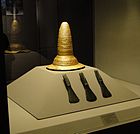


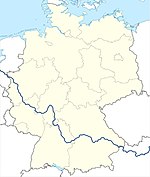




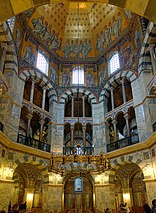
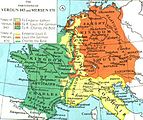
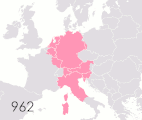





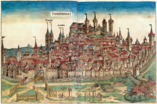








![Hans Memling's religious works often incorporated donor portraits of the clergymen, aristocrats, and burghers (bankers, merchants, and politicians) who were his patrons[120]](https://upload.wikimedia.org/wikipedia/commons/thumb/3/3c/Memling30.jpg/110px-Memling30.jpg)
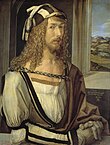


![Adam Ries is known as the "father of modern calculating" because of his decisive contribution to the recognition that Roman numerals are unpractical and to their replacement by the considerably more practical Arabic numerals.[121]](https://upload.wikimedia.org/wikipedia/commons/thumb/1/1f/Ries.PNG/110px-Ries.PNG)
![Georgius Agricola was the first to drop the Arabic definite article al-, exclusively writing chymia and chymista describing chemistry.[122][123] He is generally referred to as the father of mineralogy and the founder of geology as a scientific discipline.[124][123]](https://upload.wikimedia.org/wikipedia/commons/thumb/6/63/Georgius_Agricola.jpg/110px-Georgius_Agricola.jpg)
![Hans Holbein the Younger is considered one of the greatest portraitists of the 16th century.[125]](https://upload.wikimedia.org/wikipedia/commons/thumb/d/d7/Hans_Holbein_the_Younger%2C_self-portrait.jpg/110px-Hans_Holbein_the_Younger%2C_self-portrait.jpg)
![Johannes Kepler, one of the founders and fathers of modern astronomy, the scientific method, natural and modern science[209][210][211]](https://upload.wikimedia.org/wikipedia/commons/thumb/7/74/JKepler.jpg/125px-JKepler.jpg)
